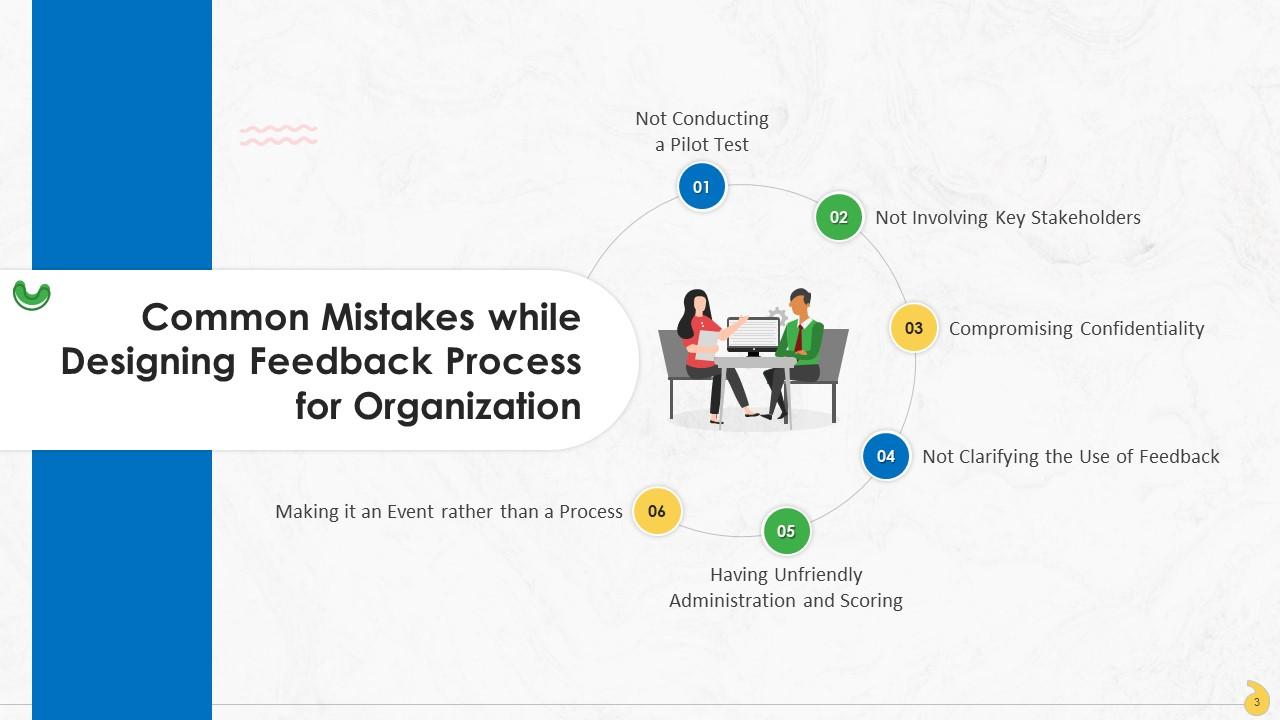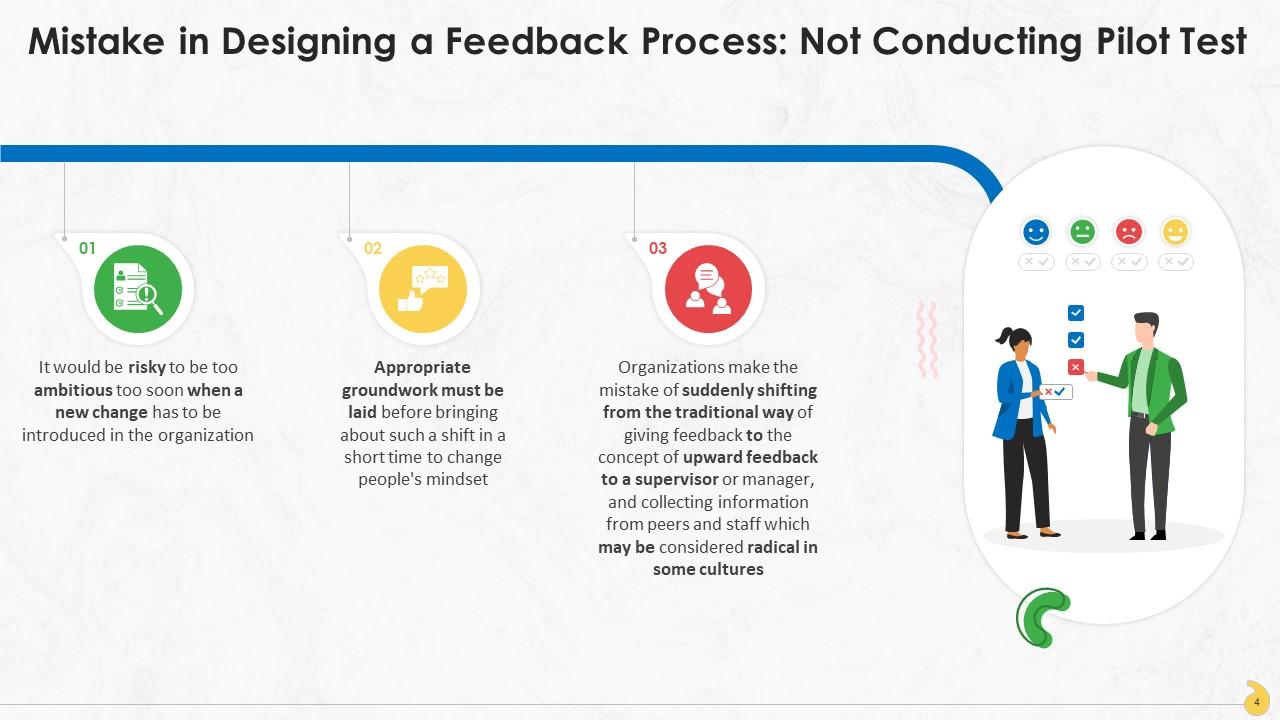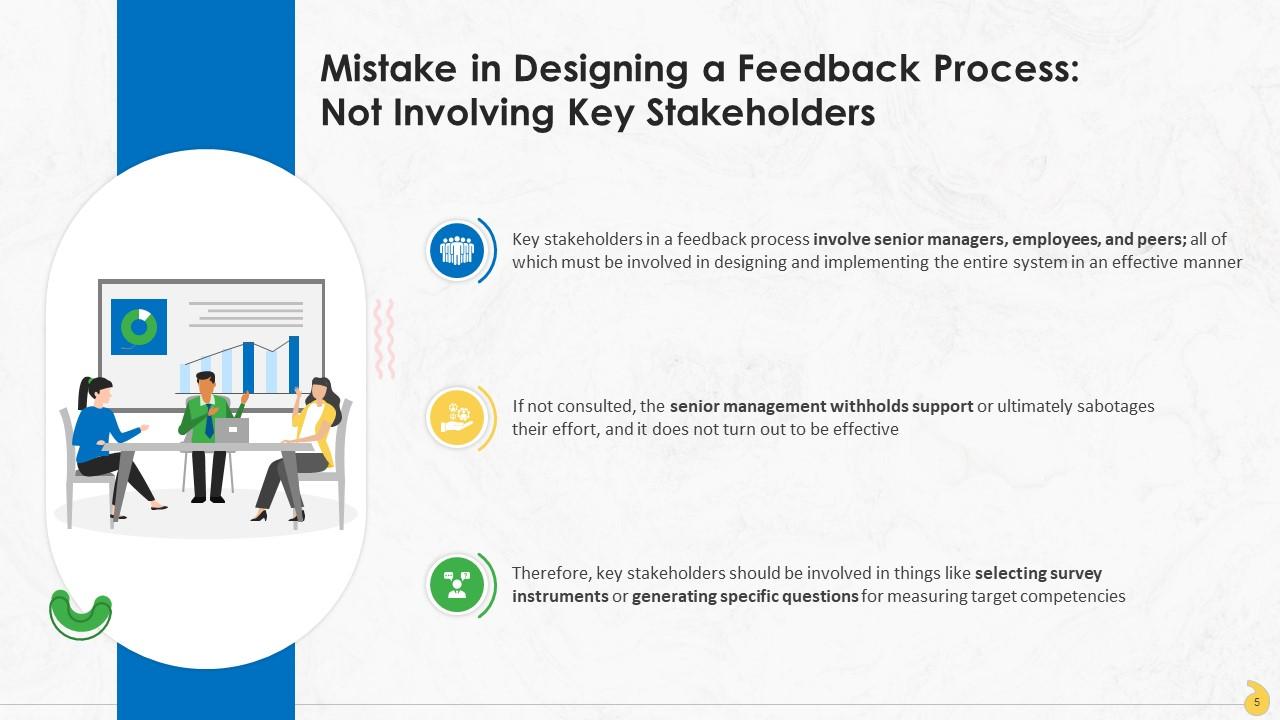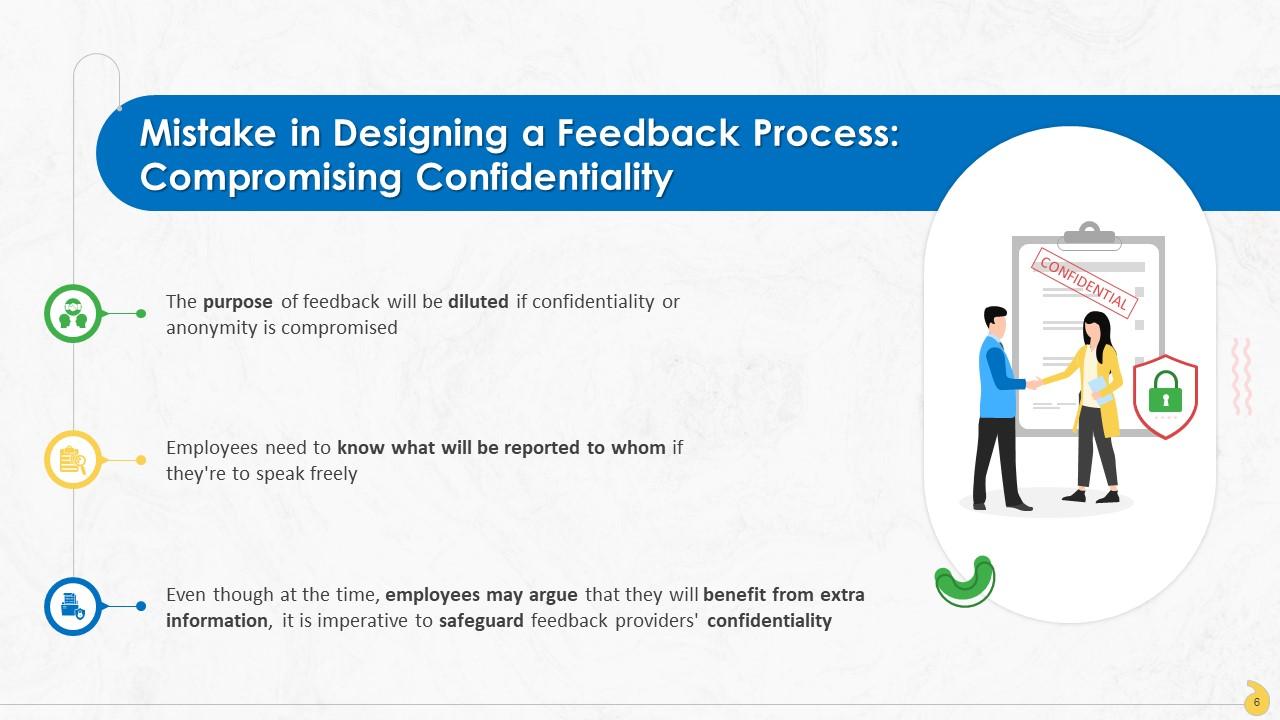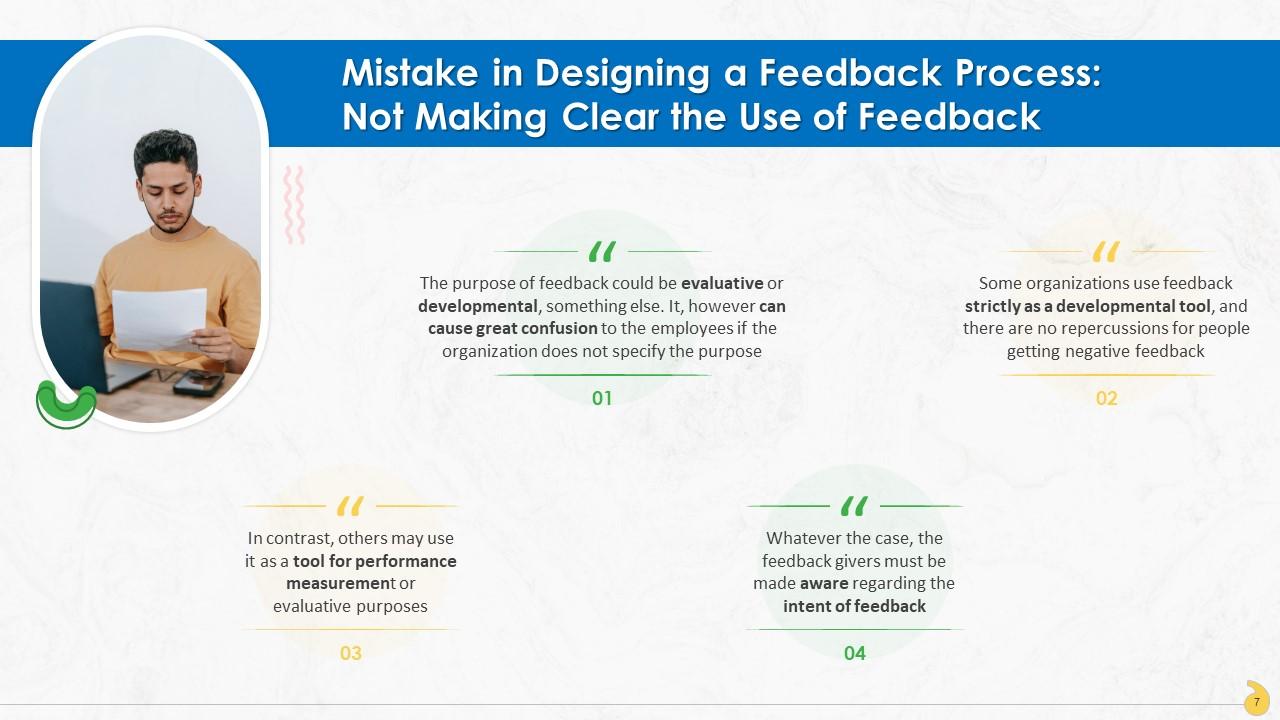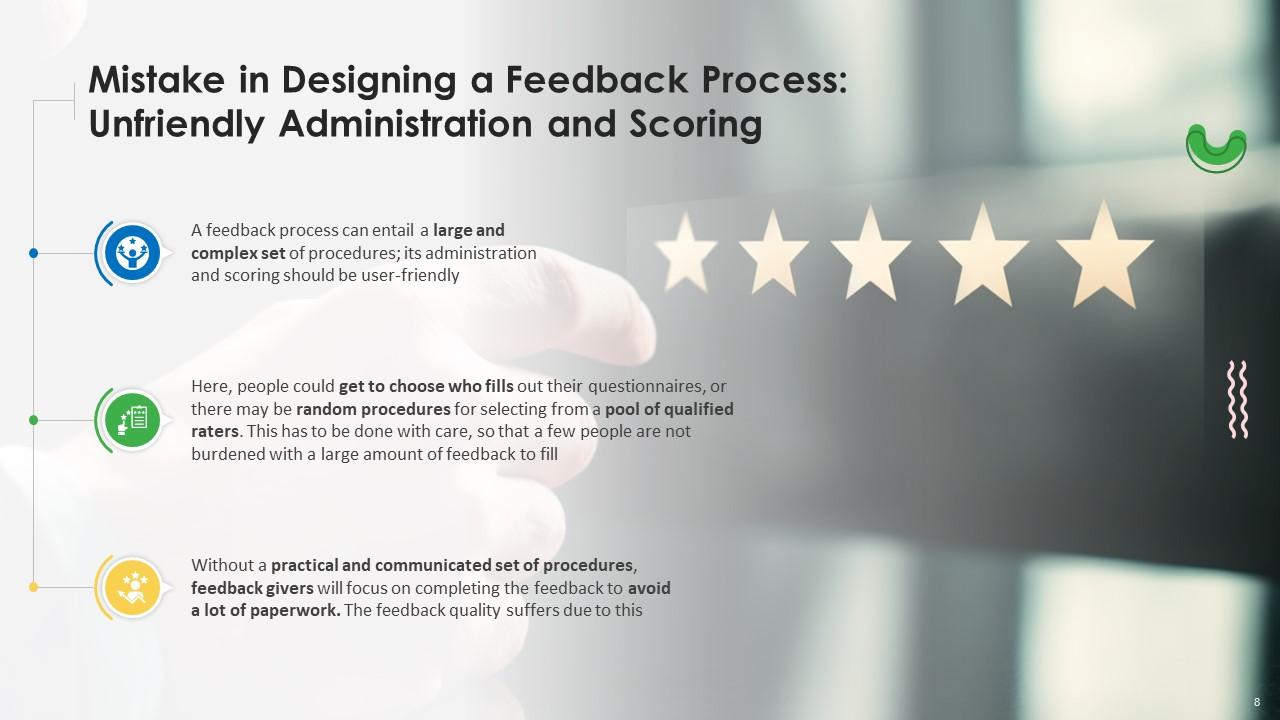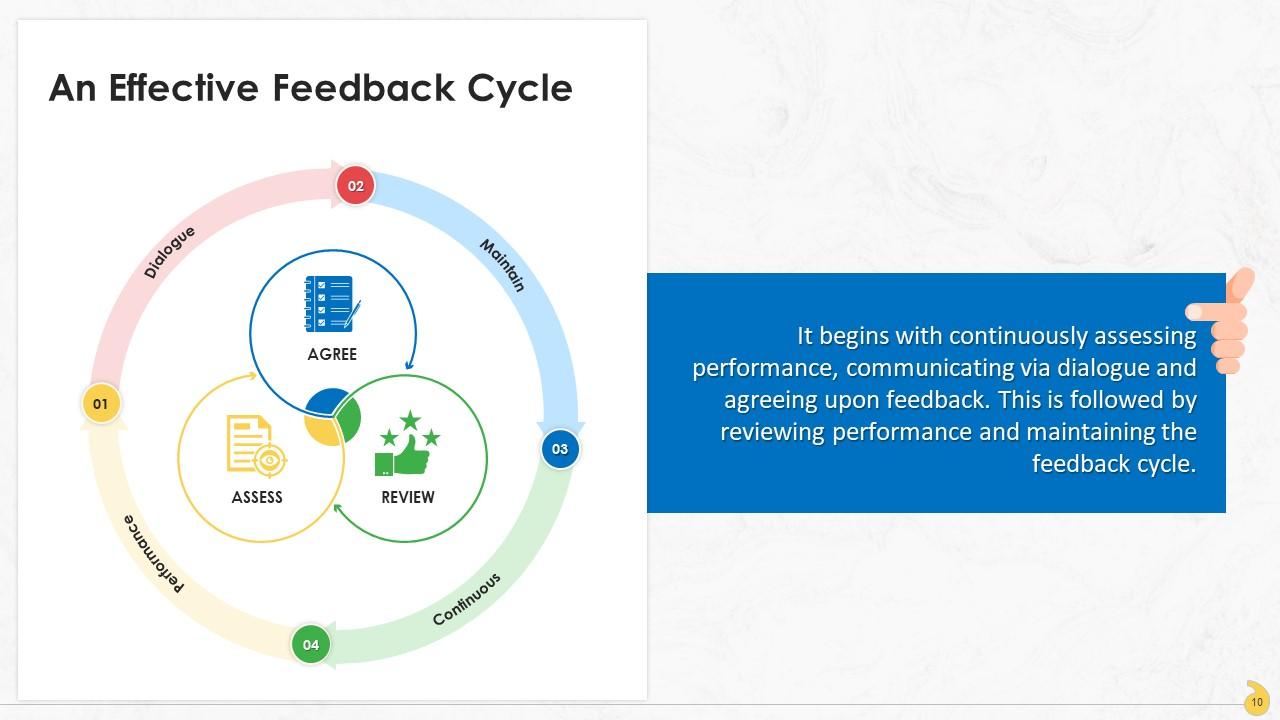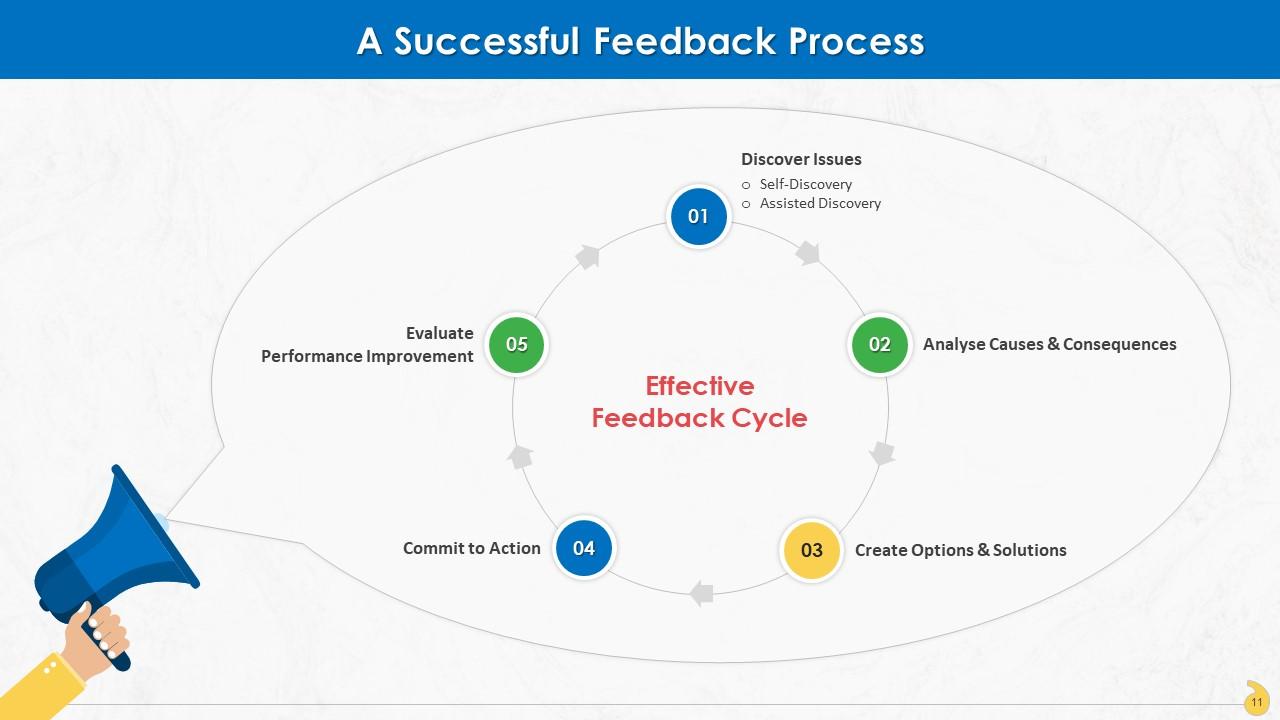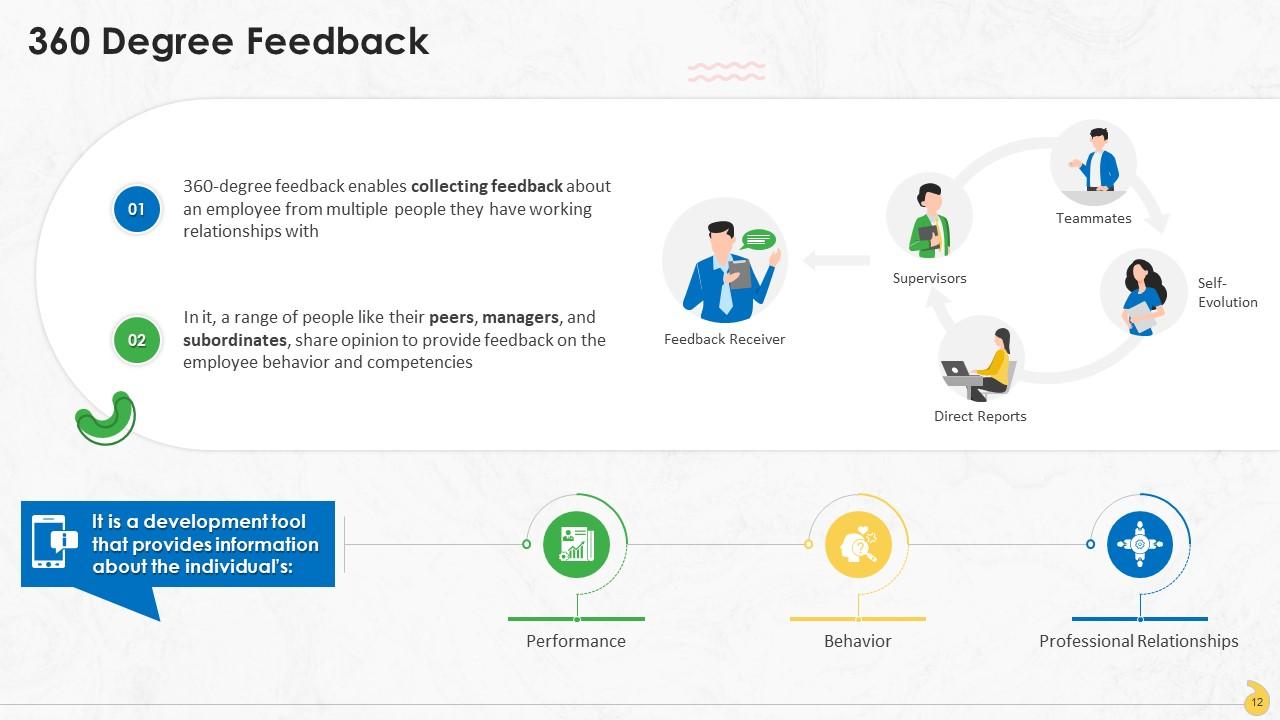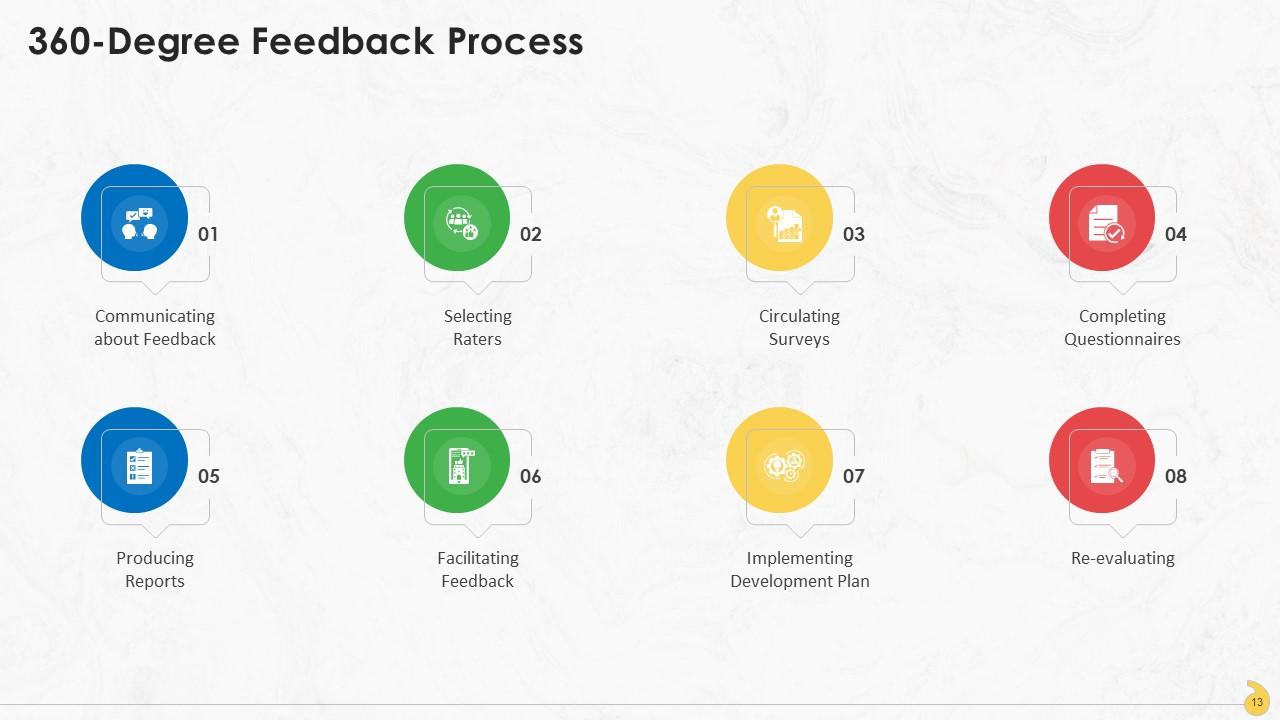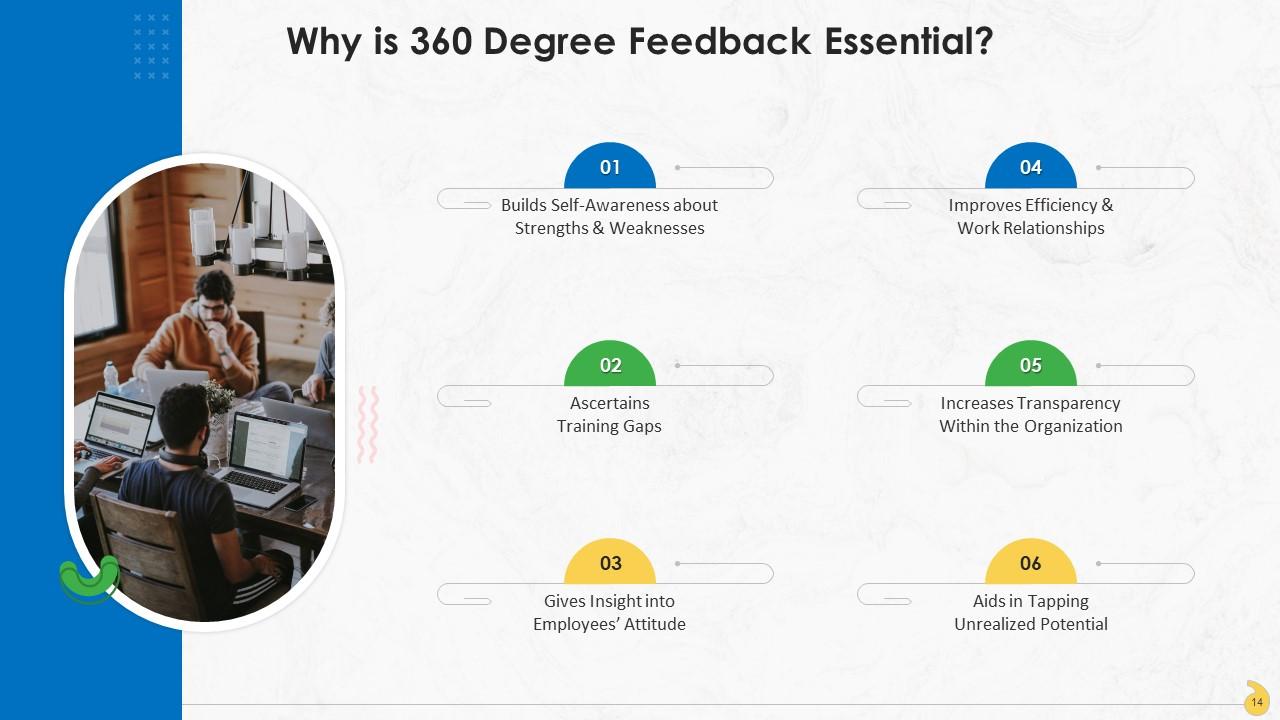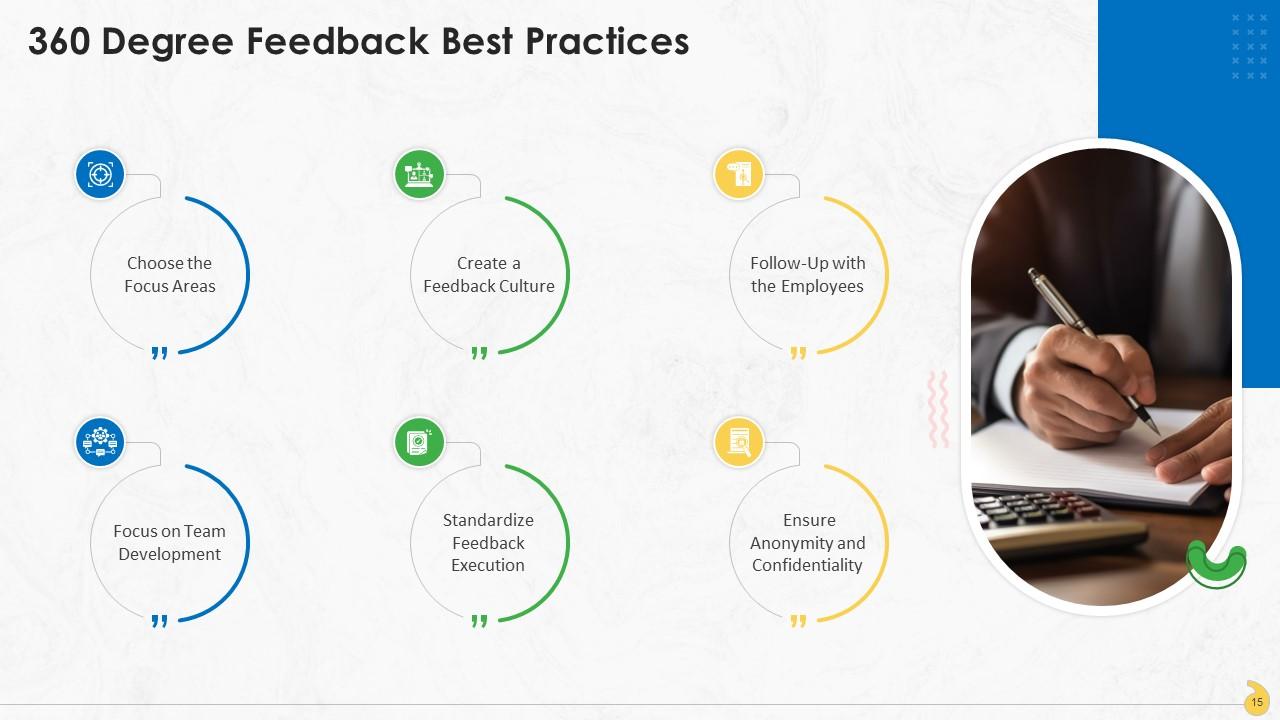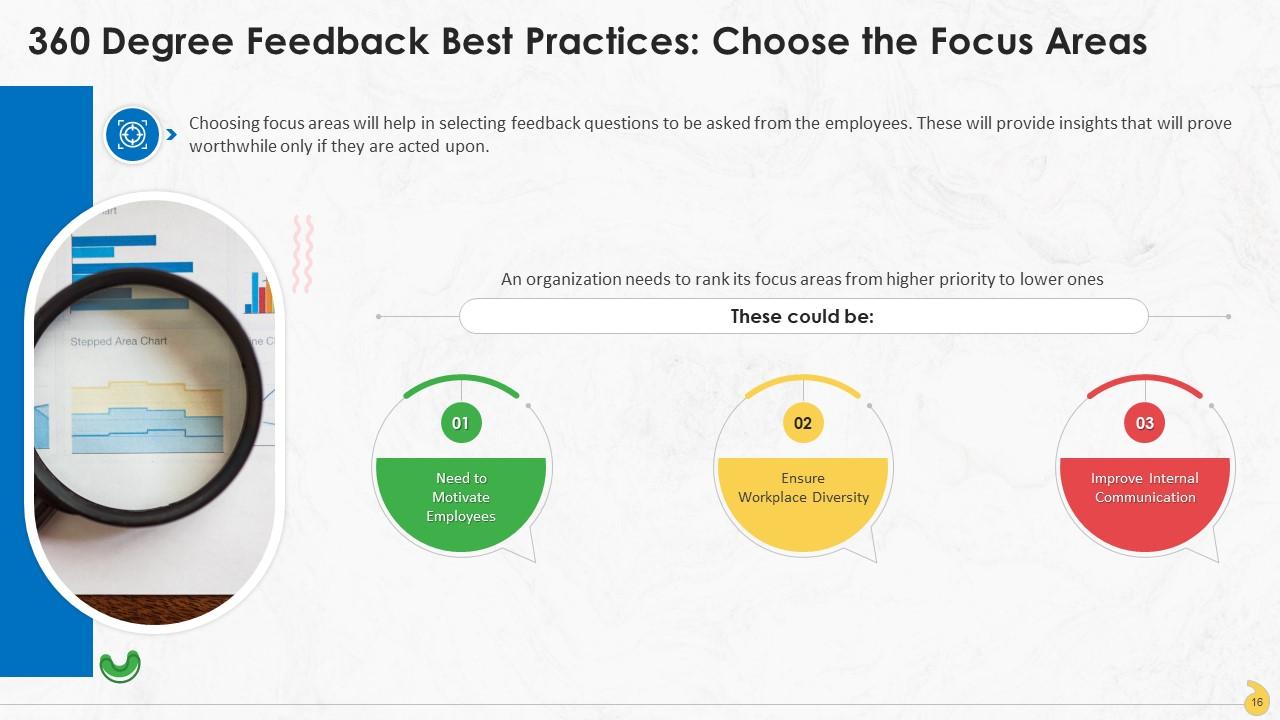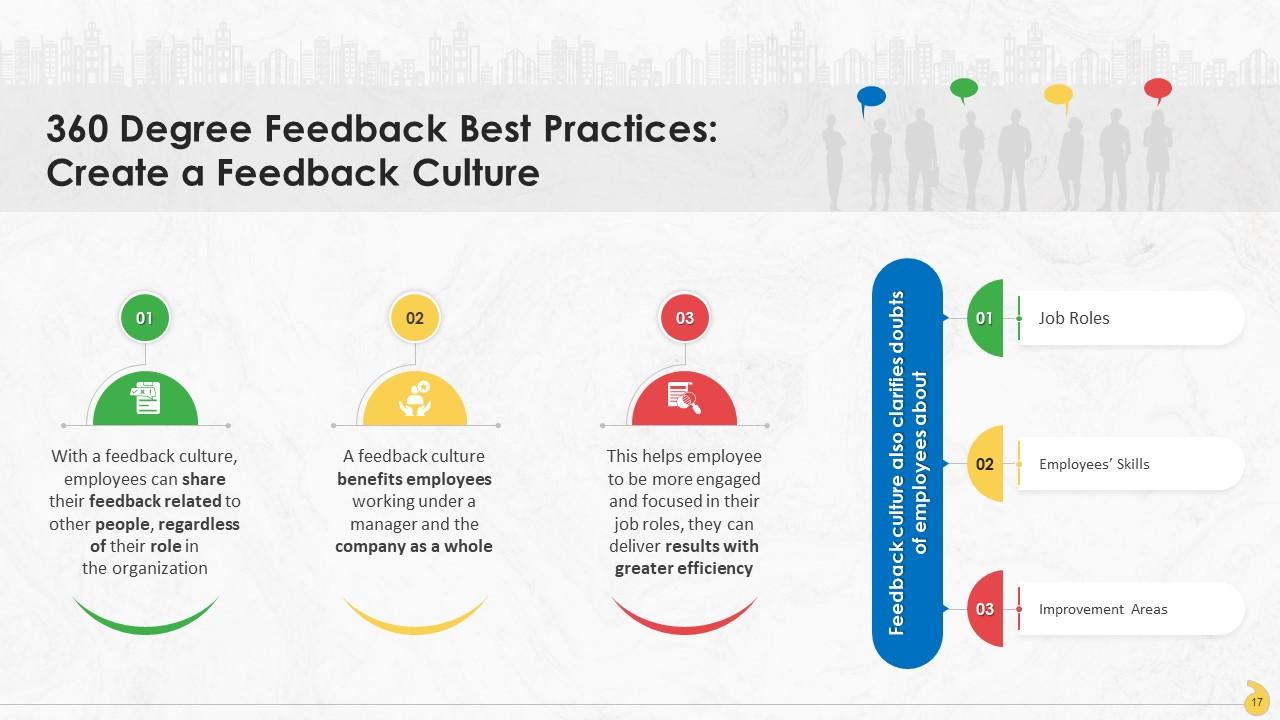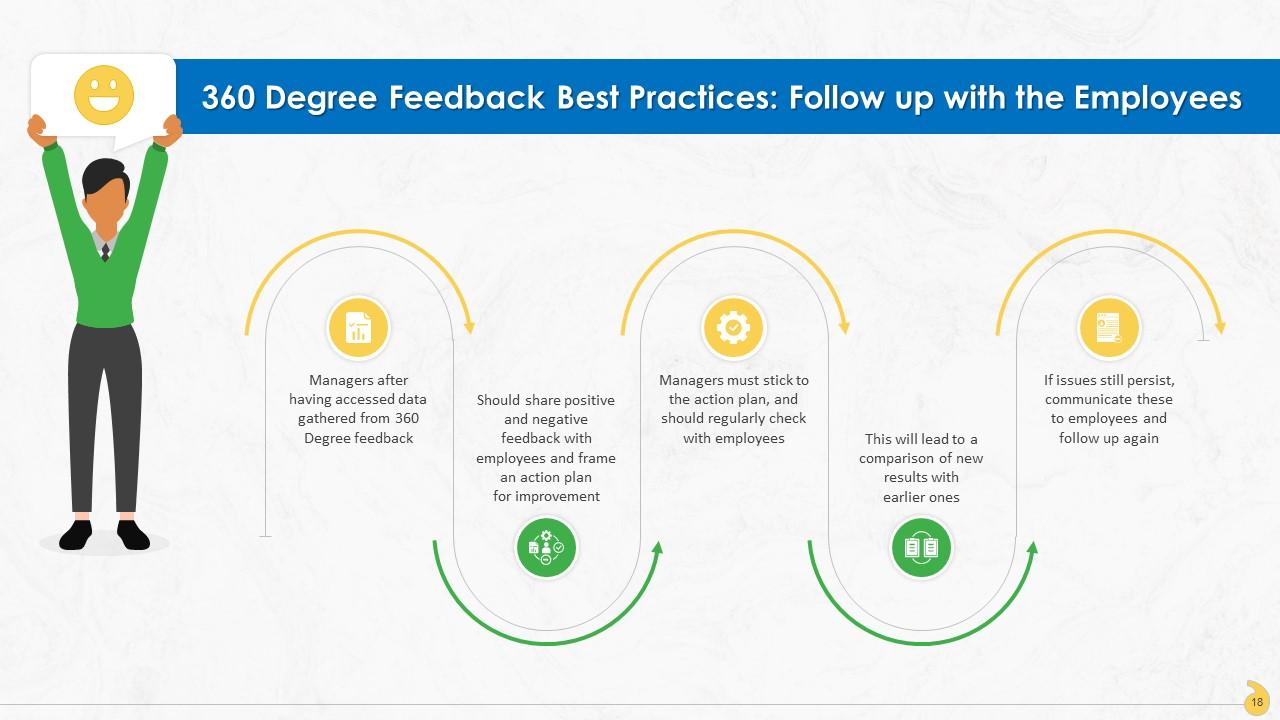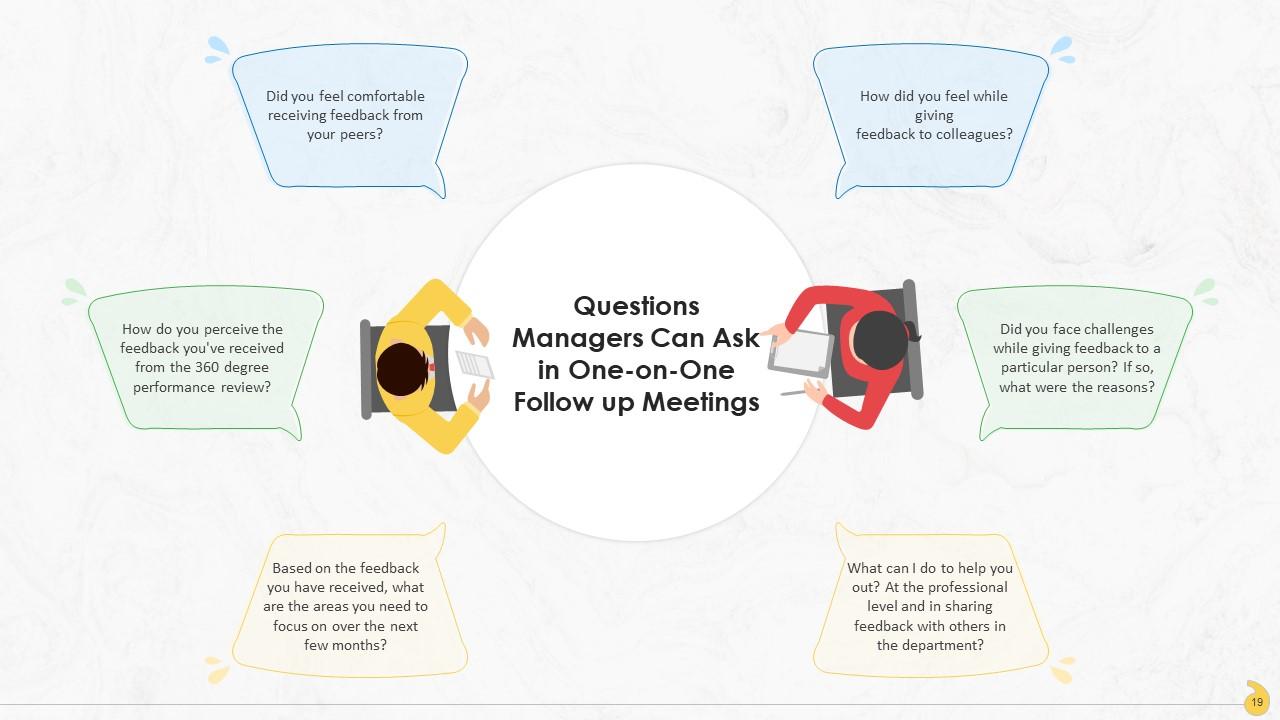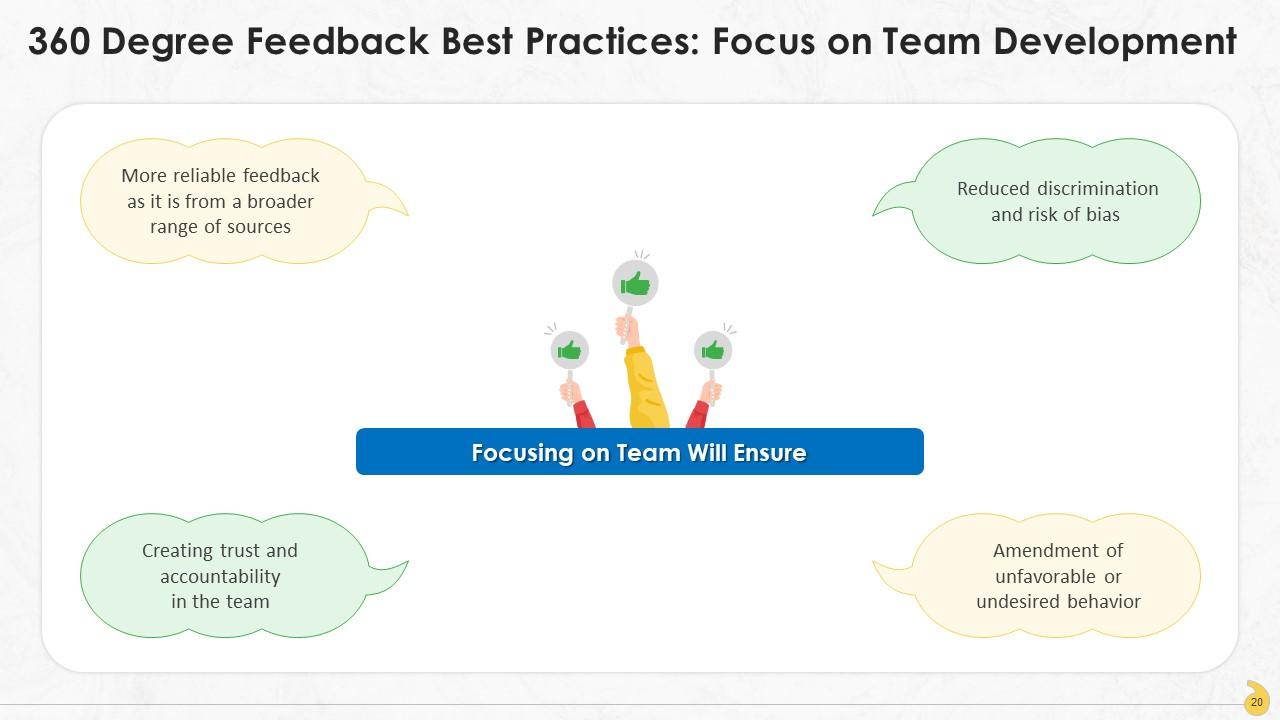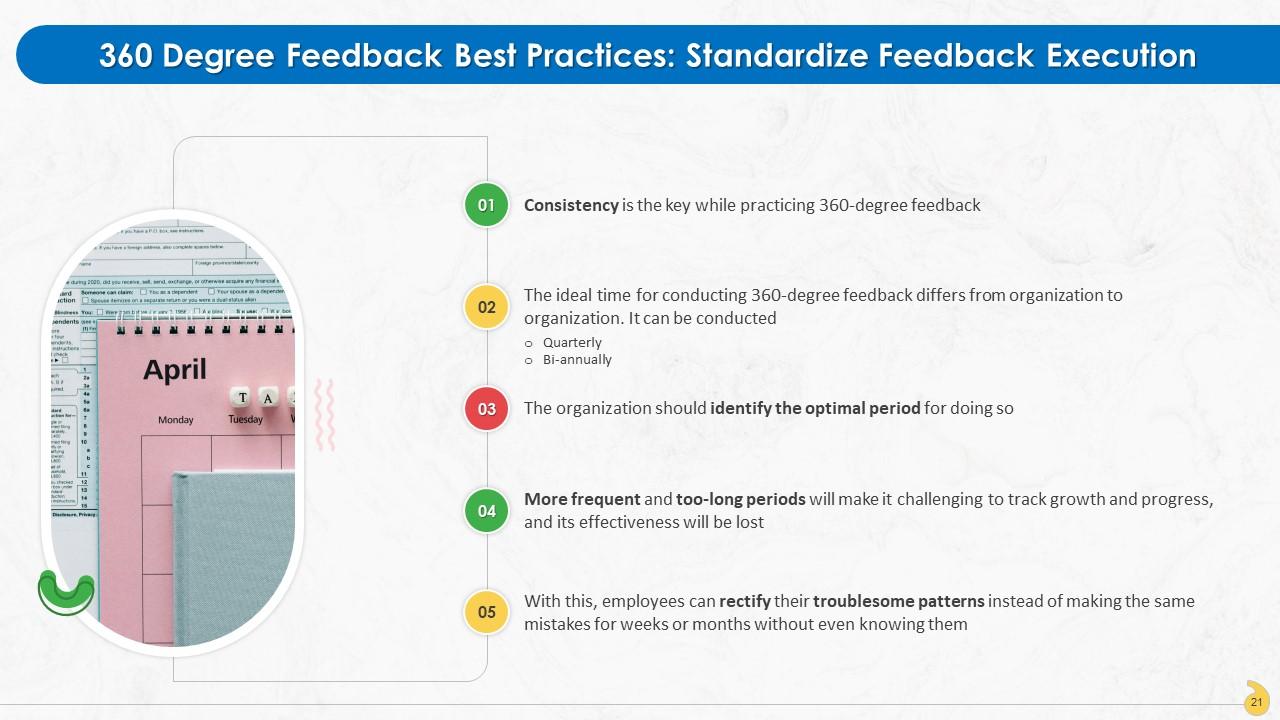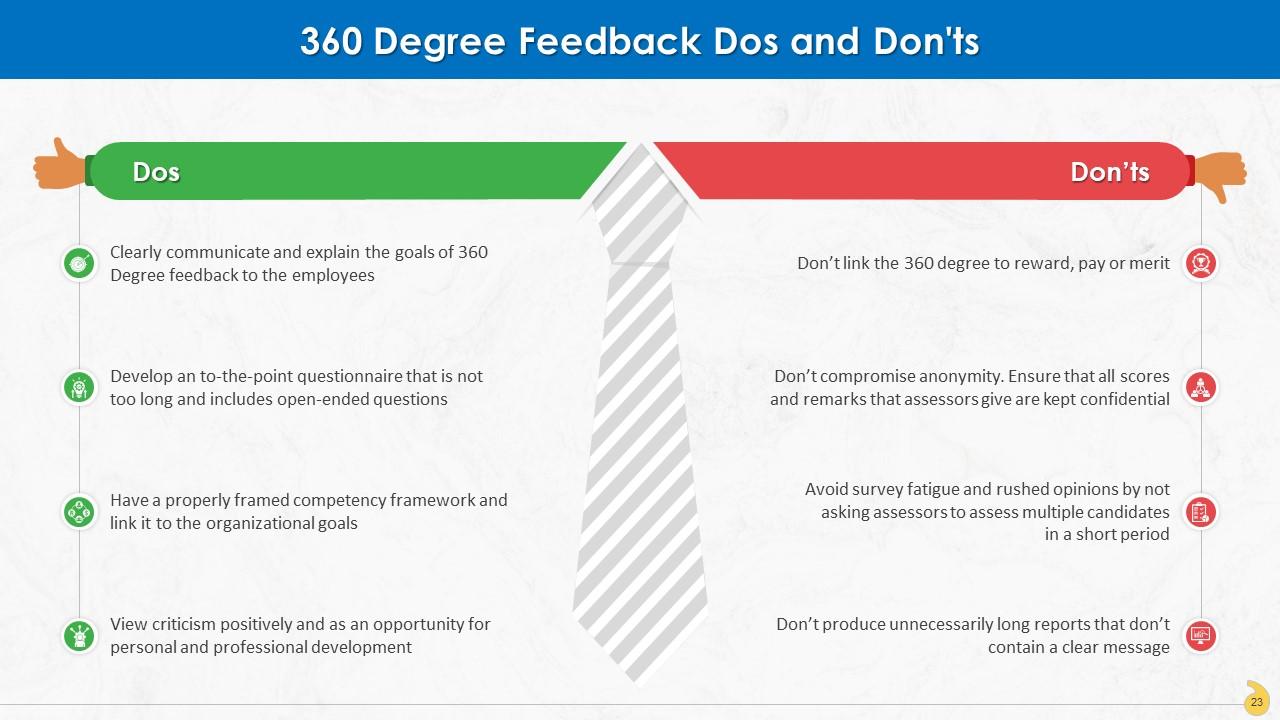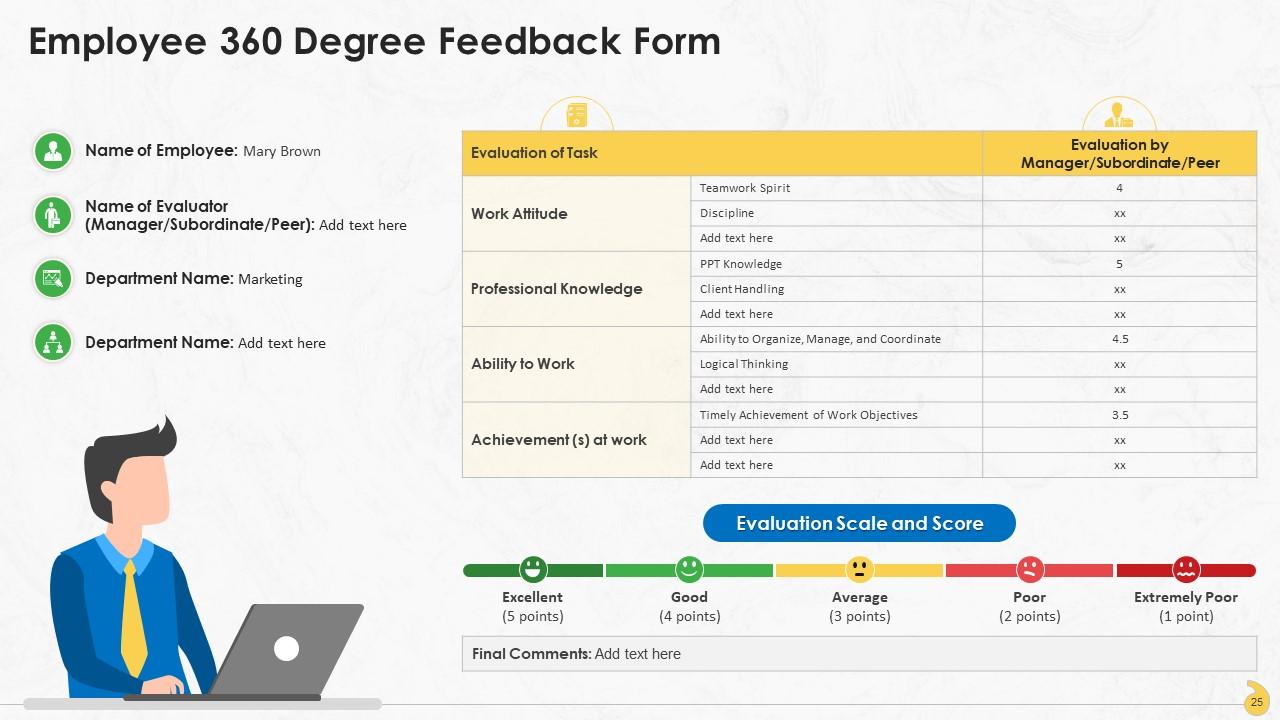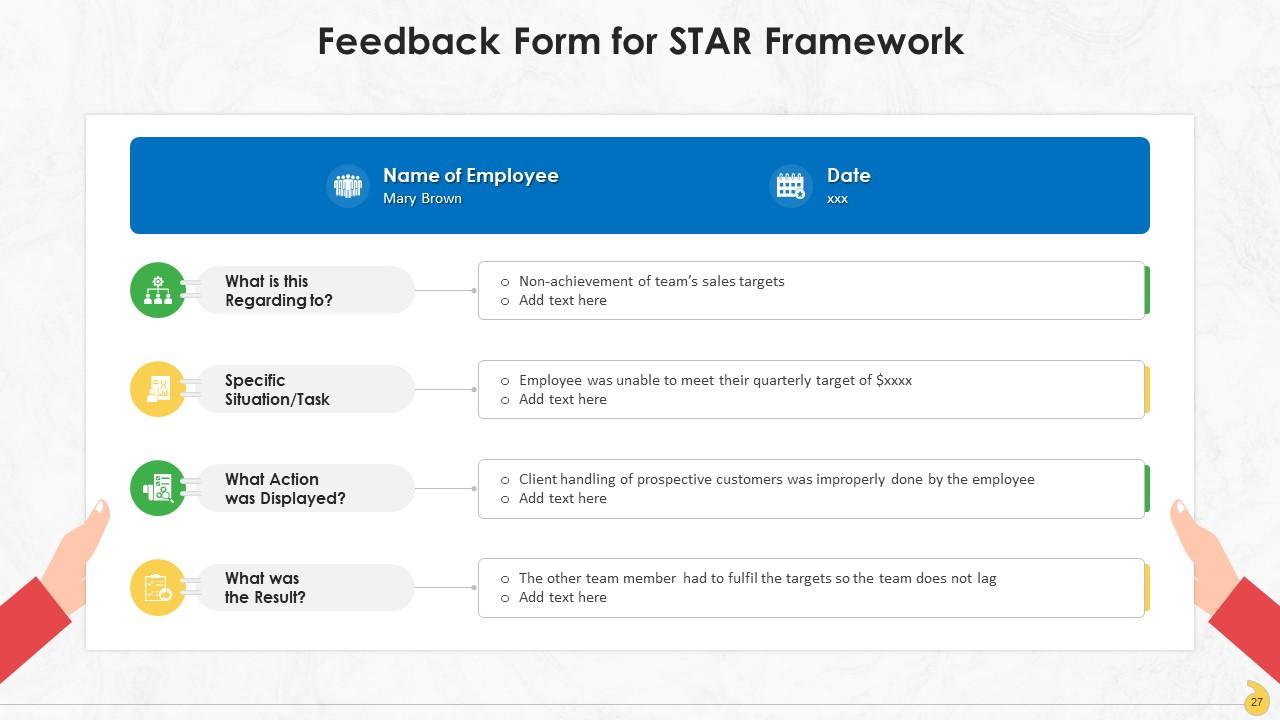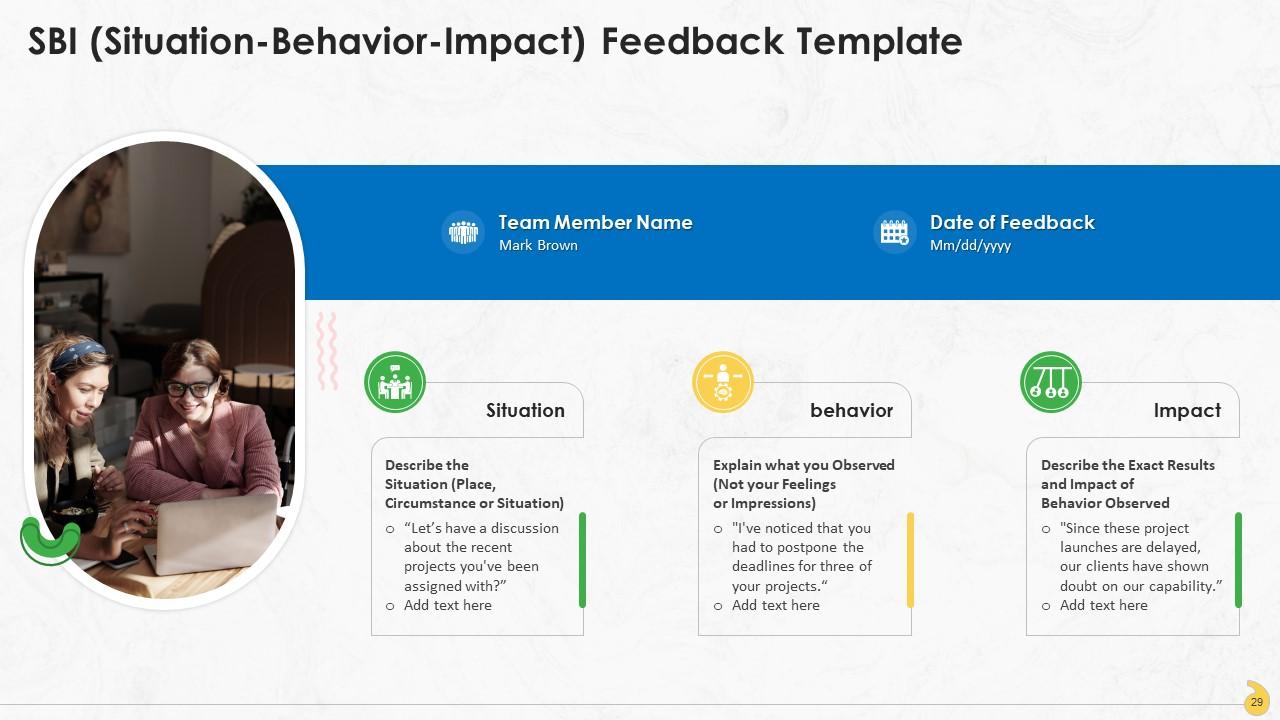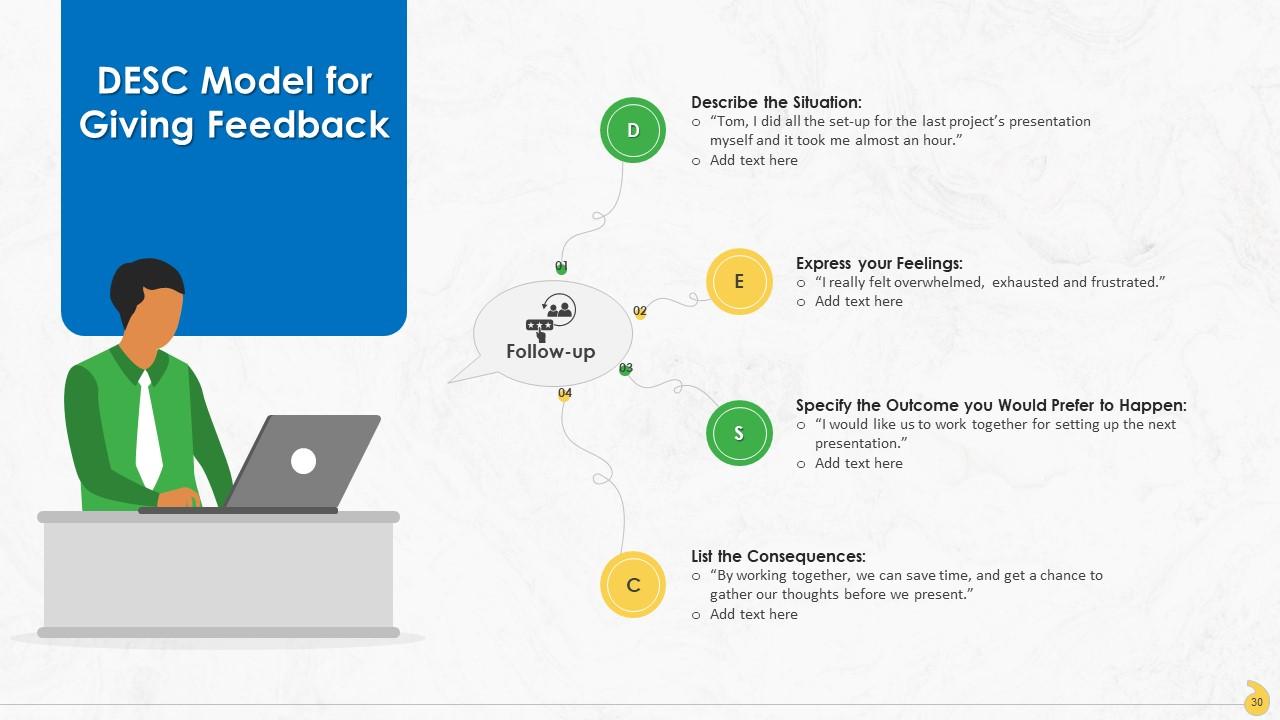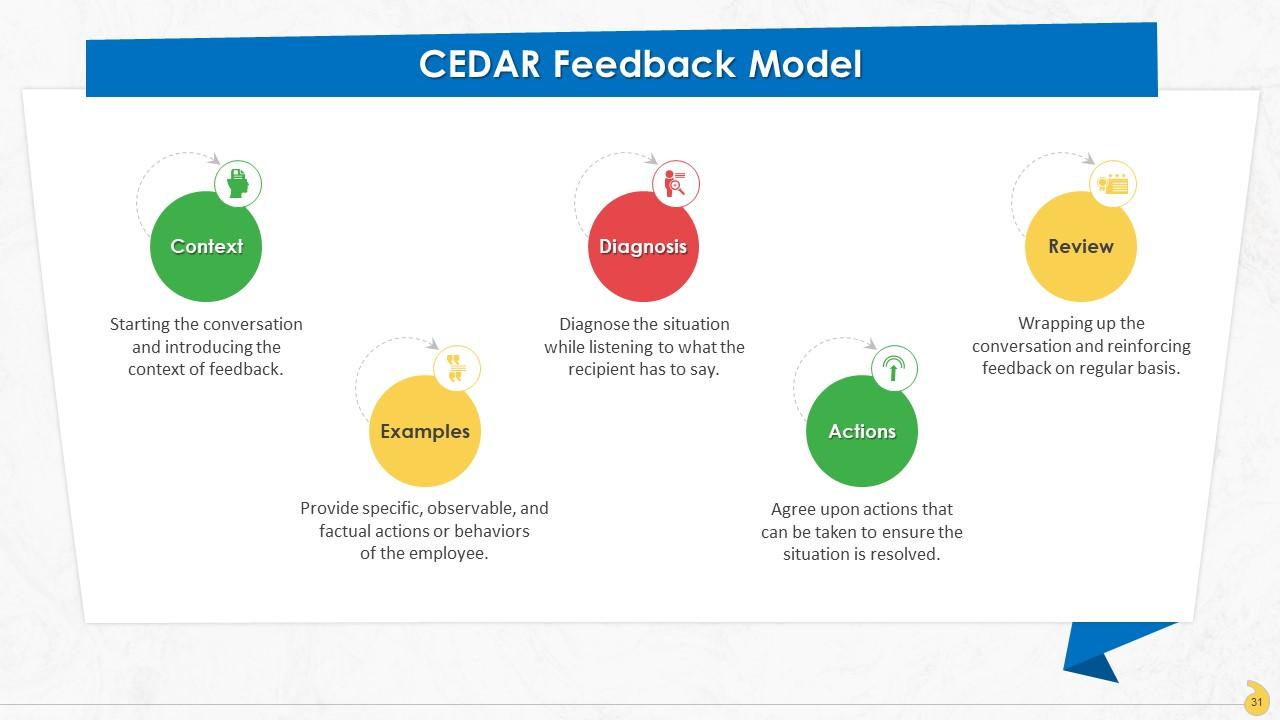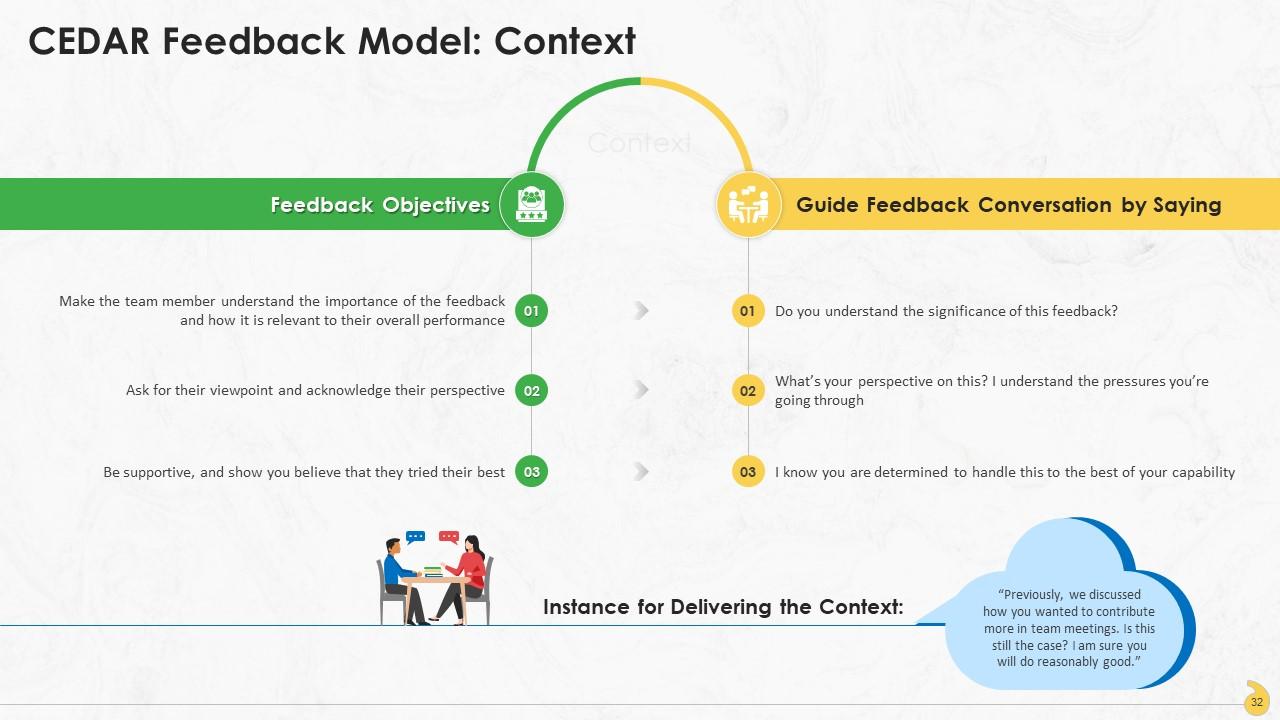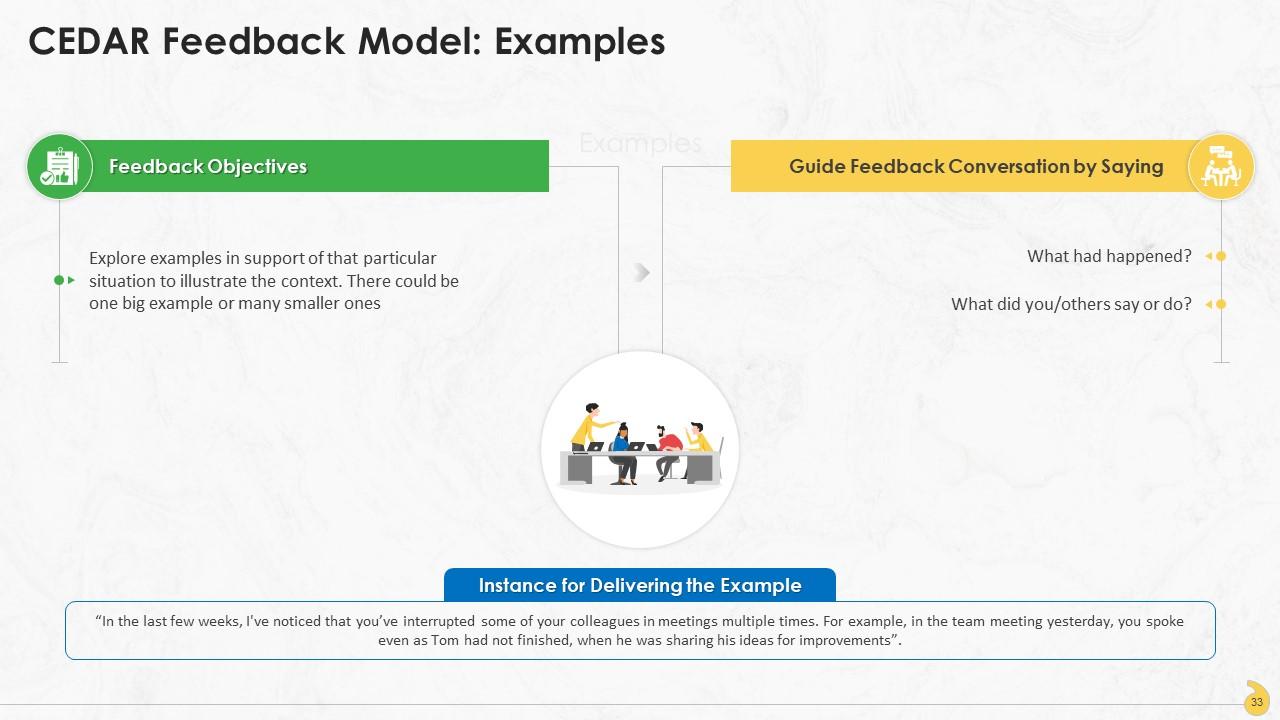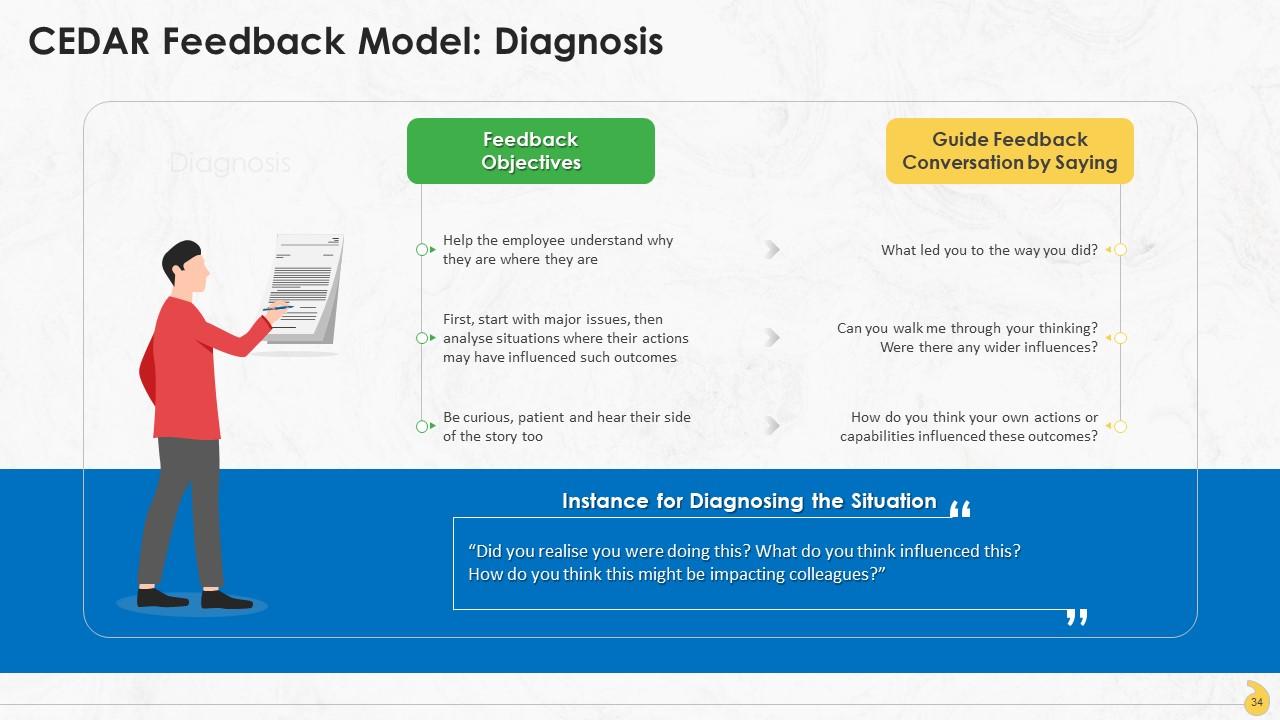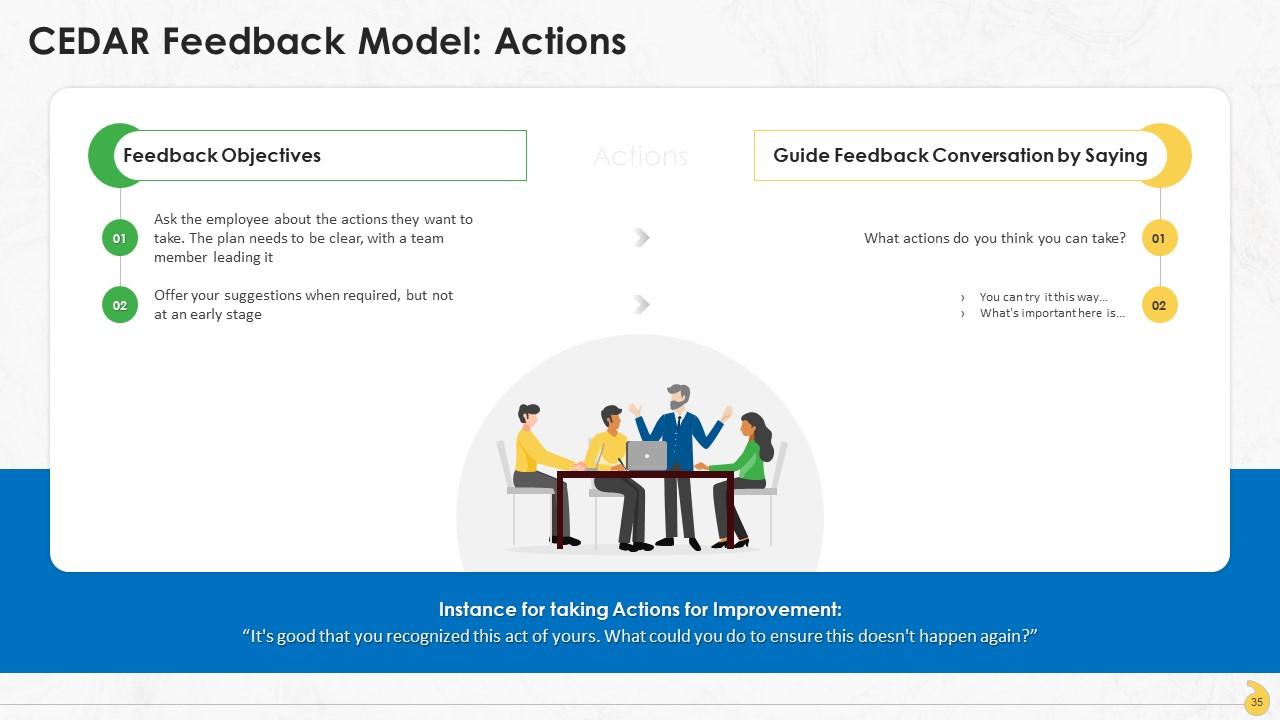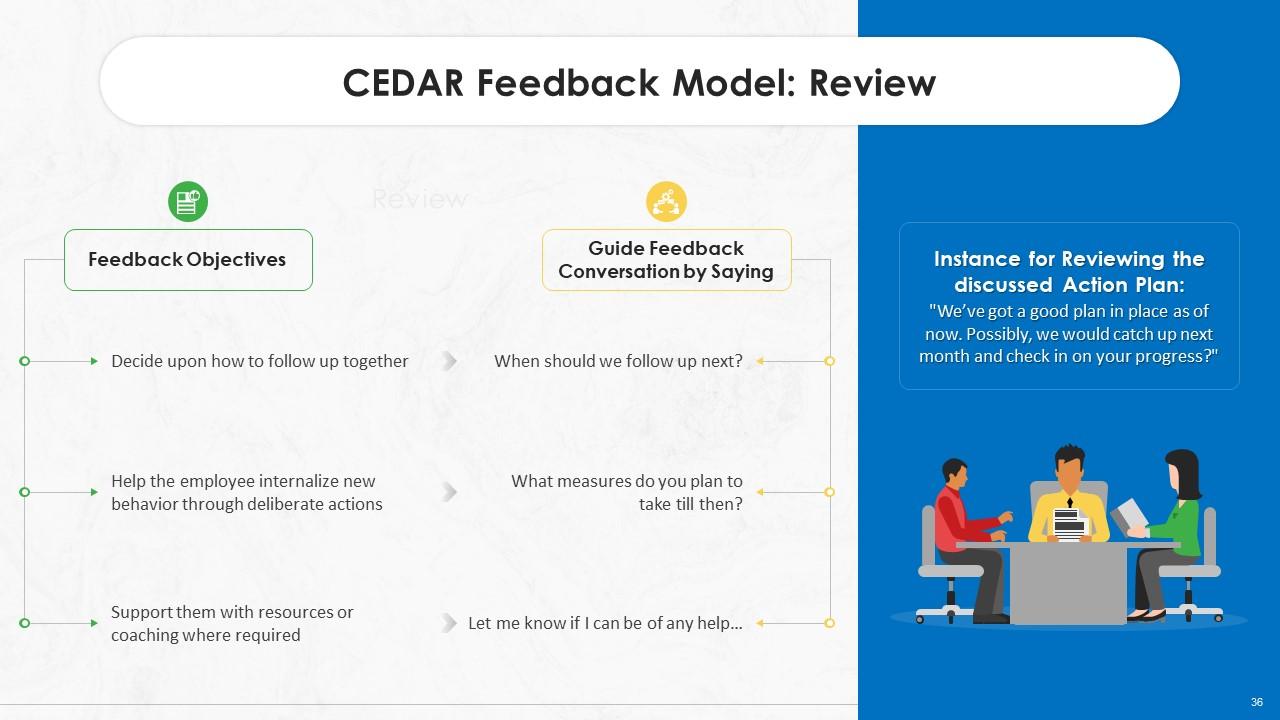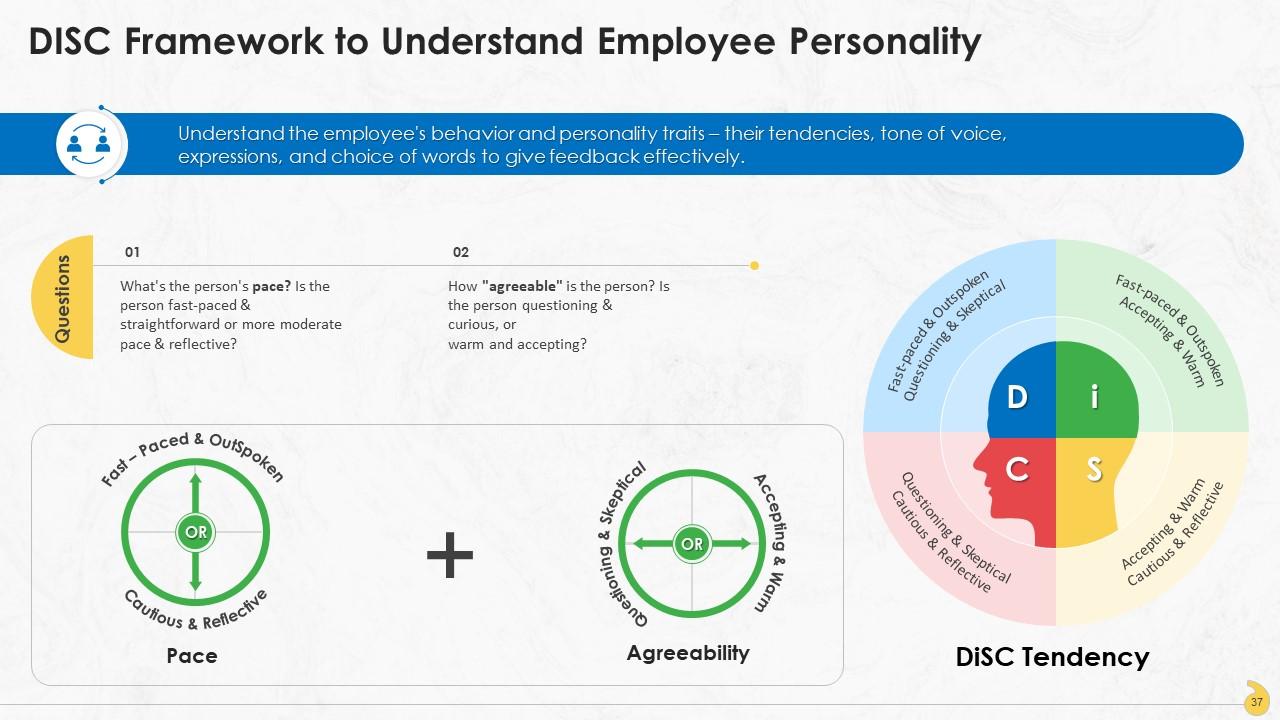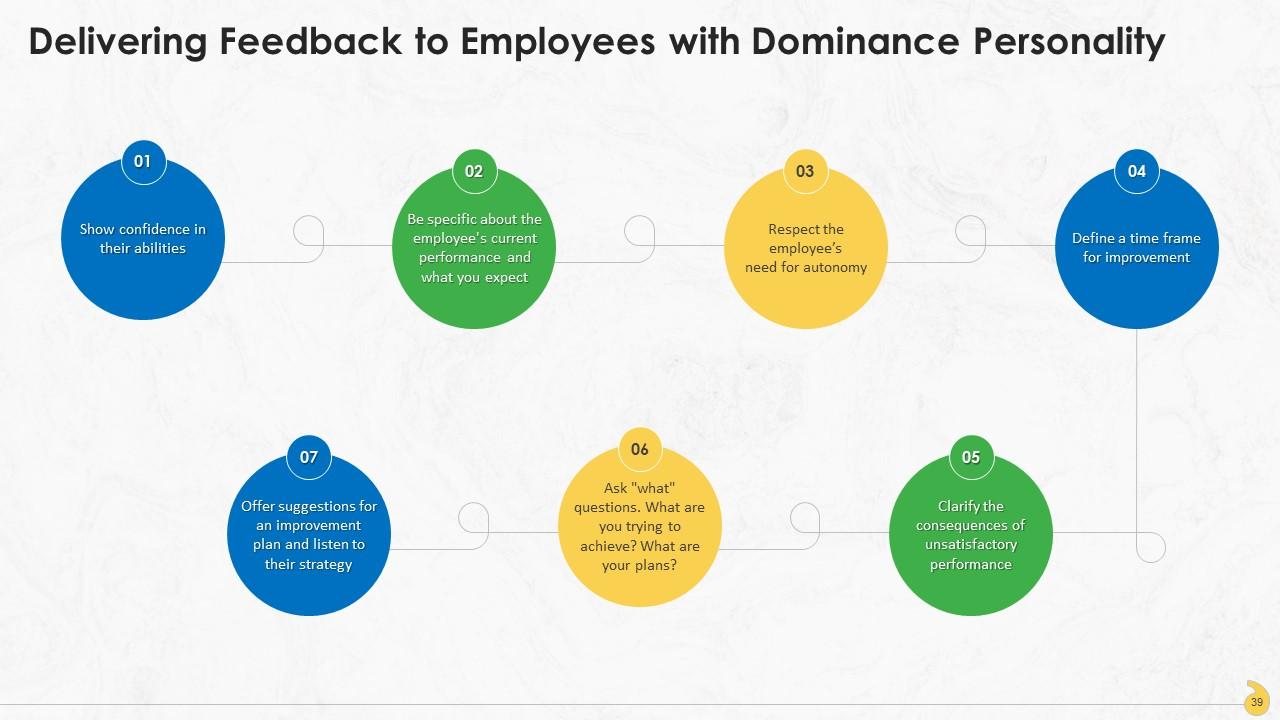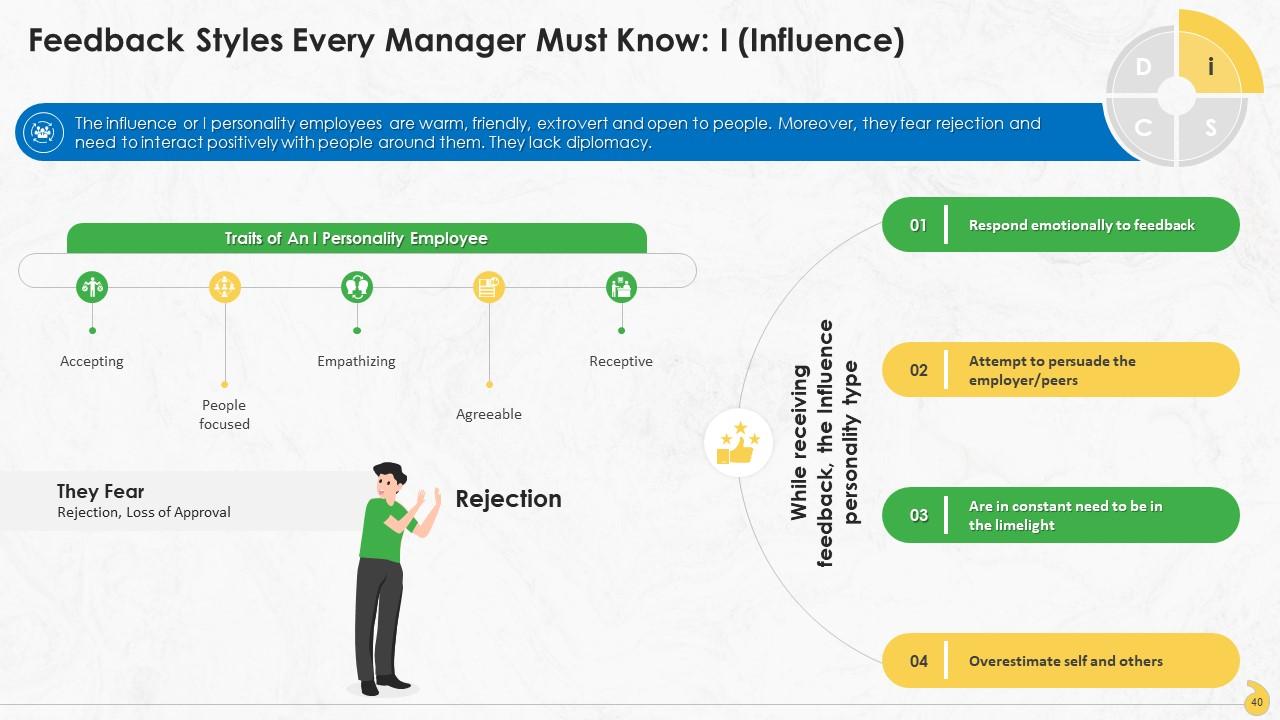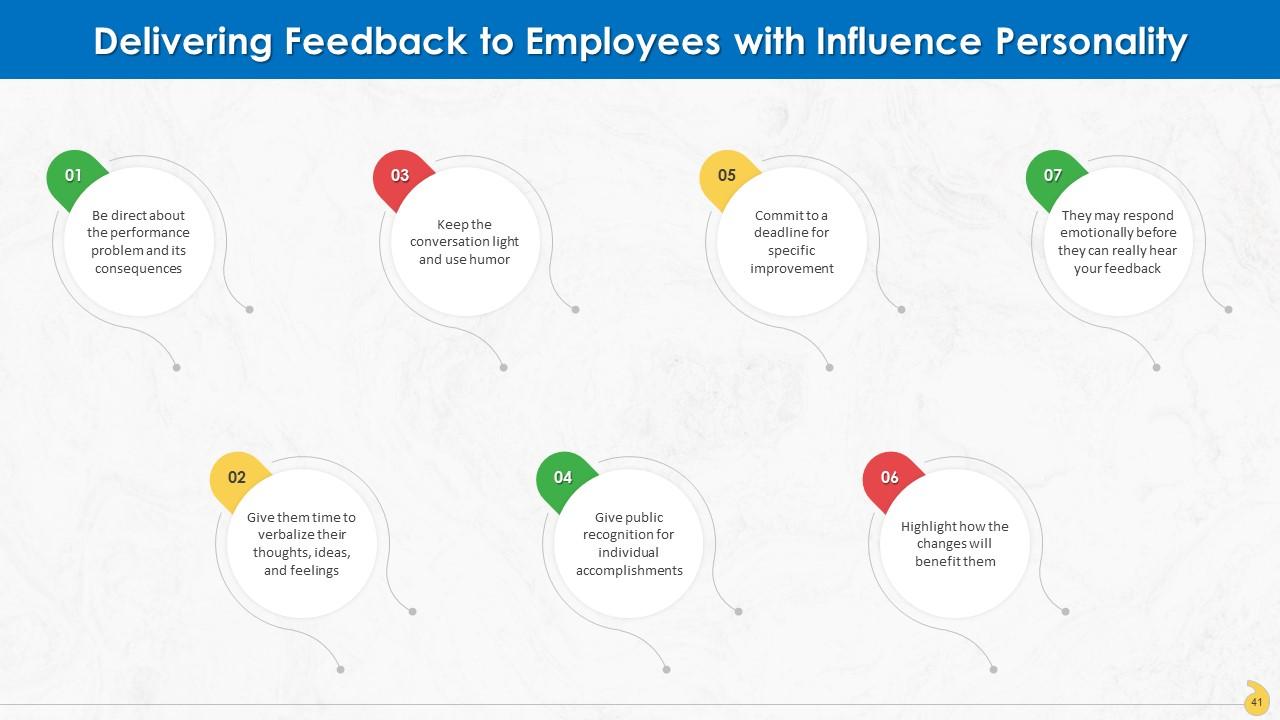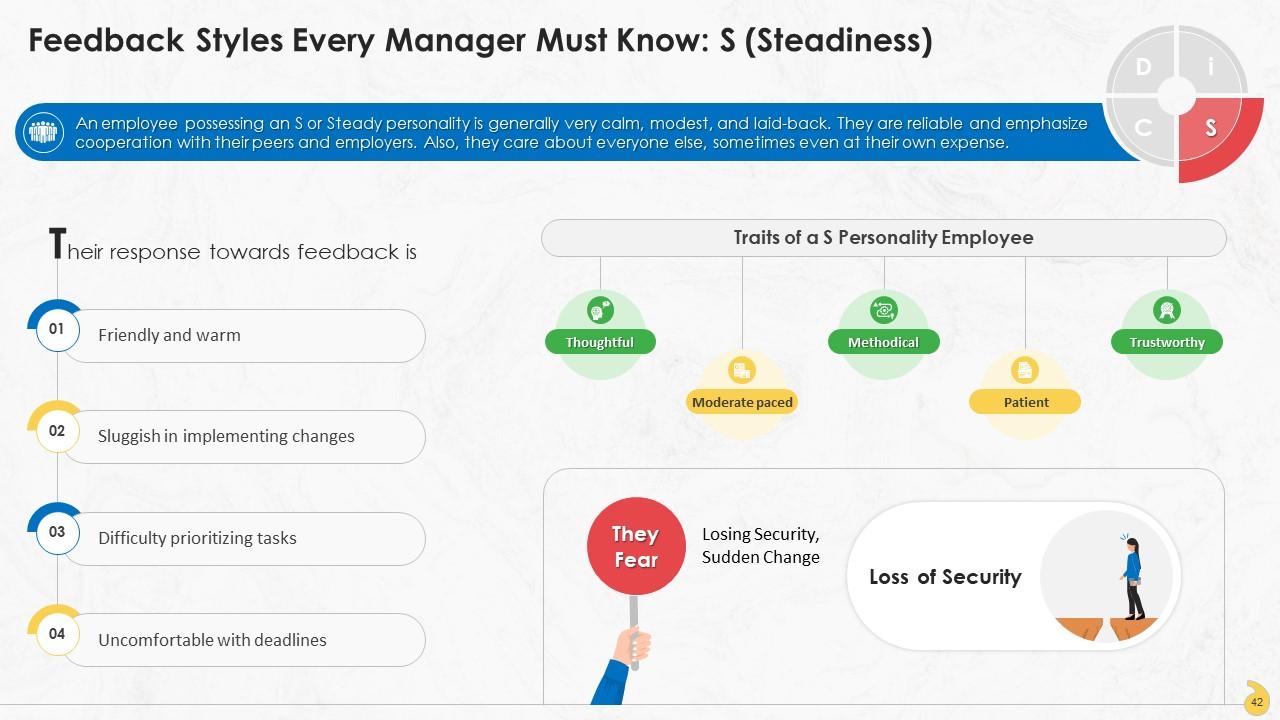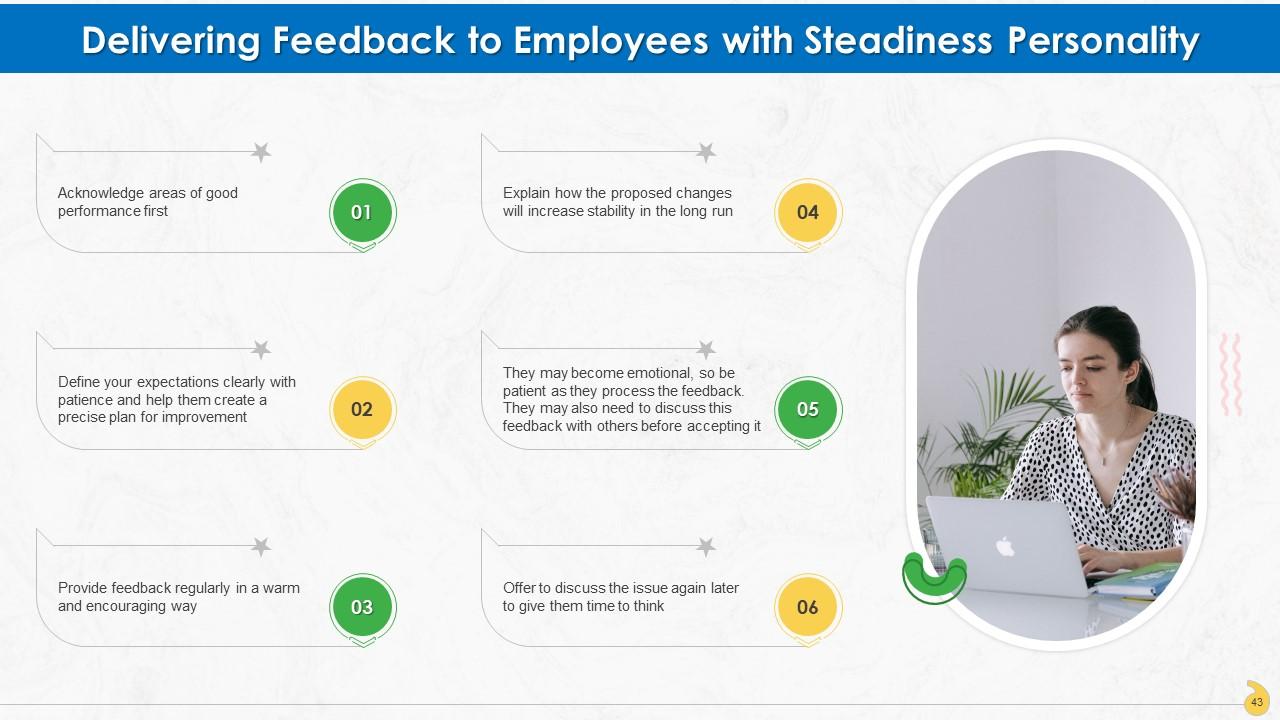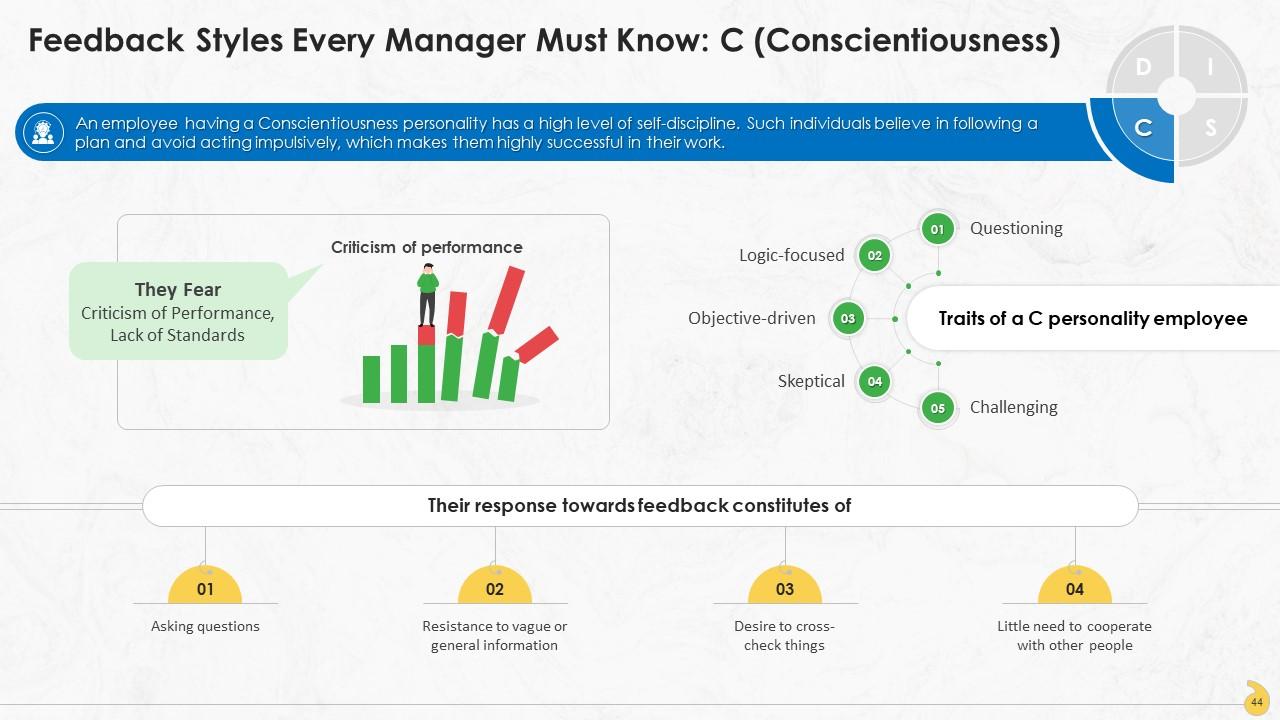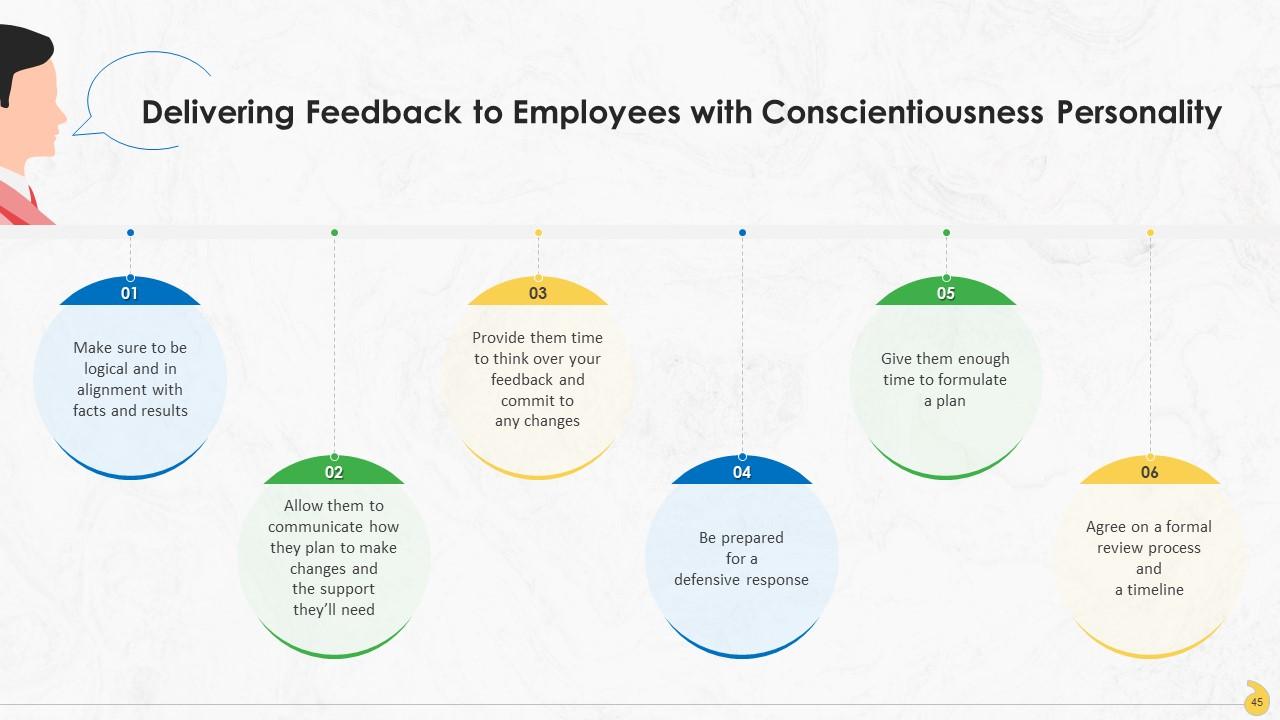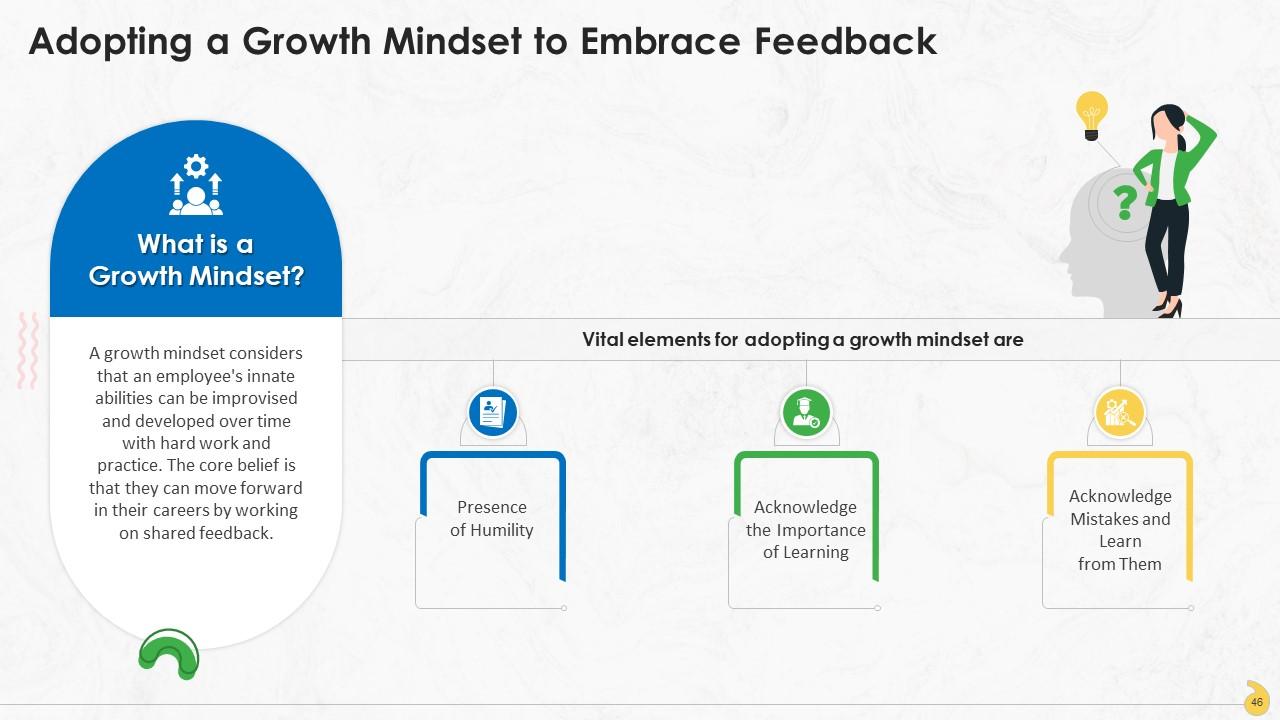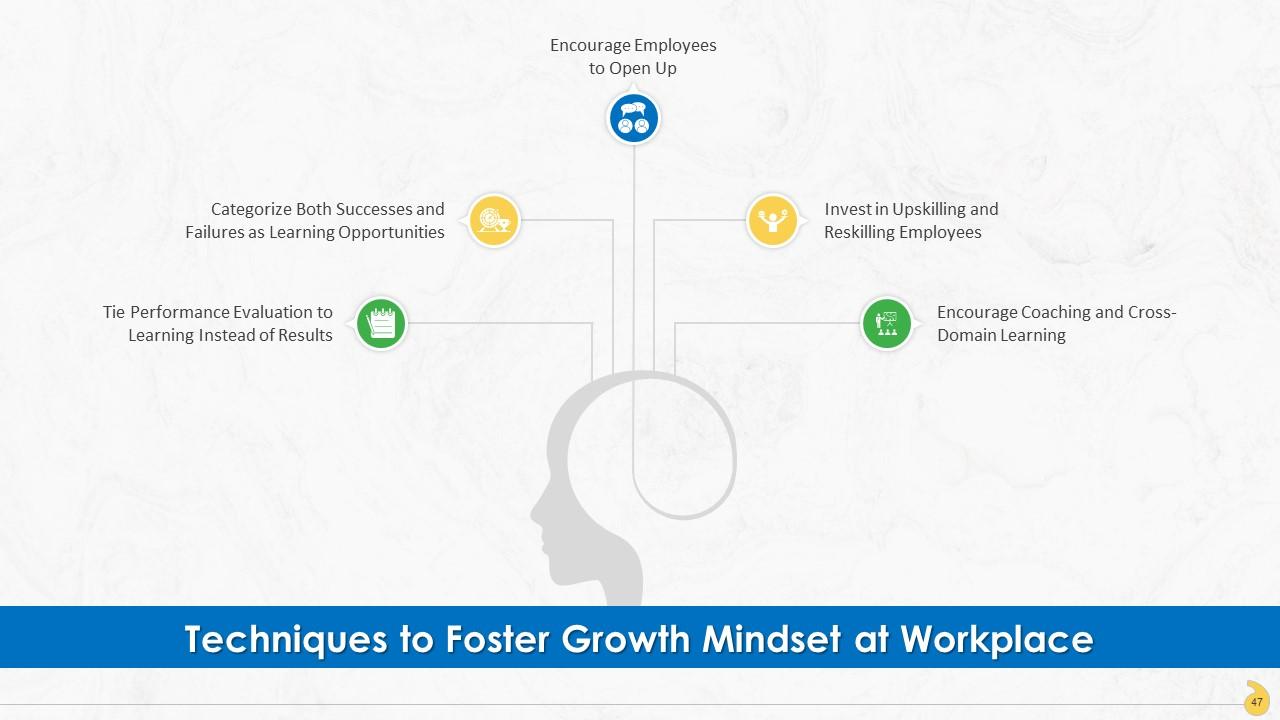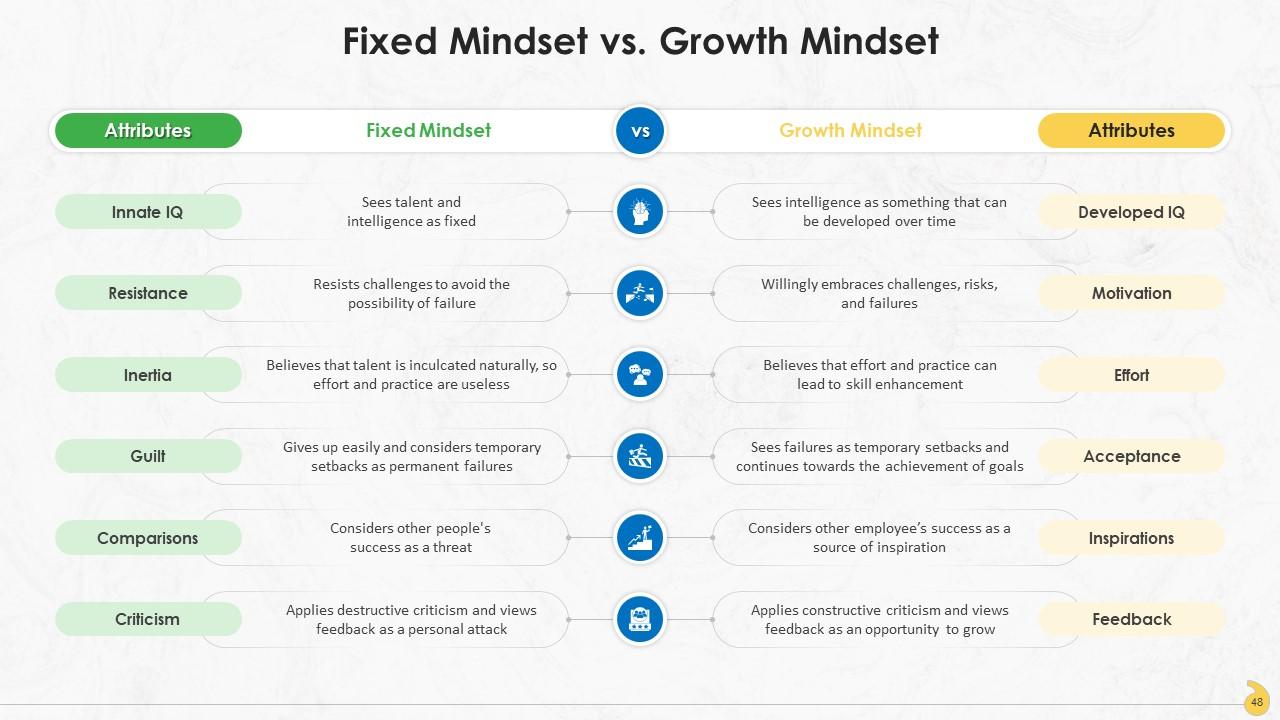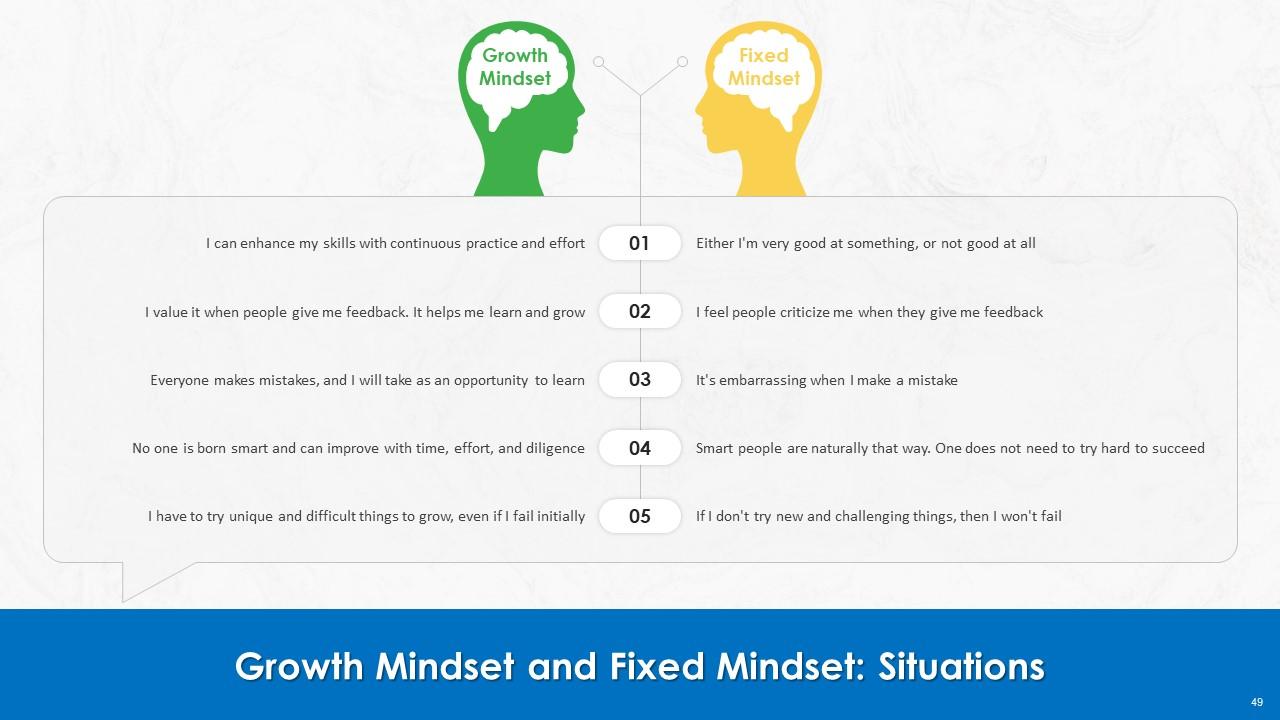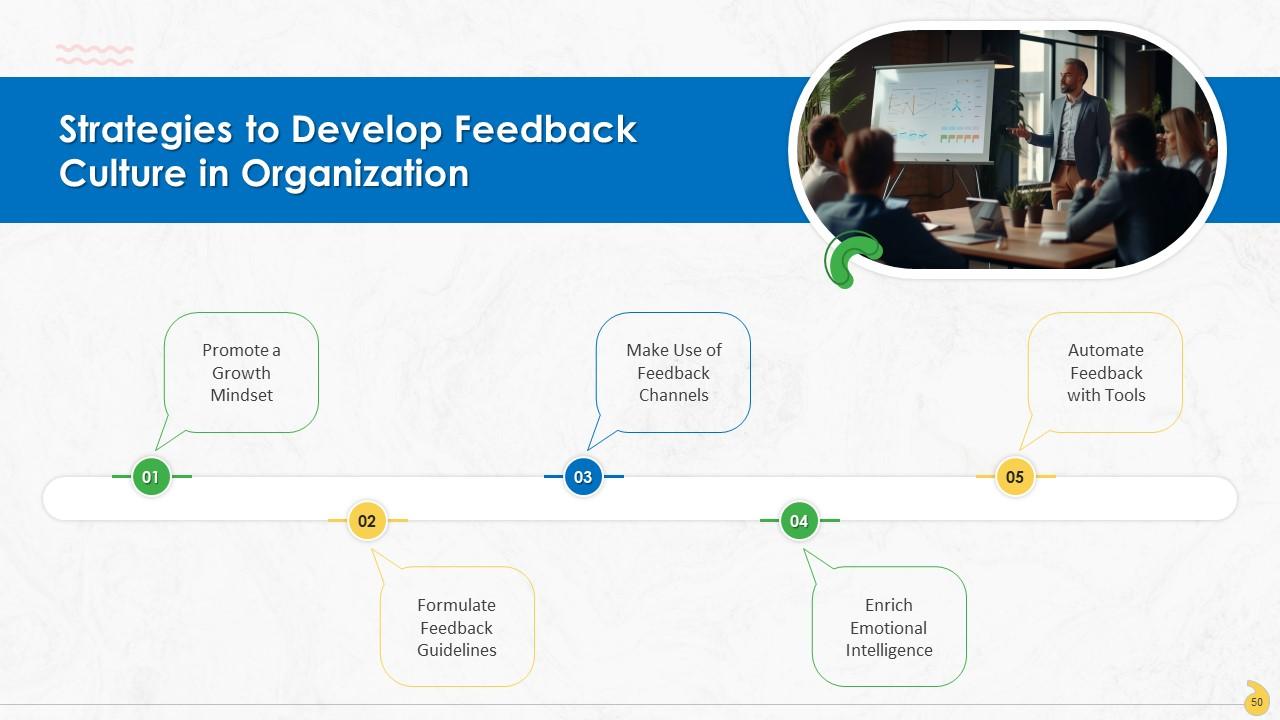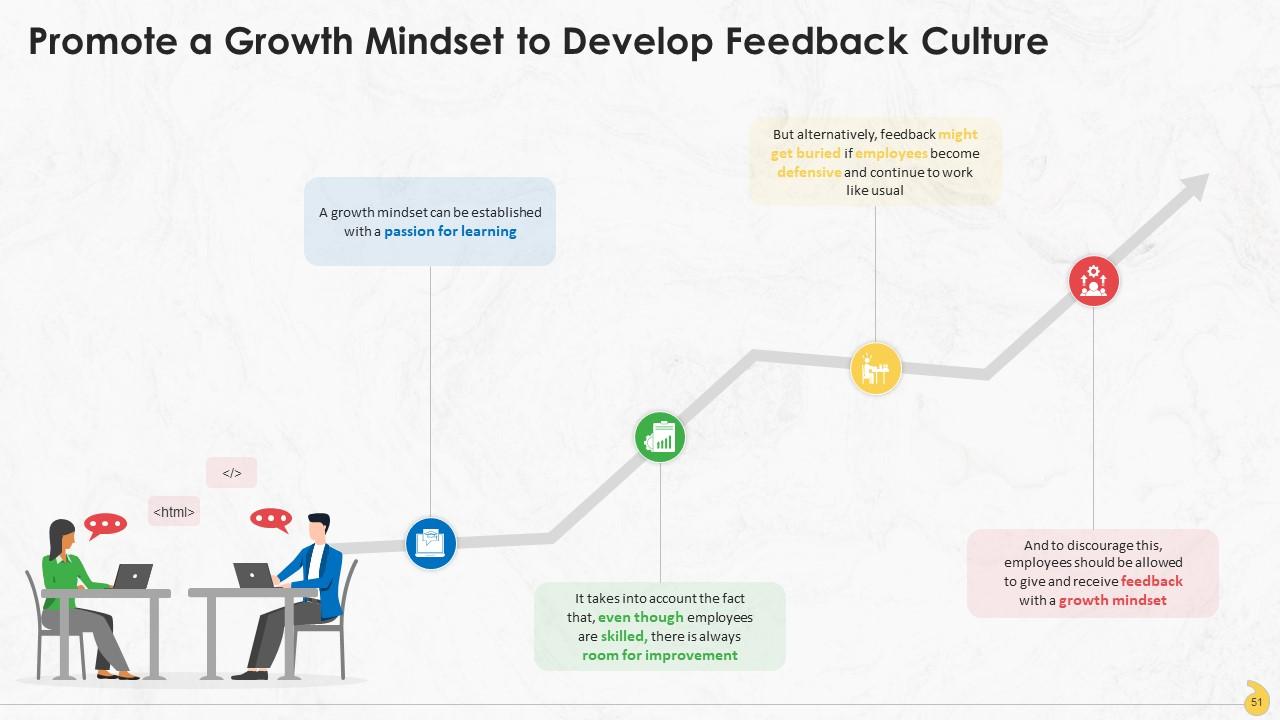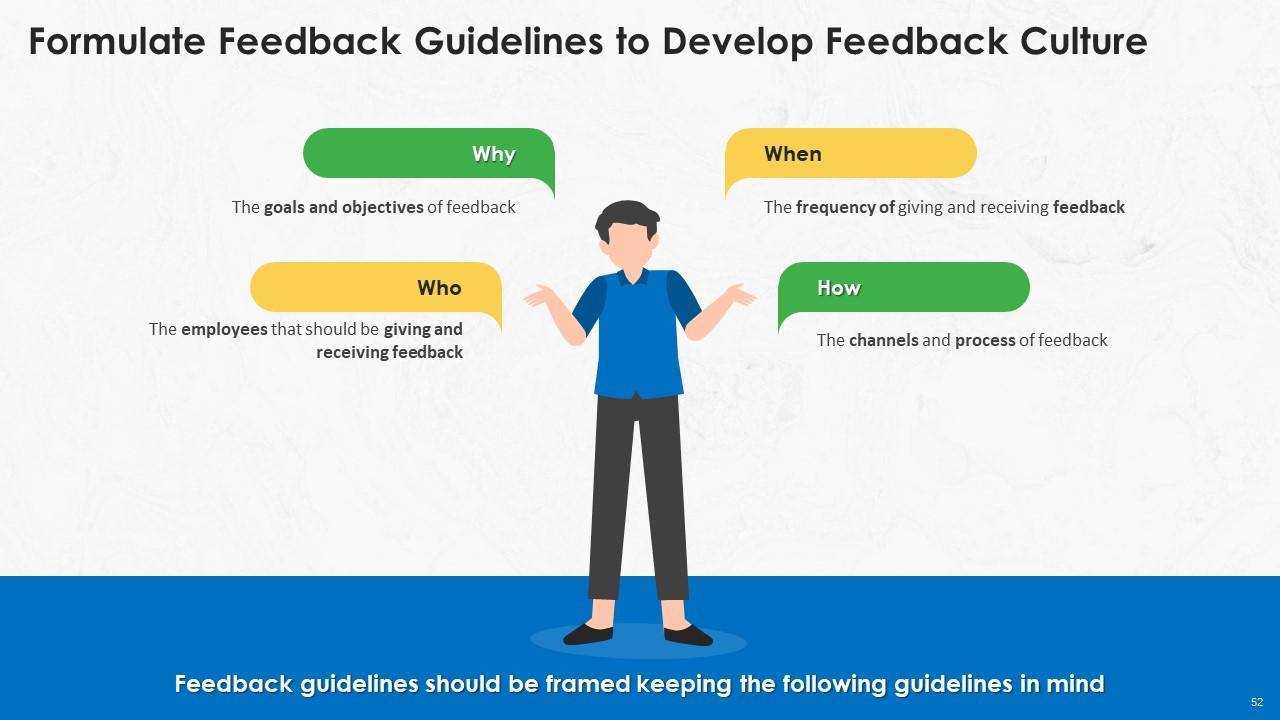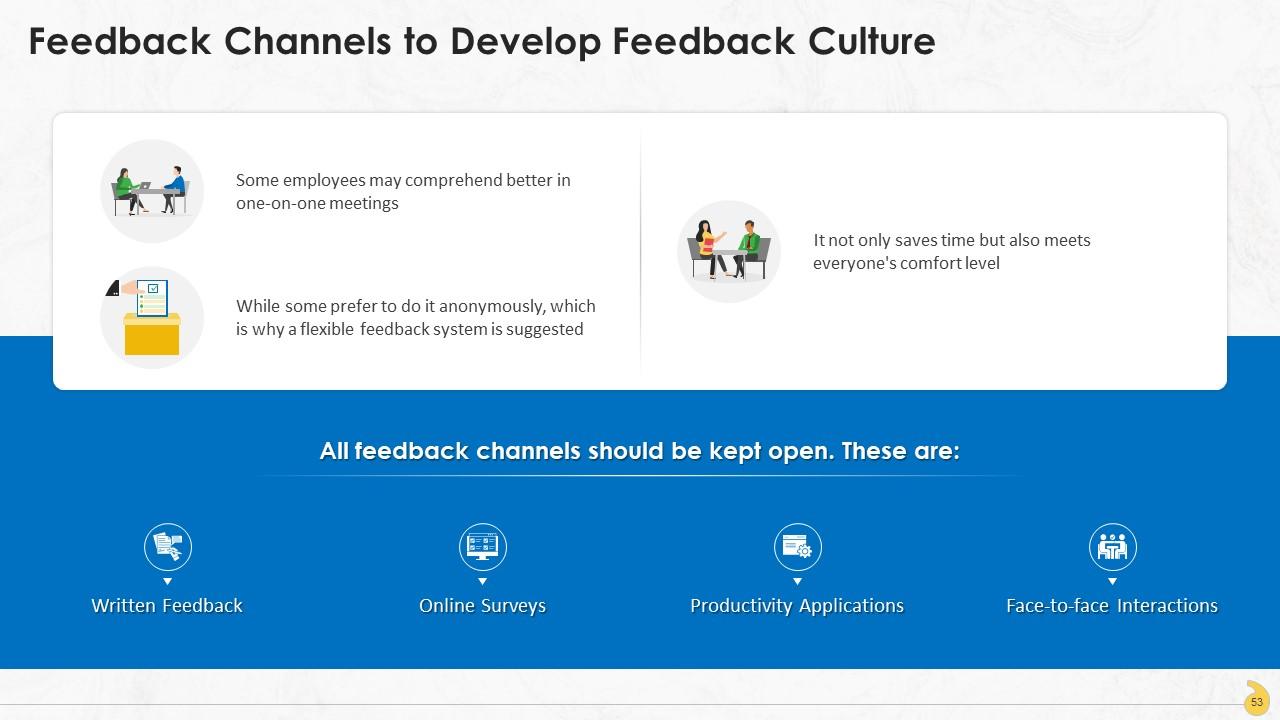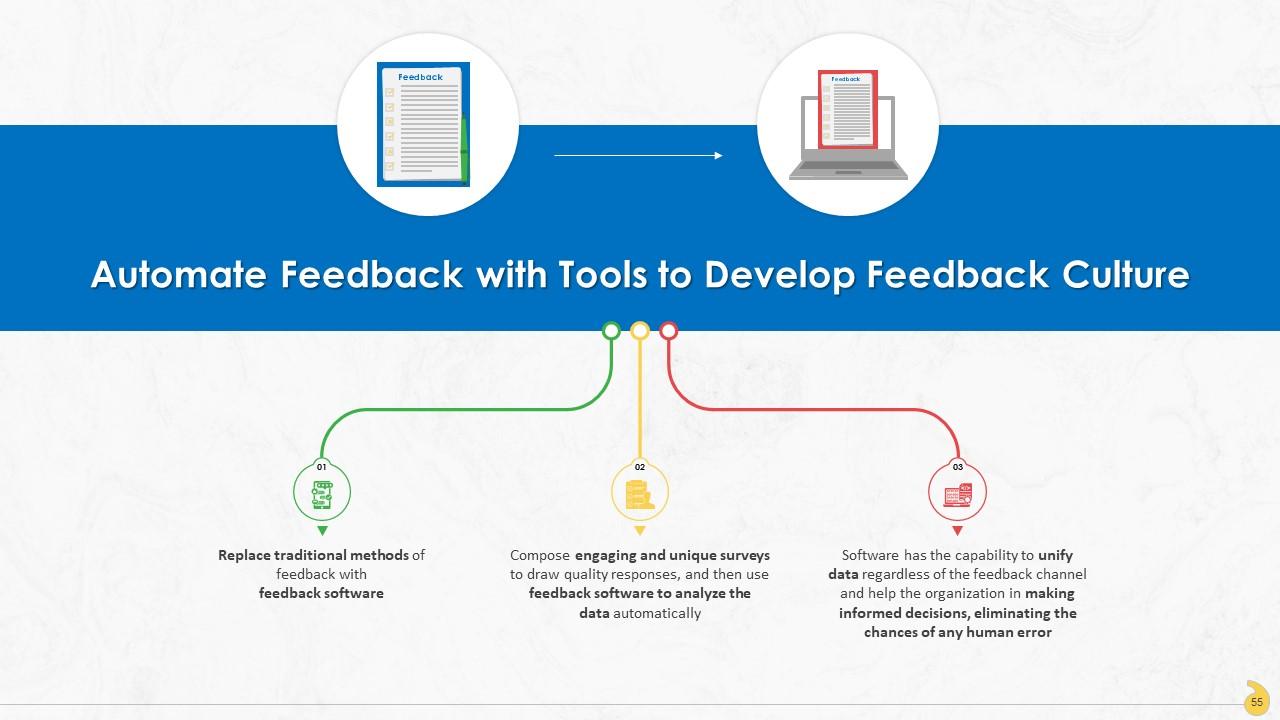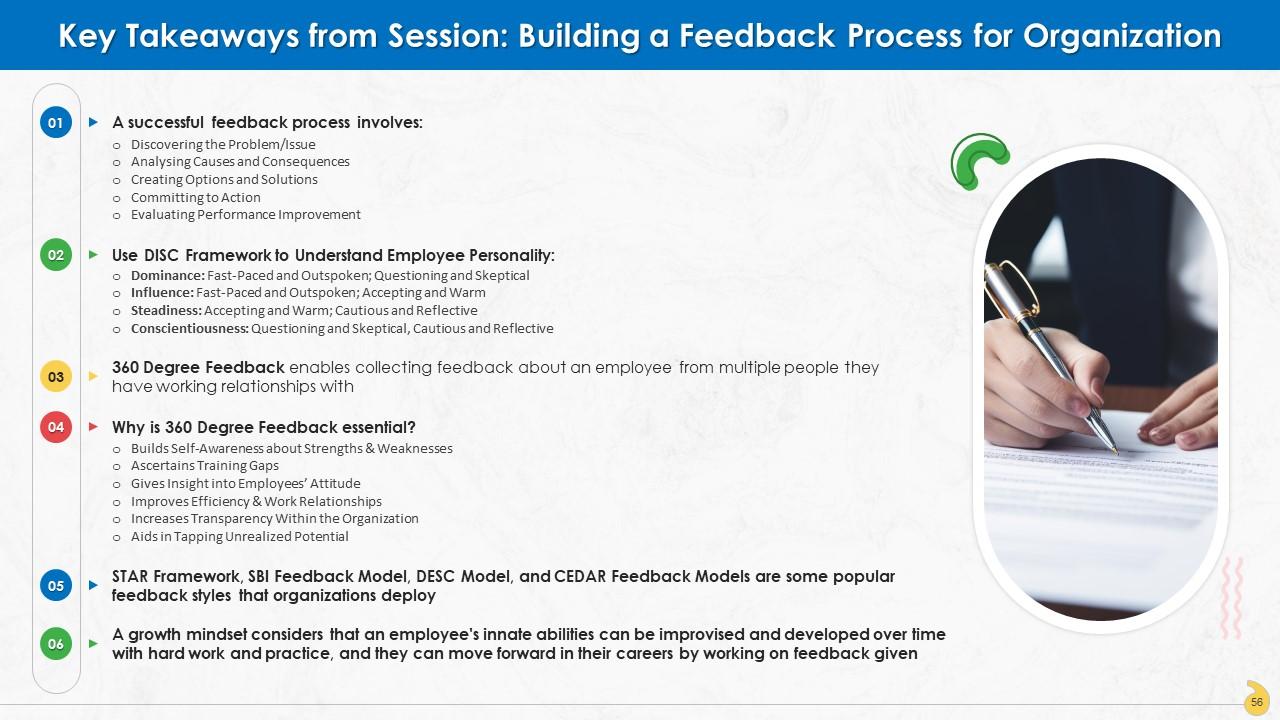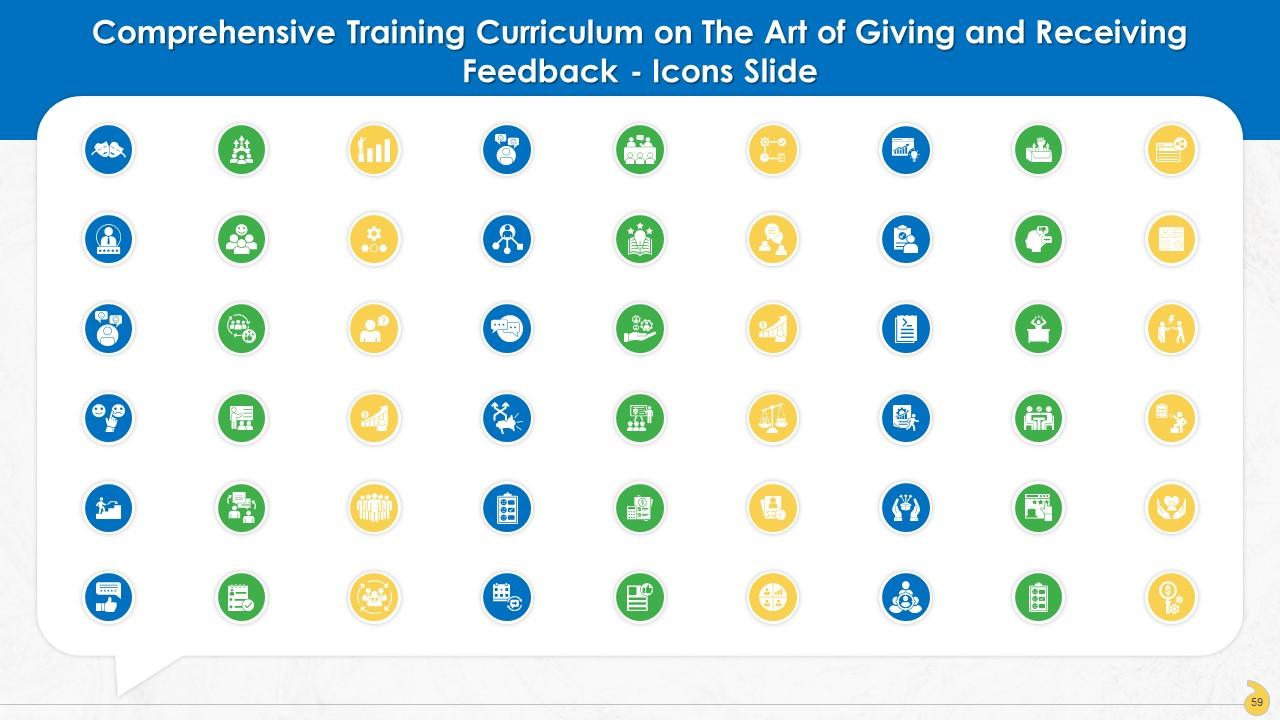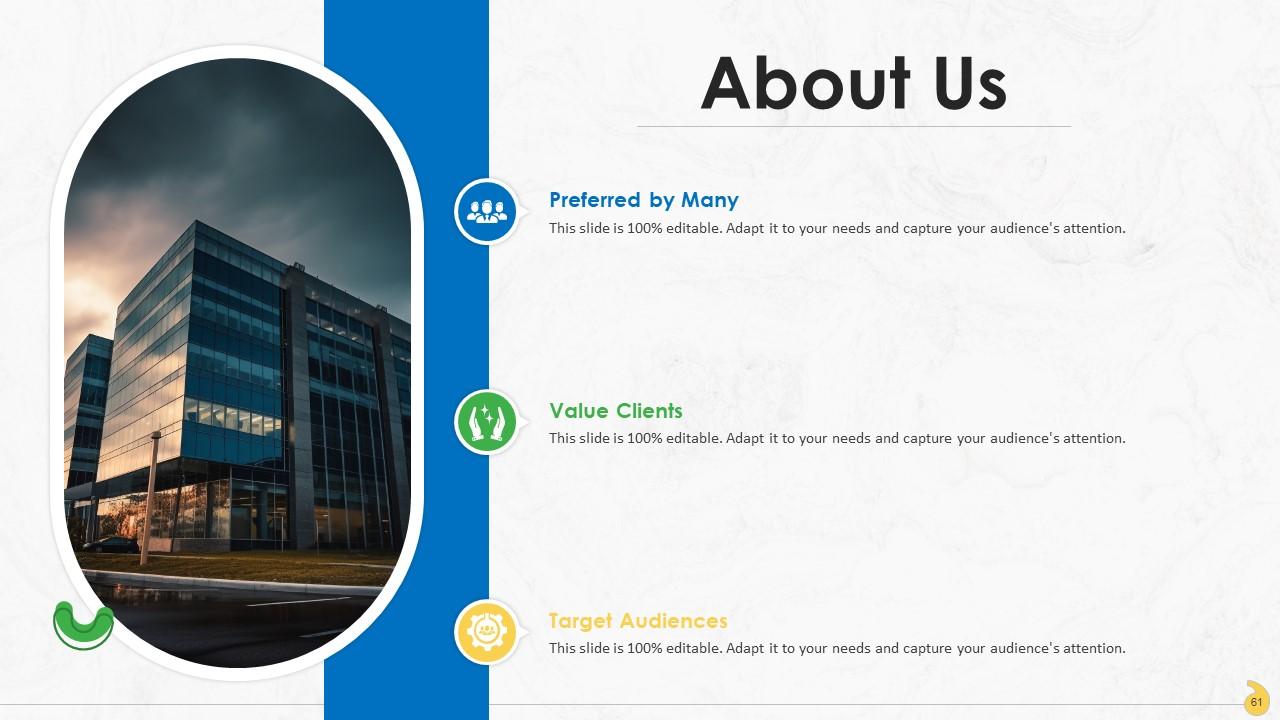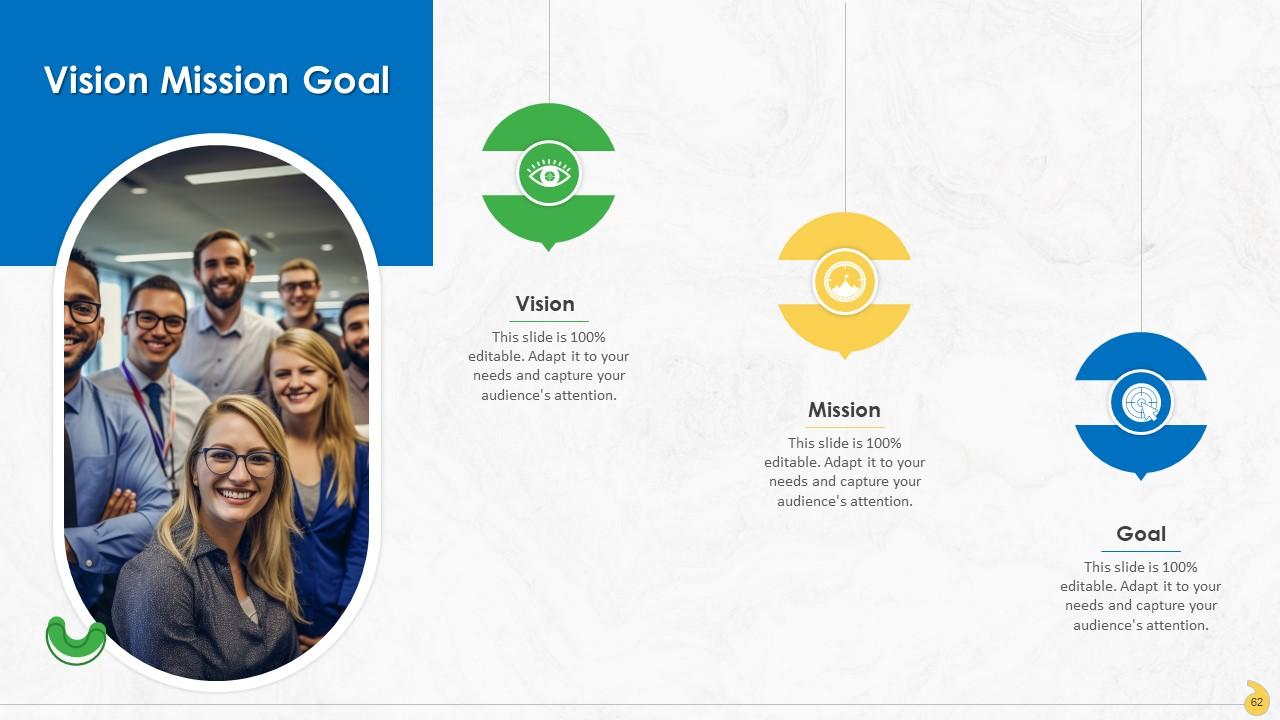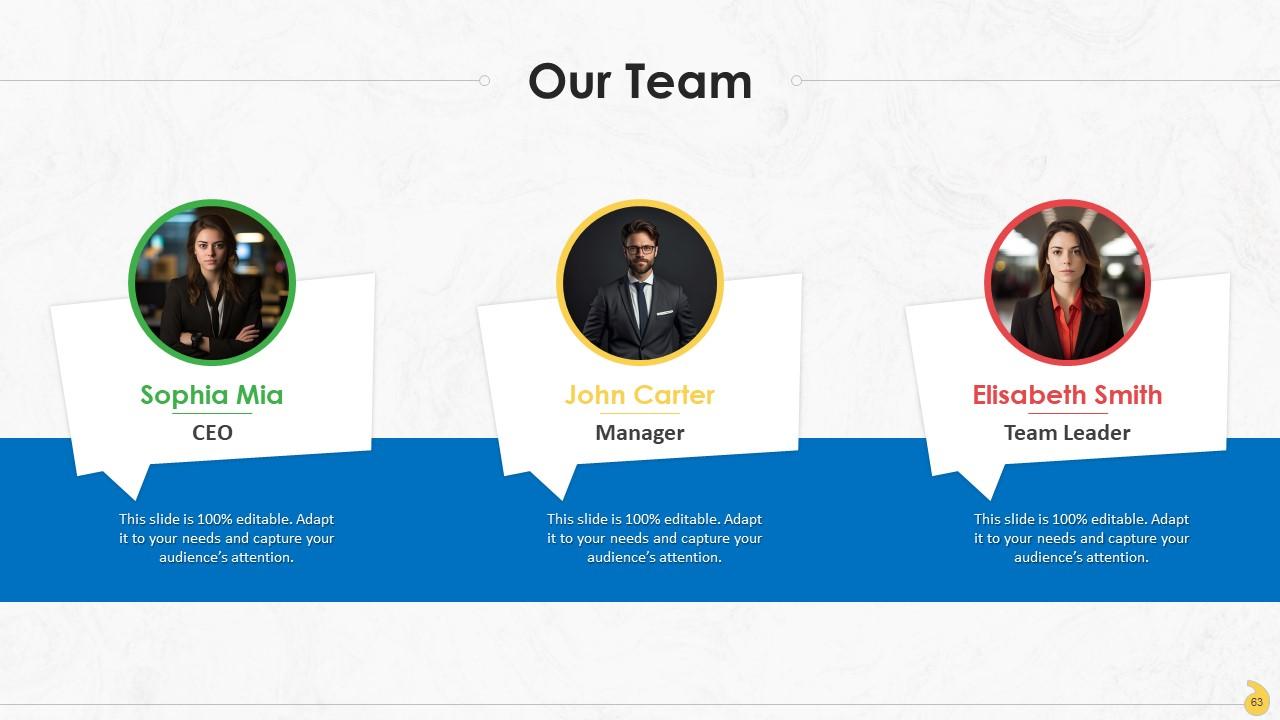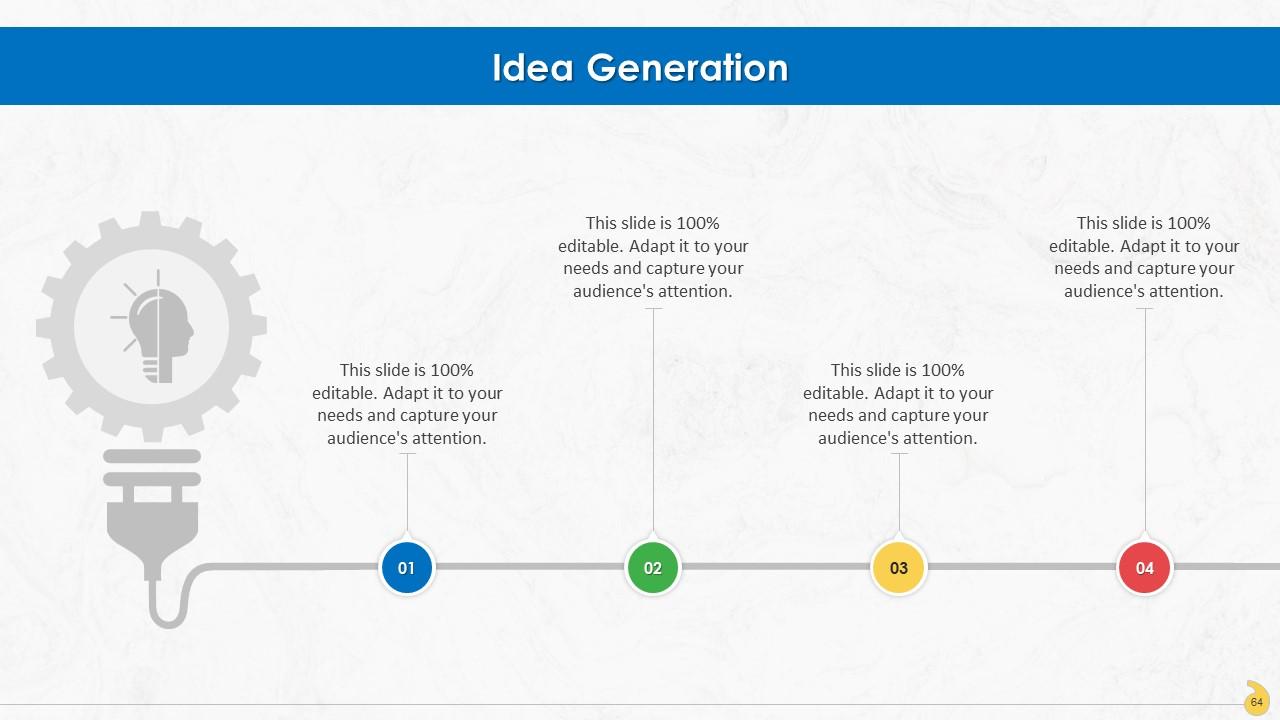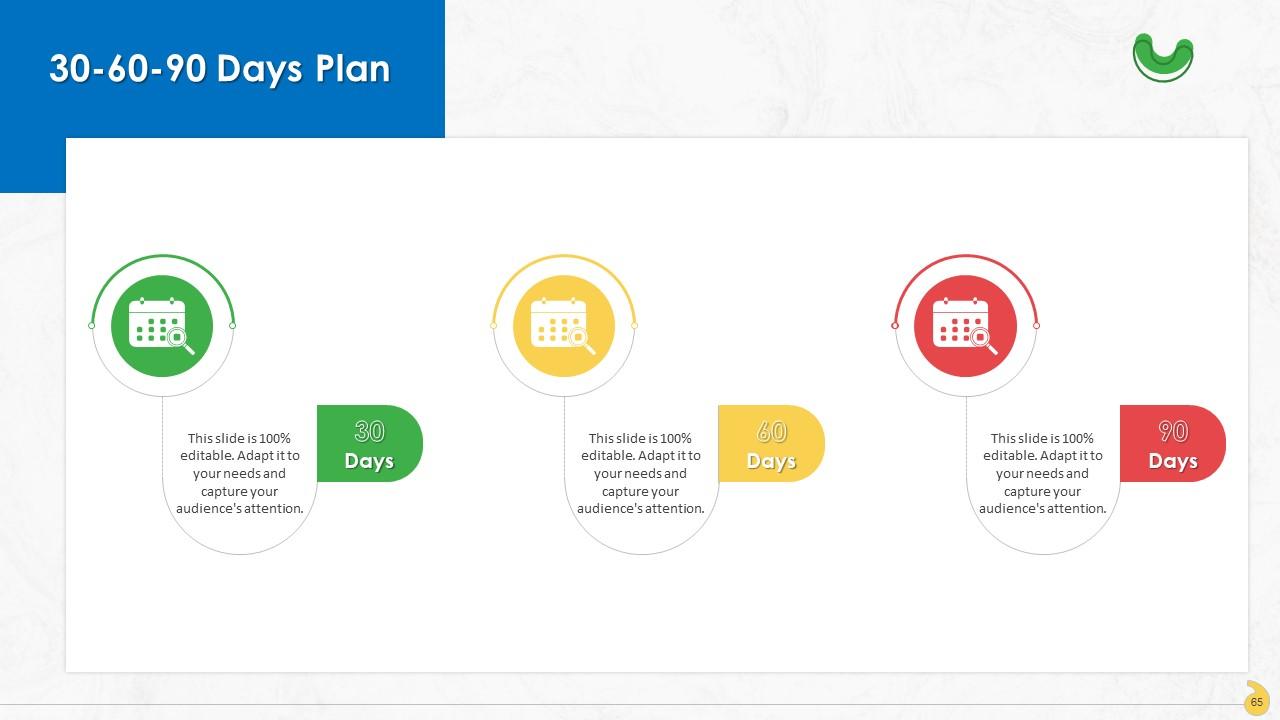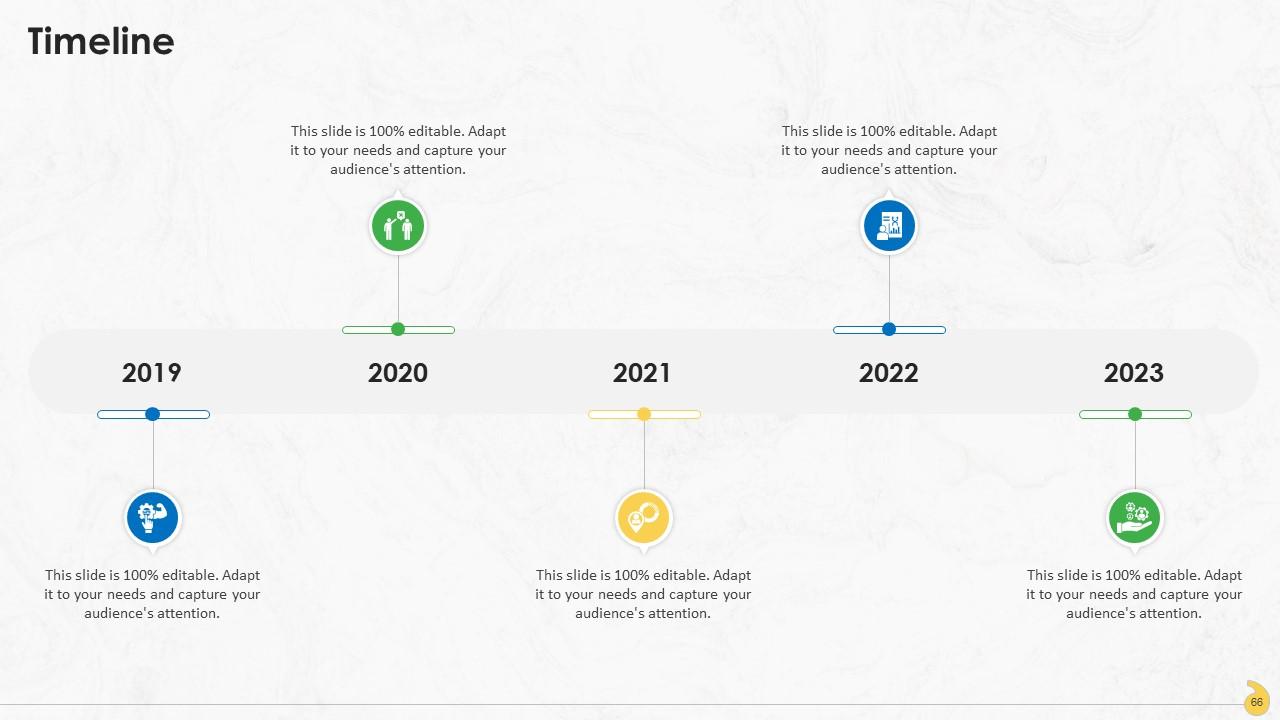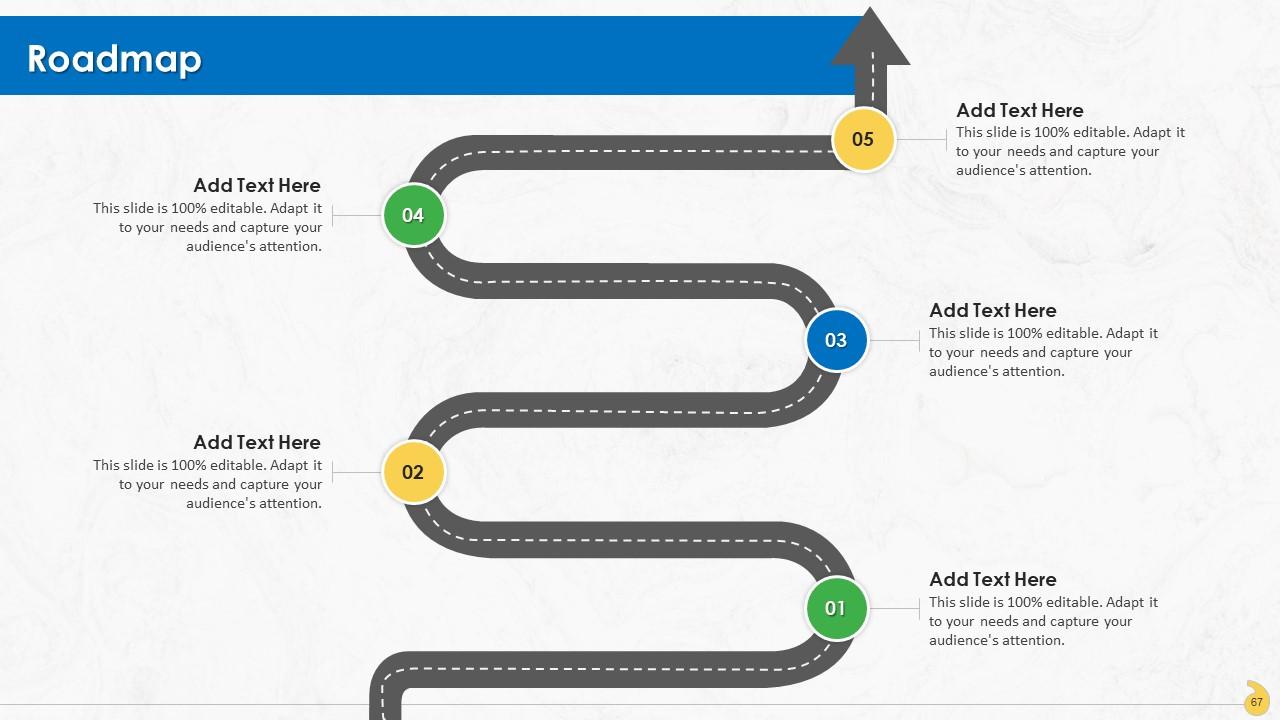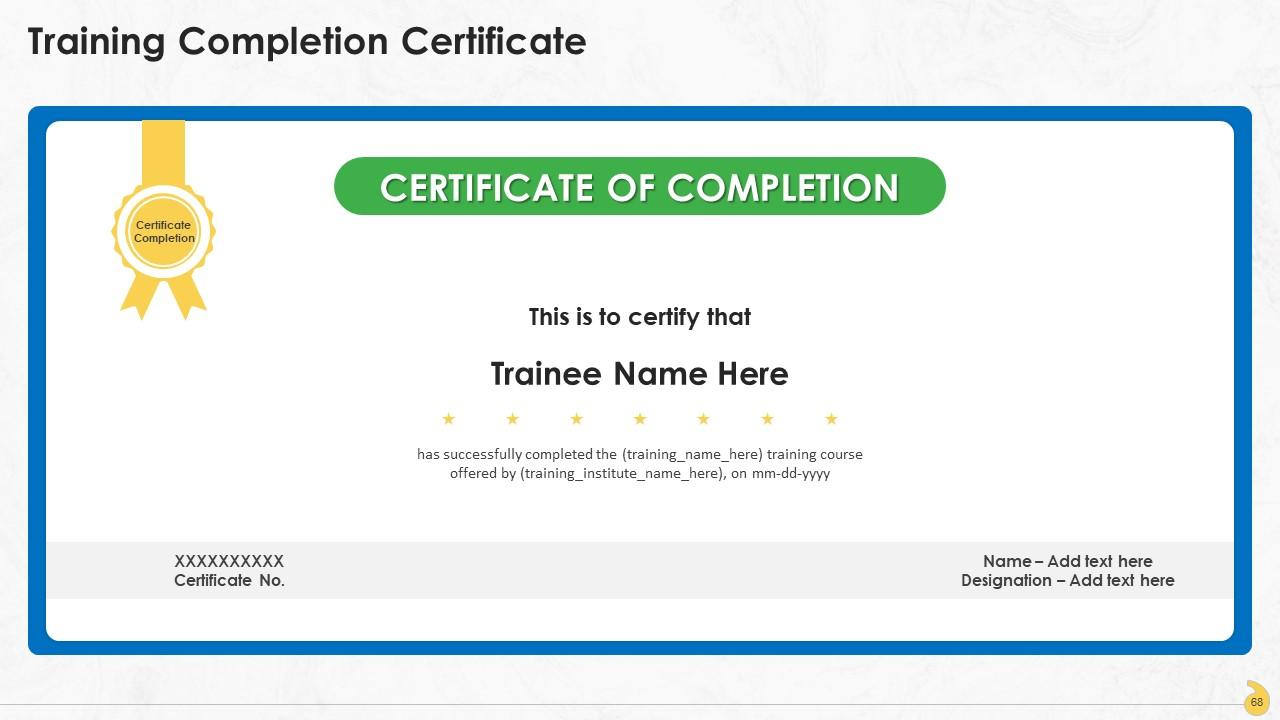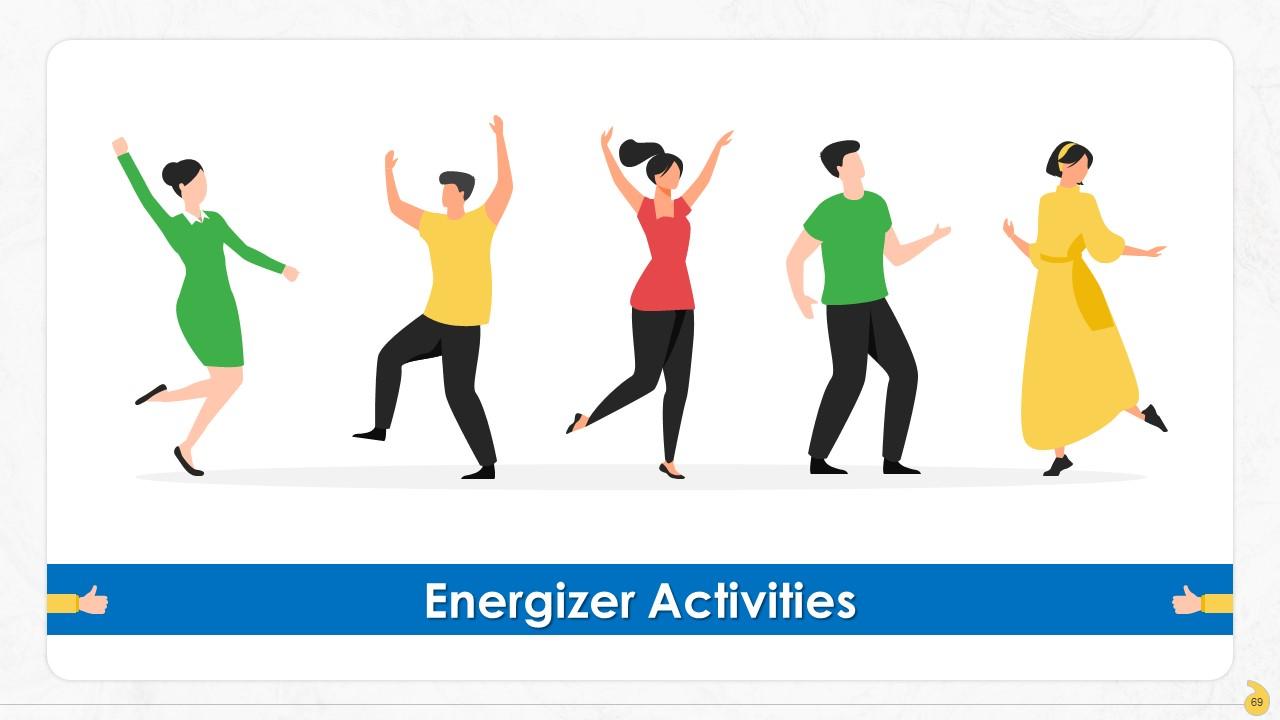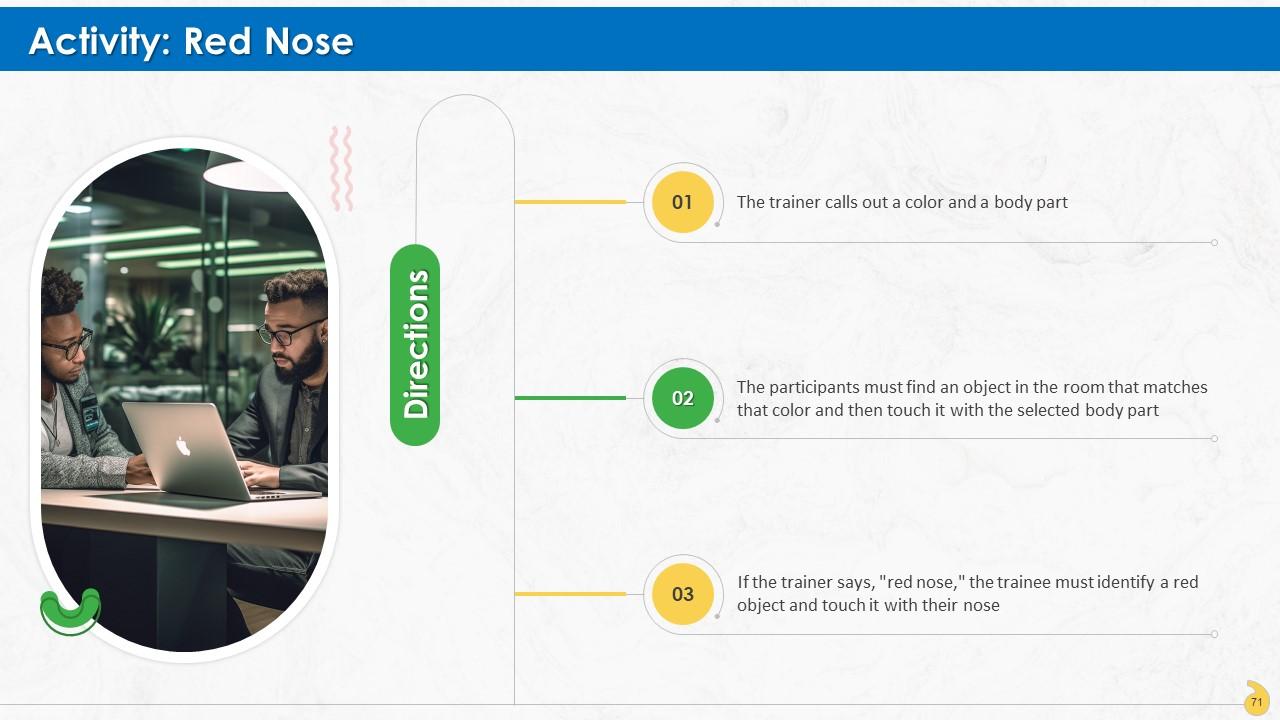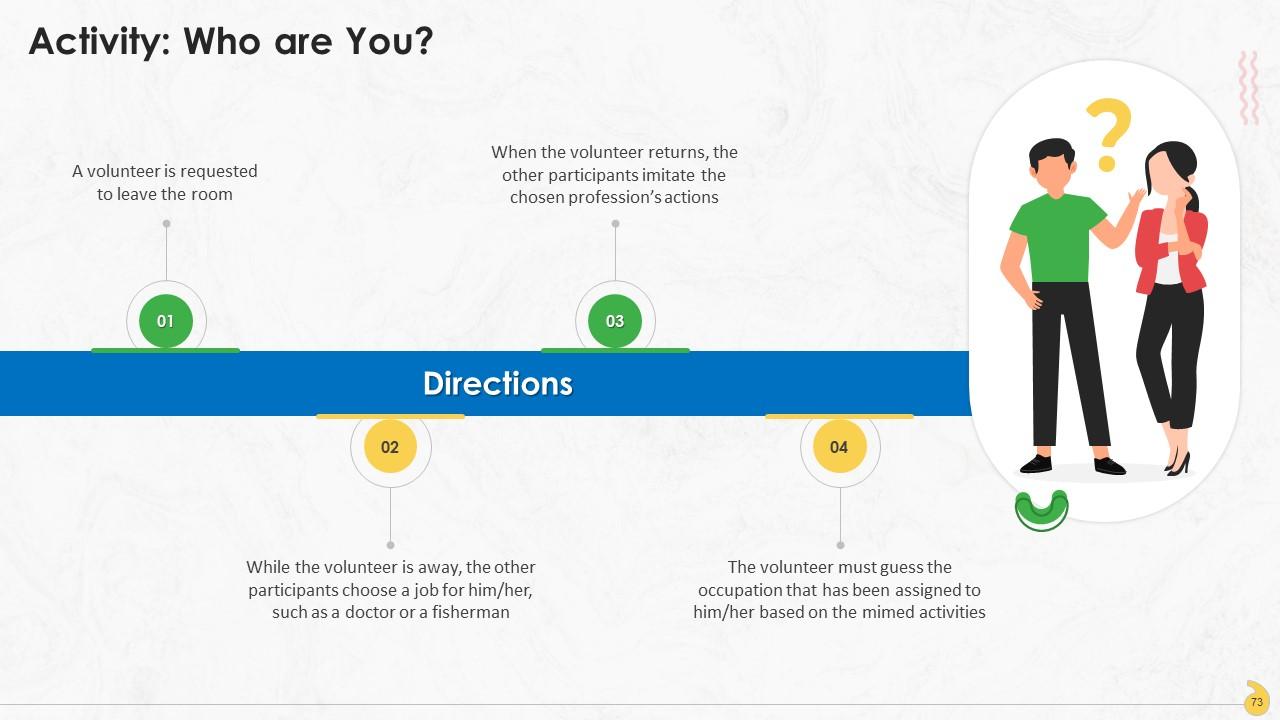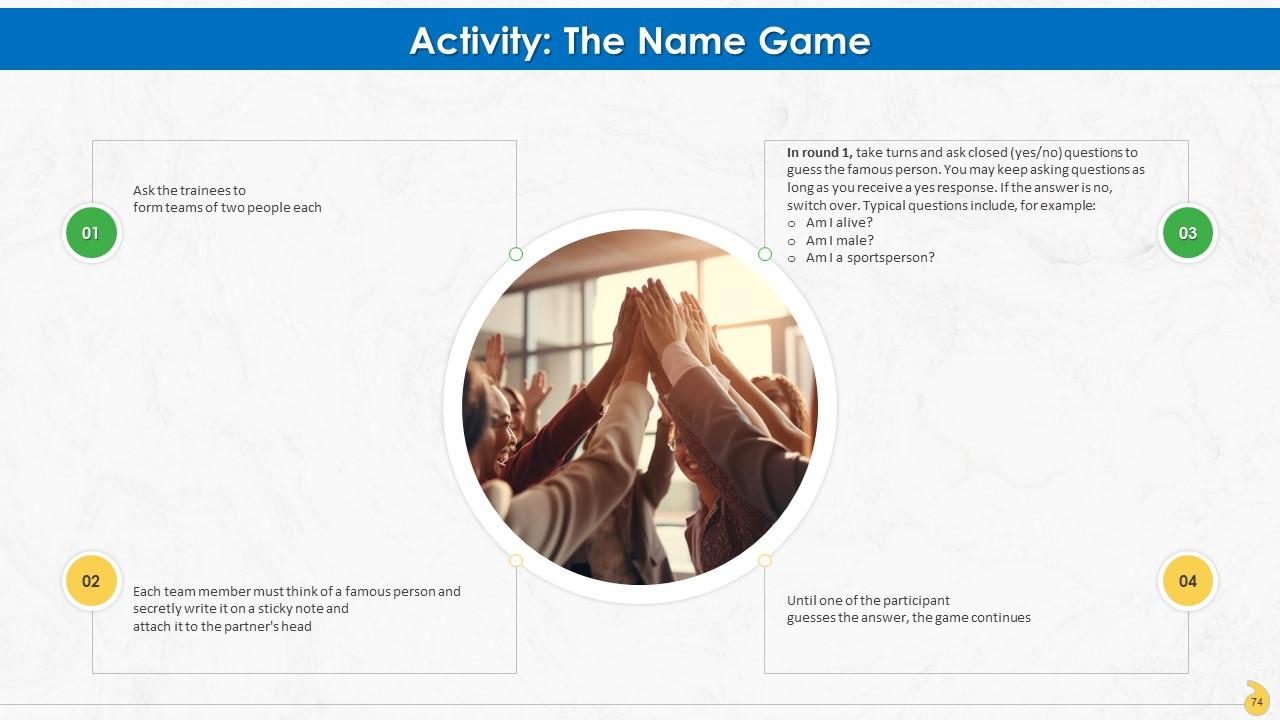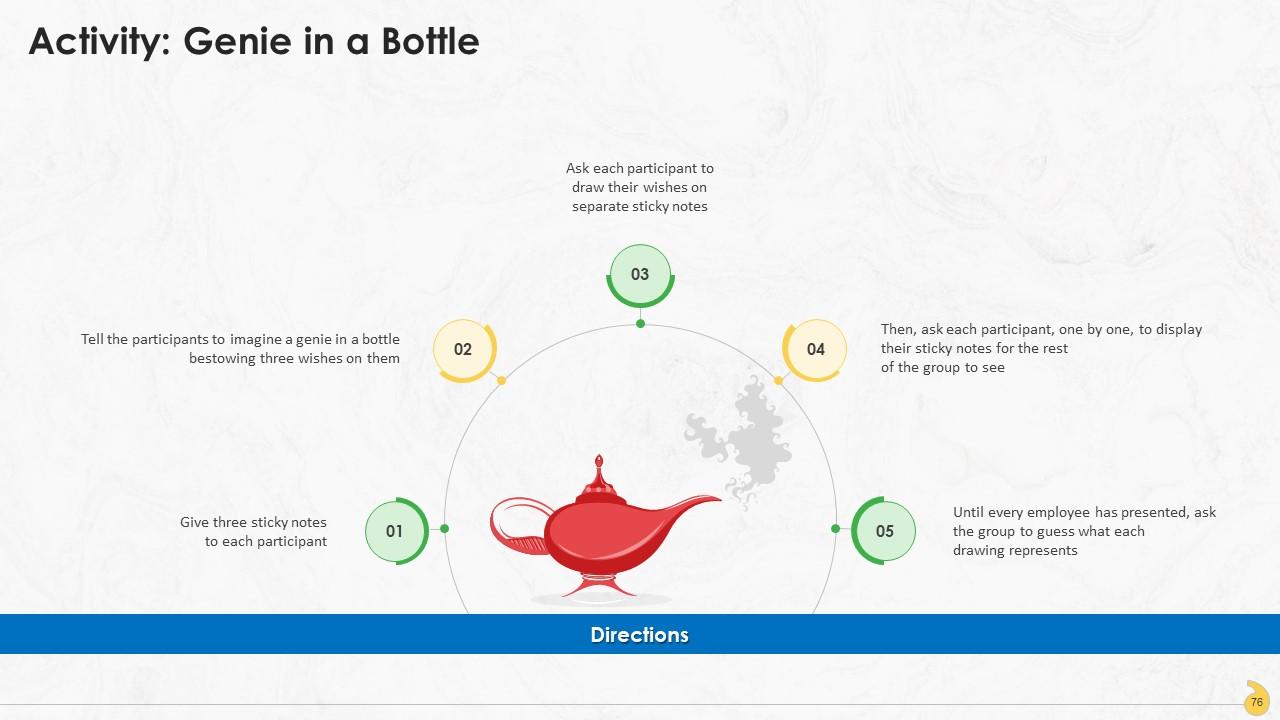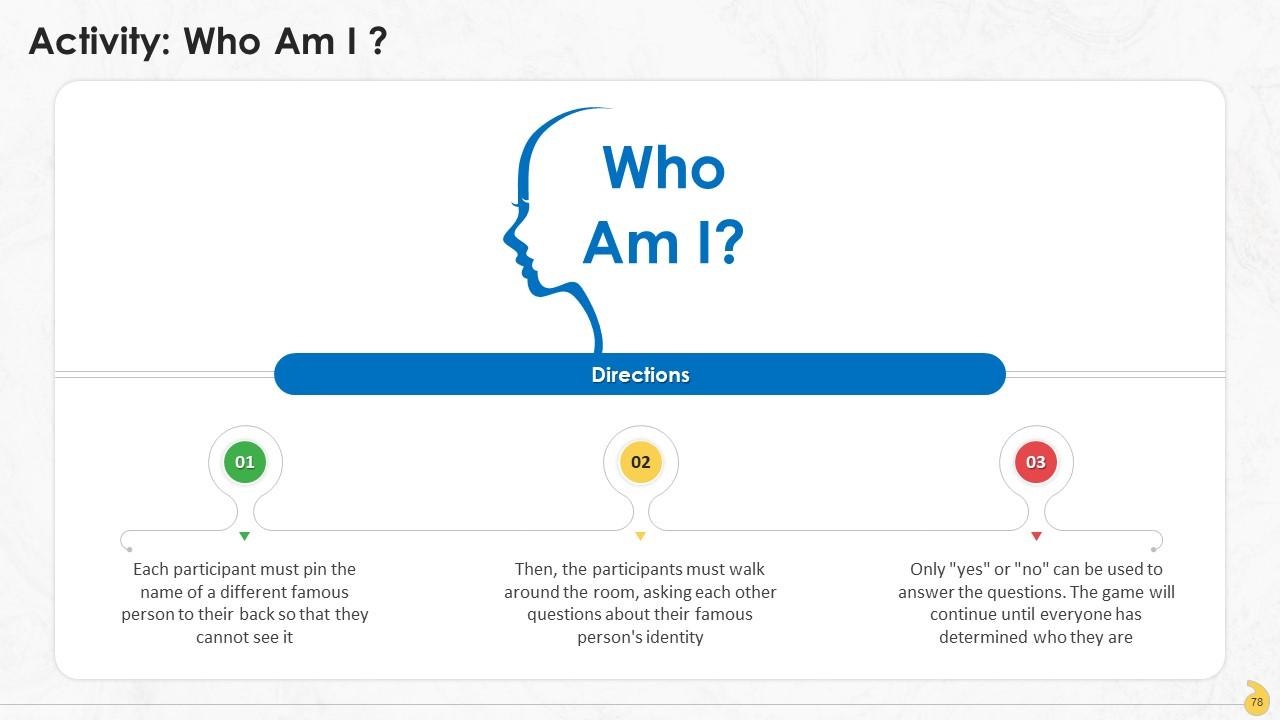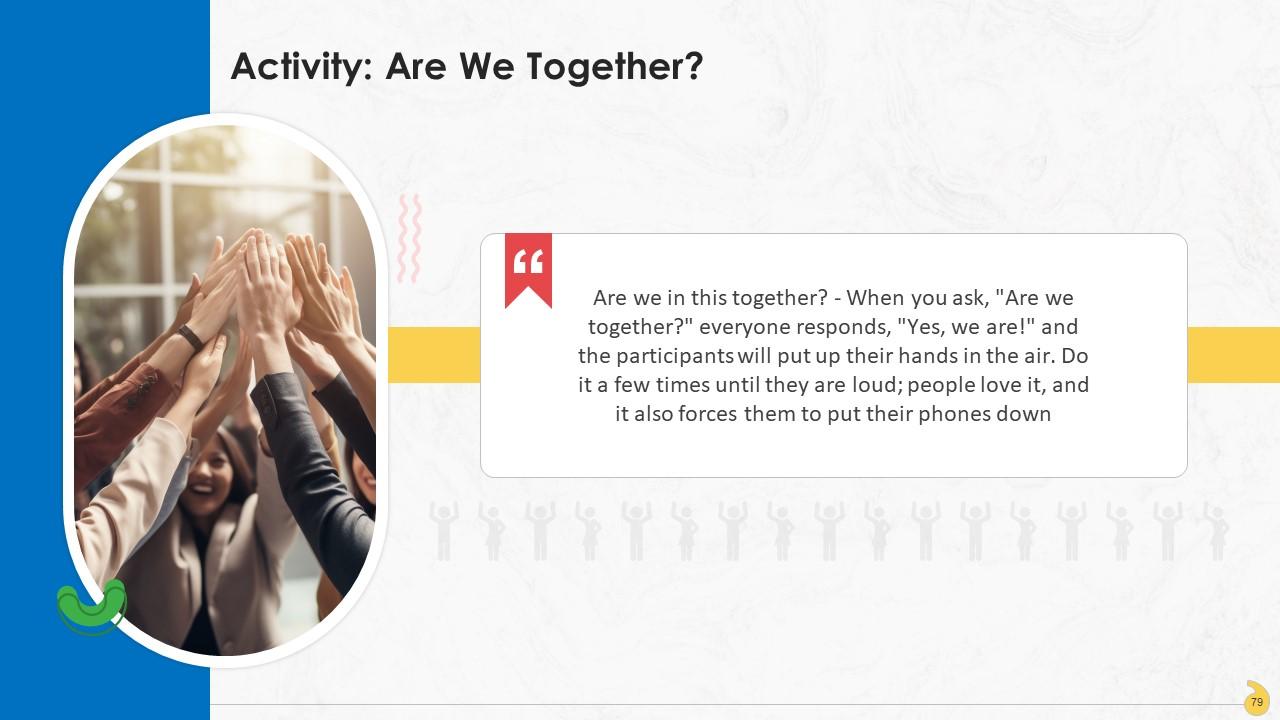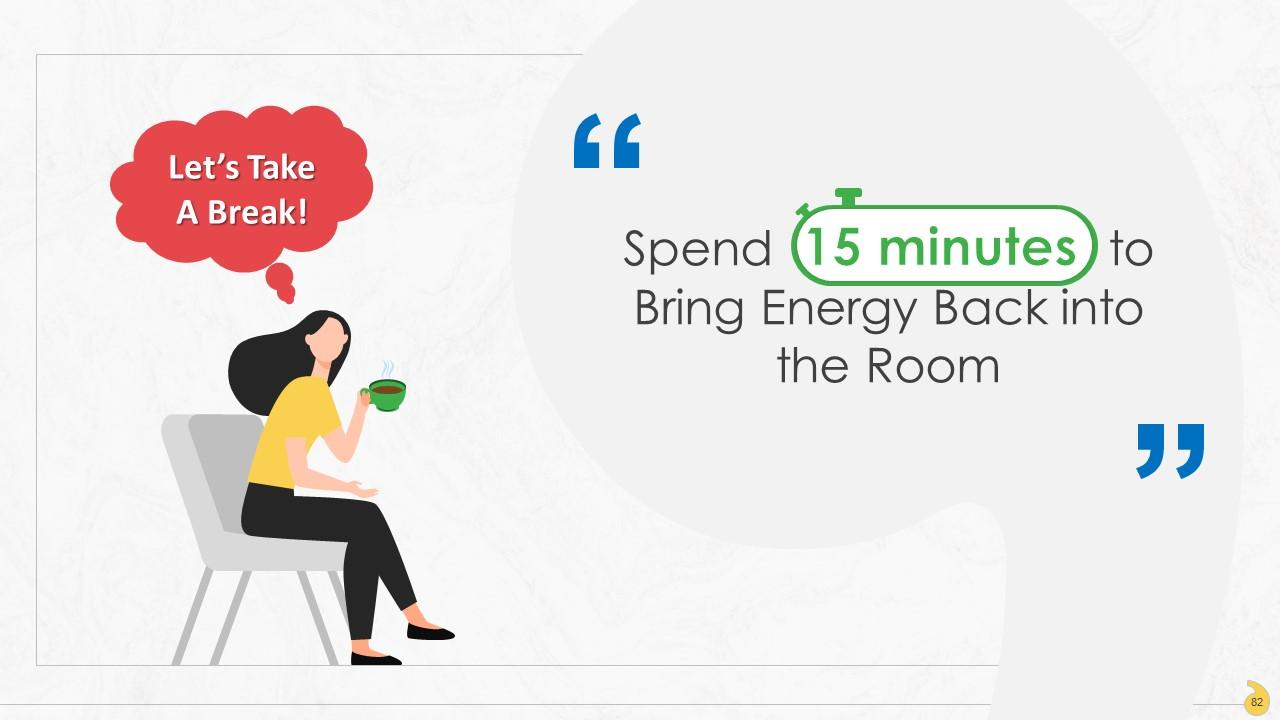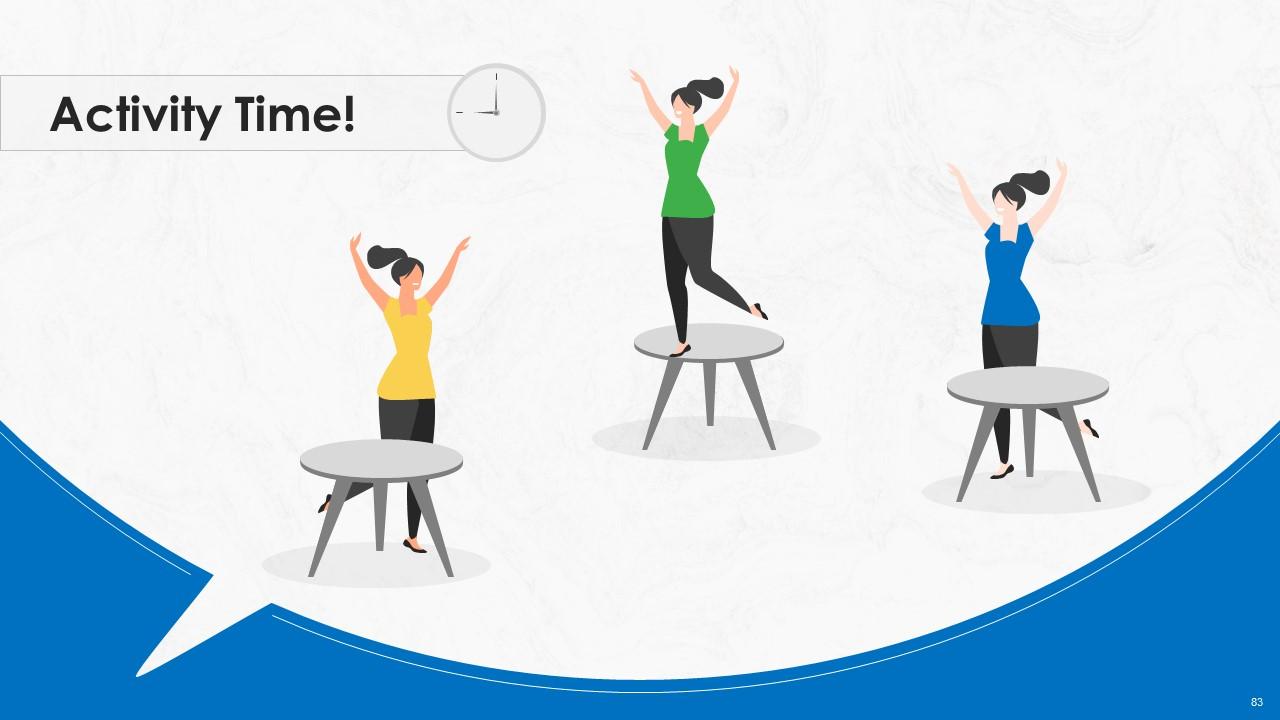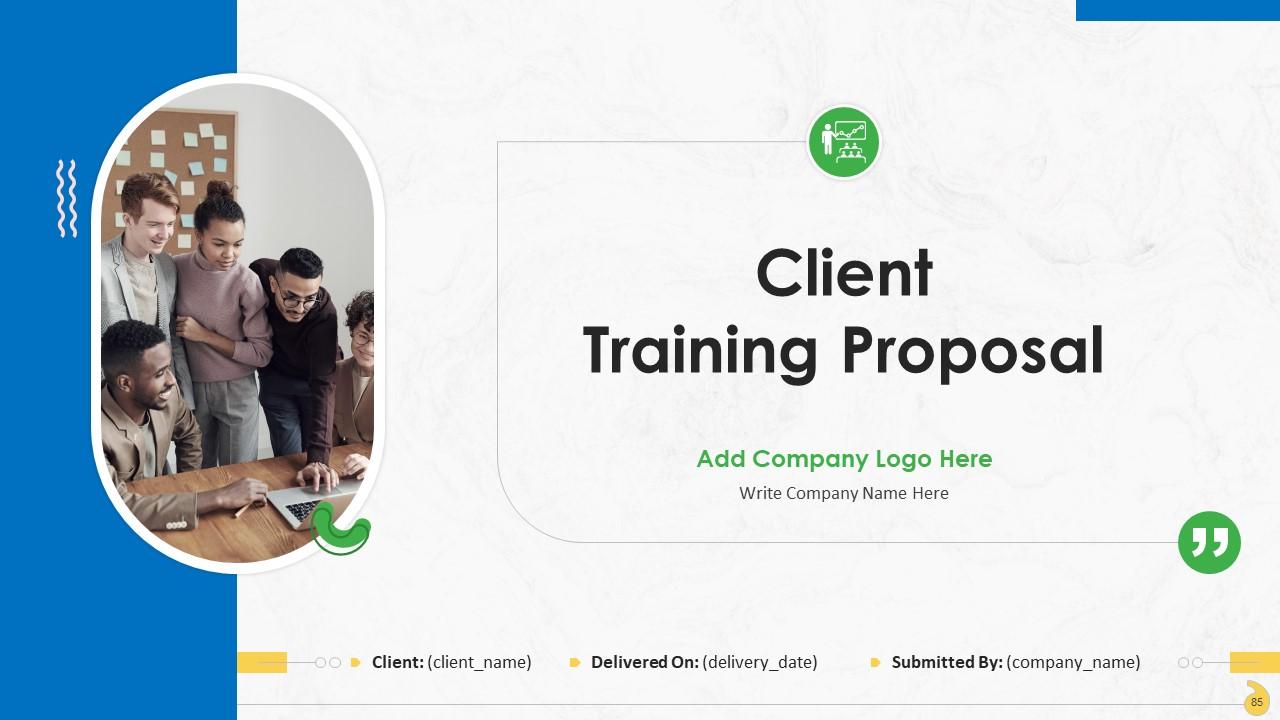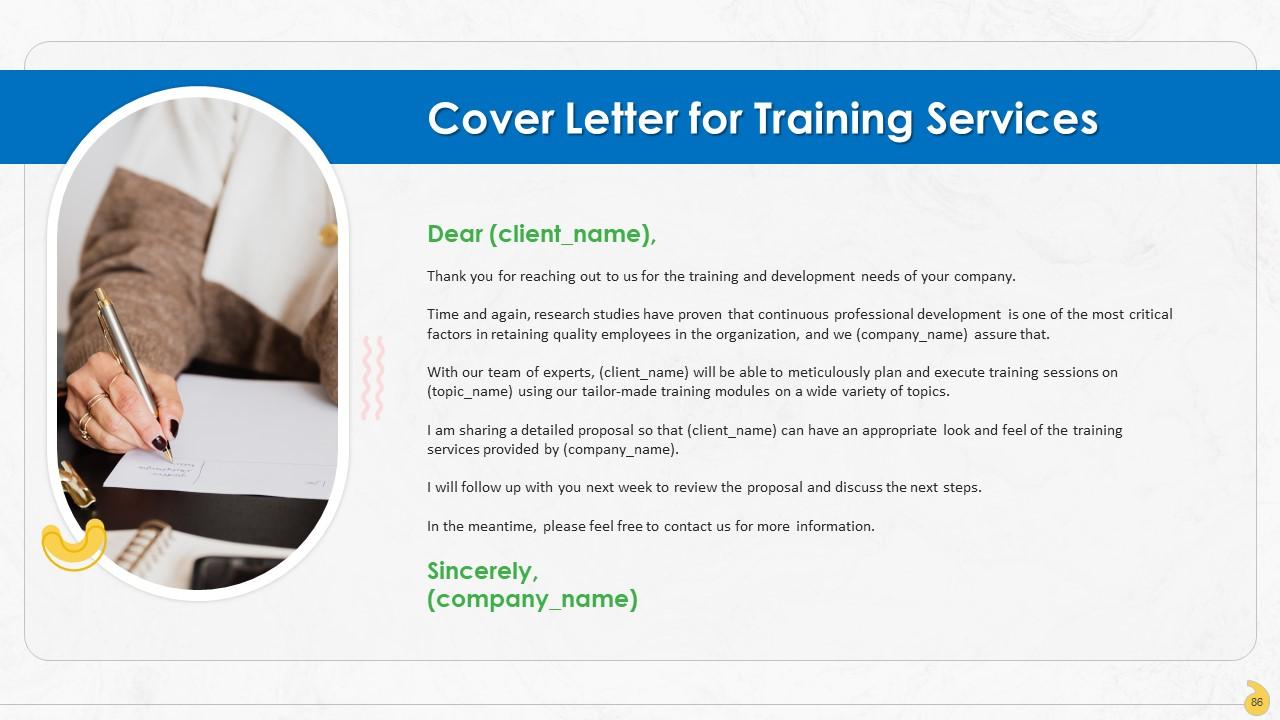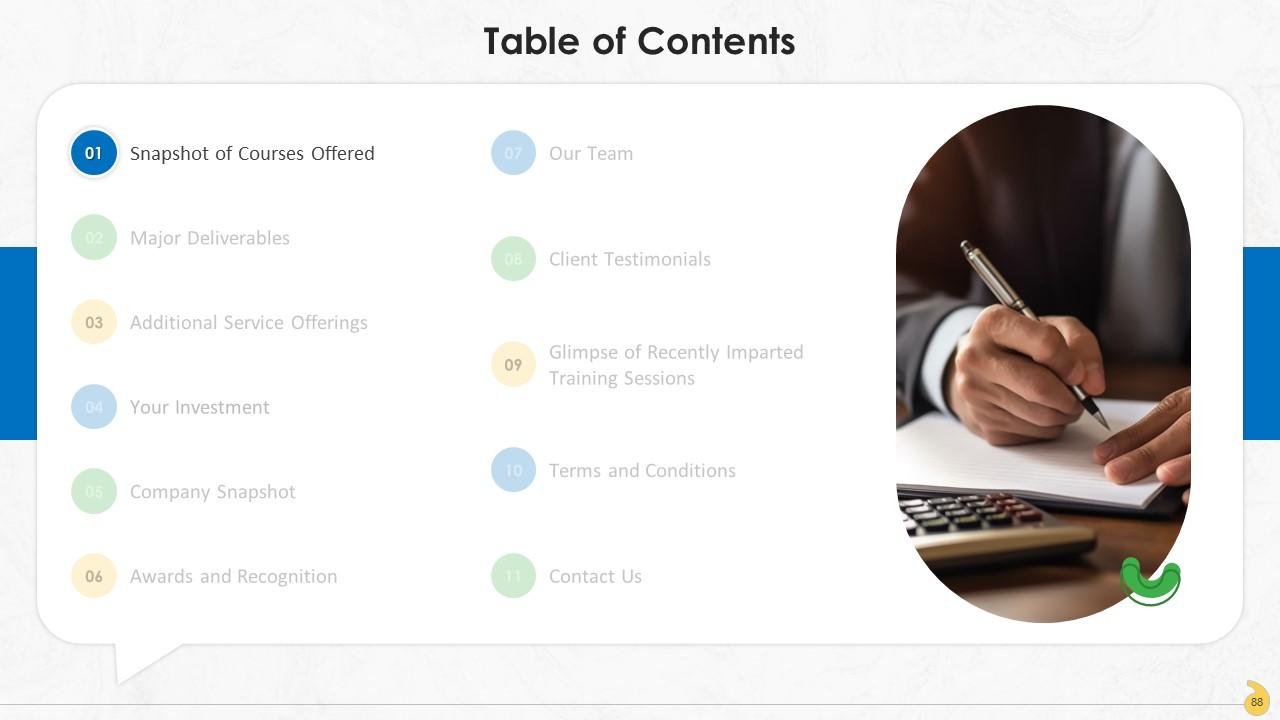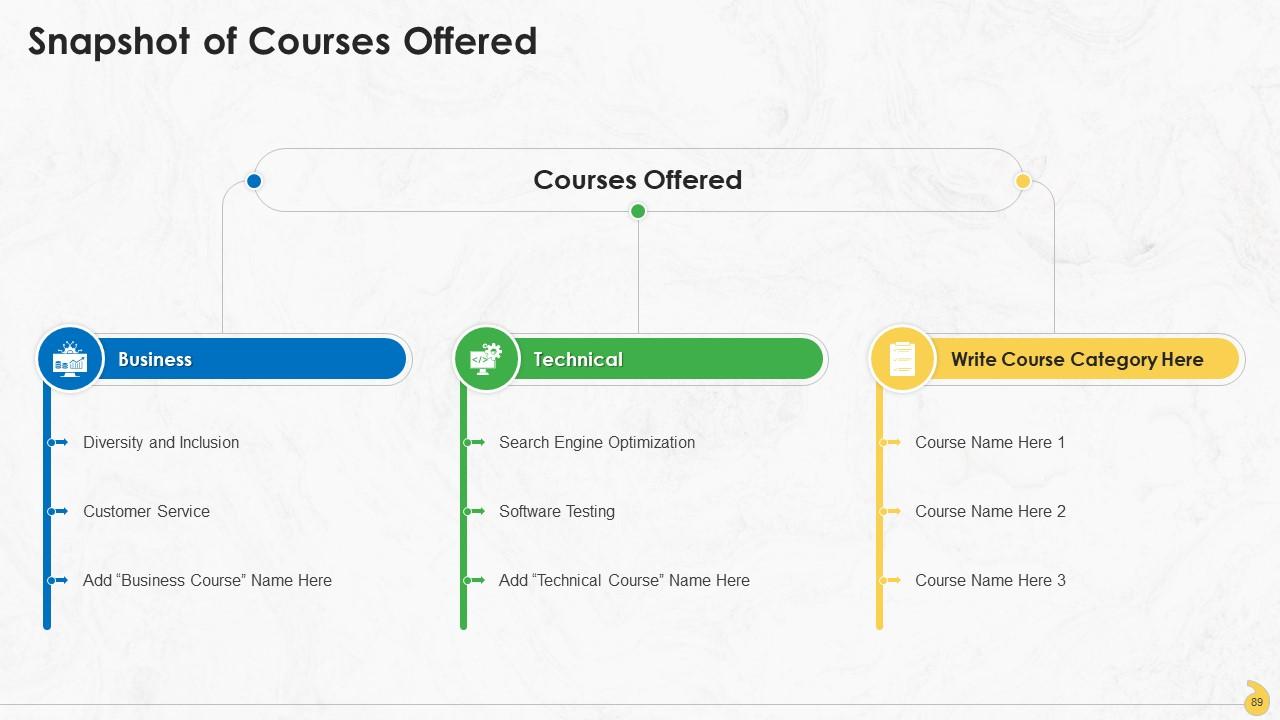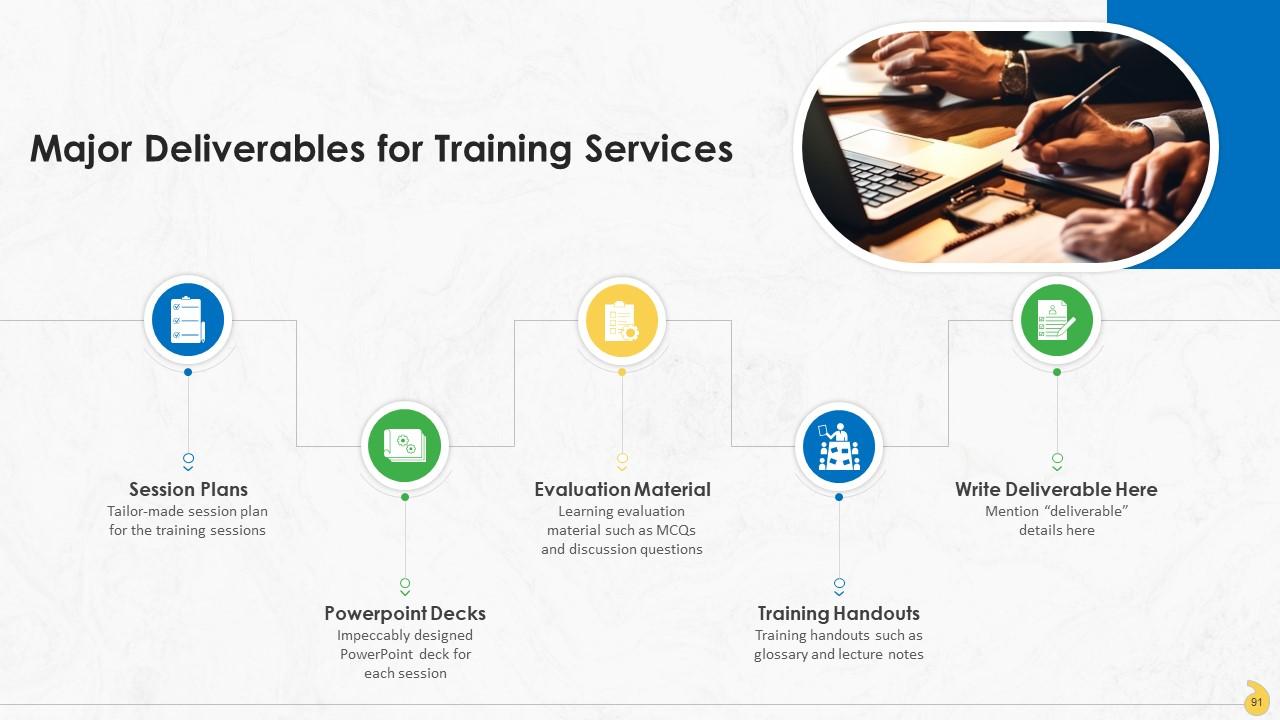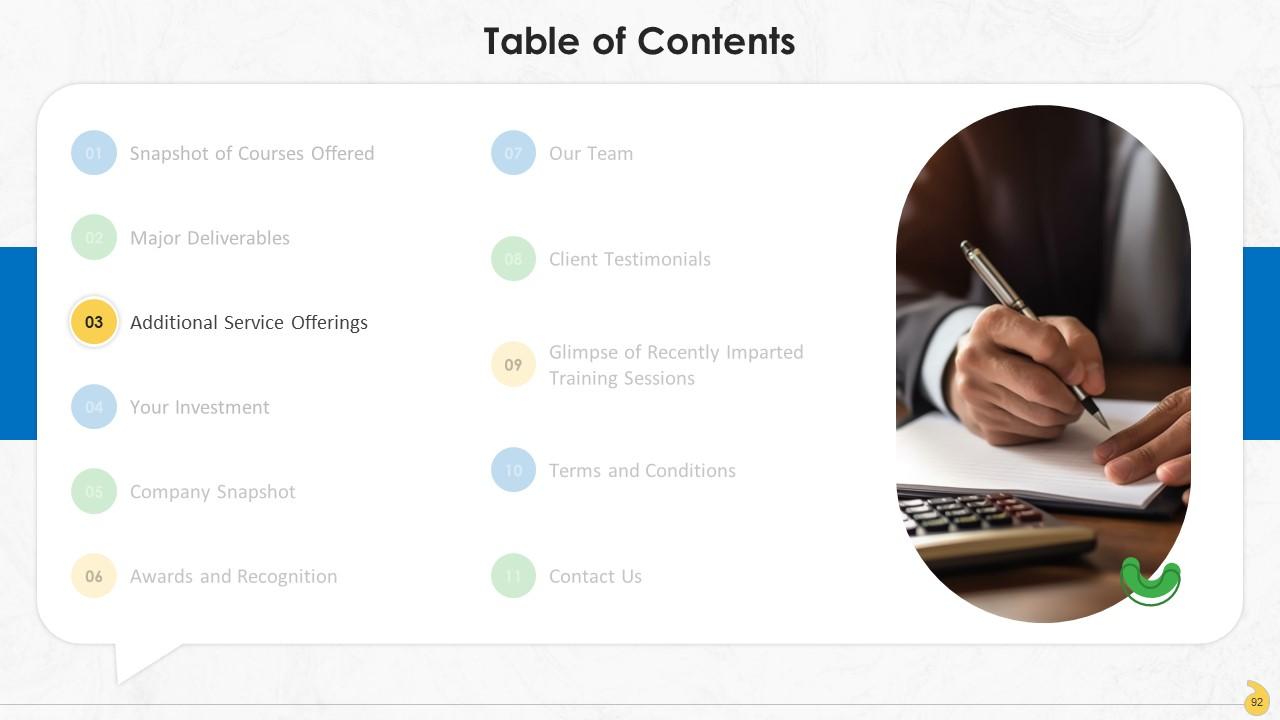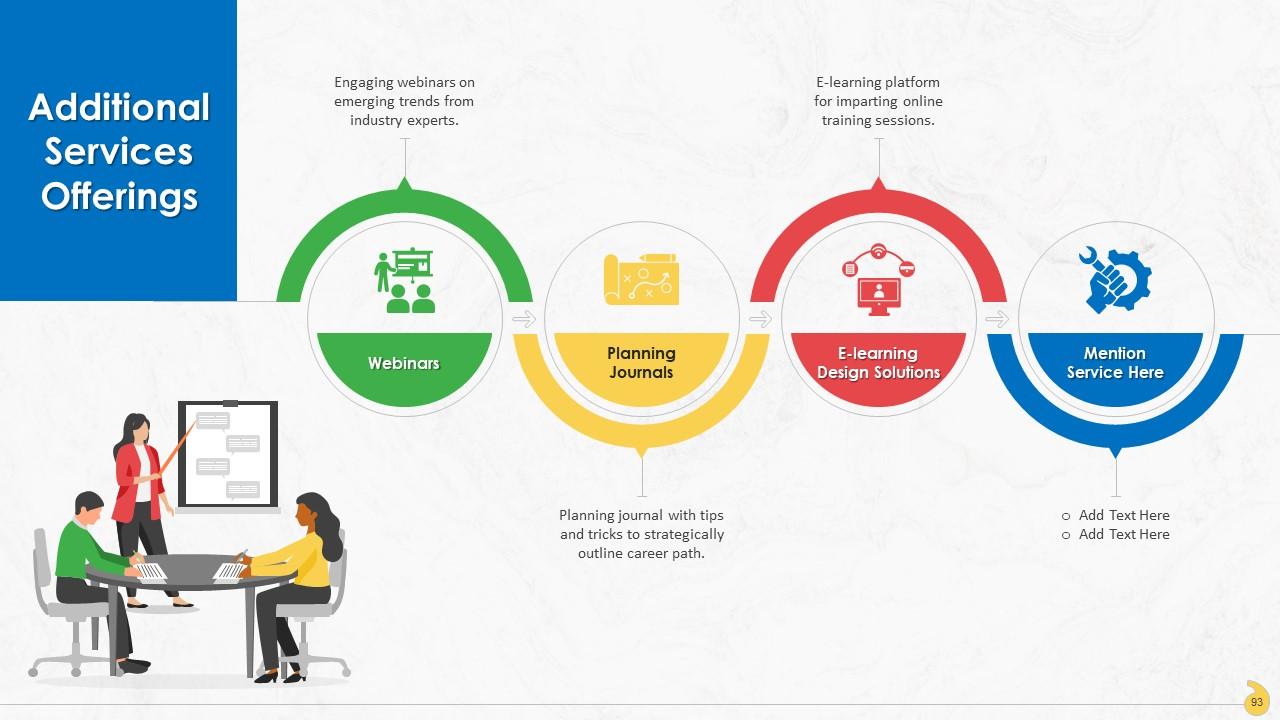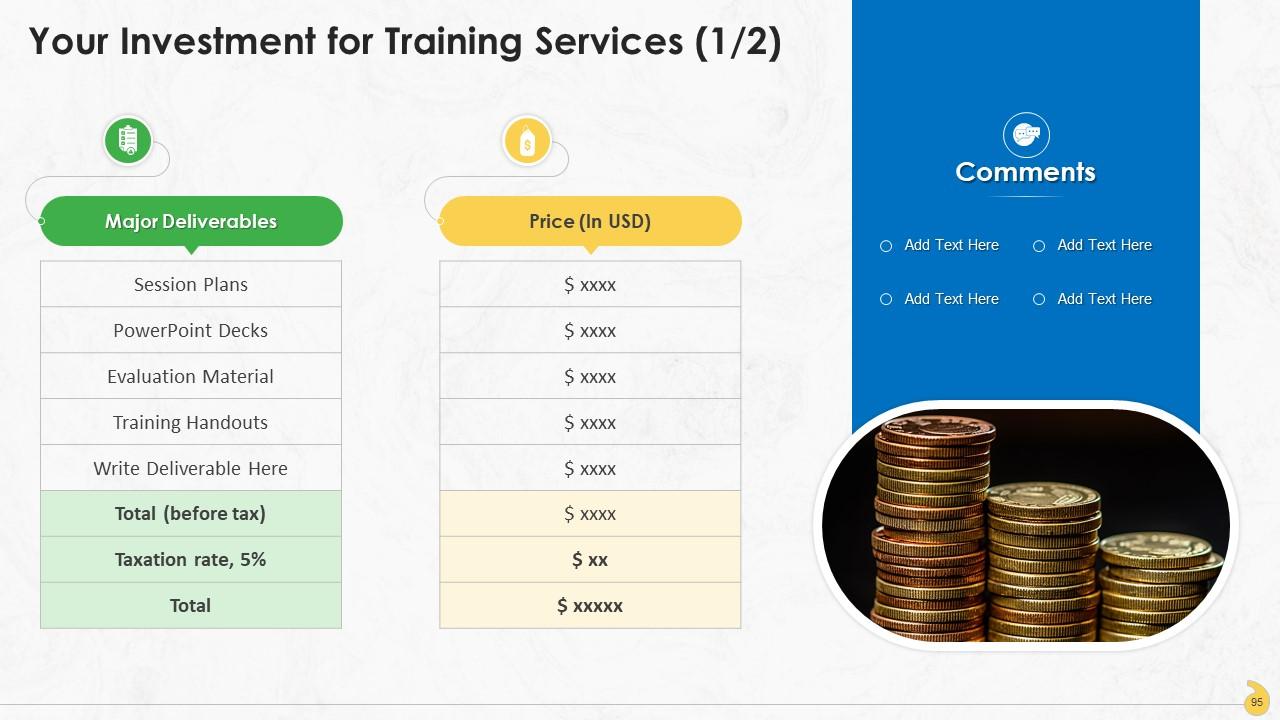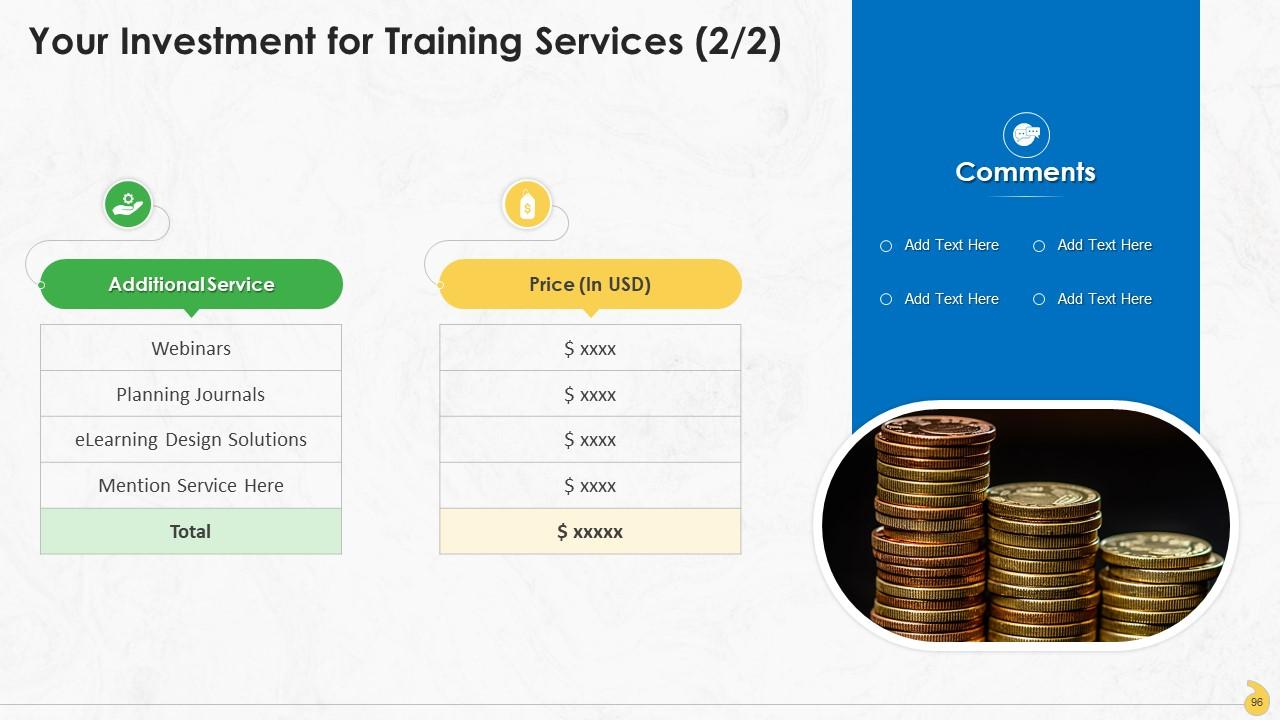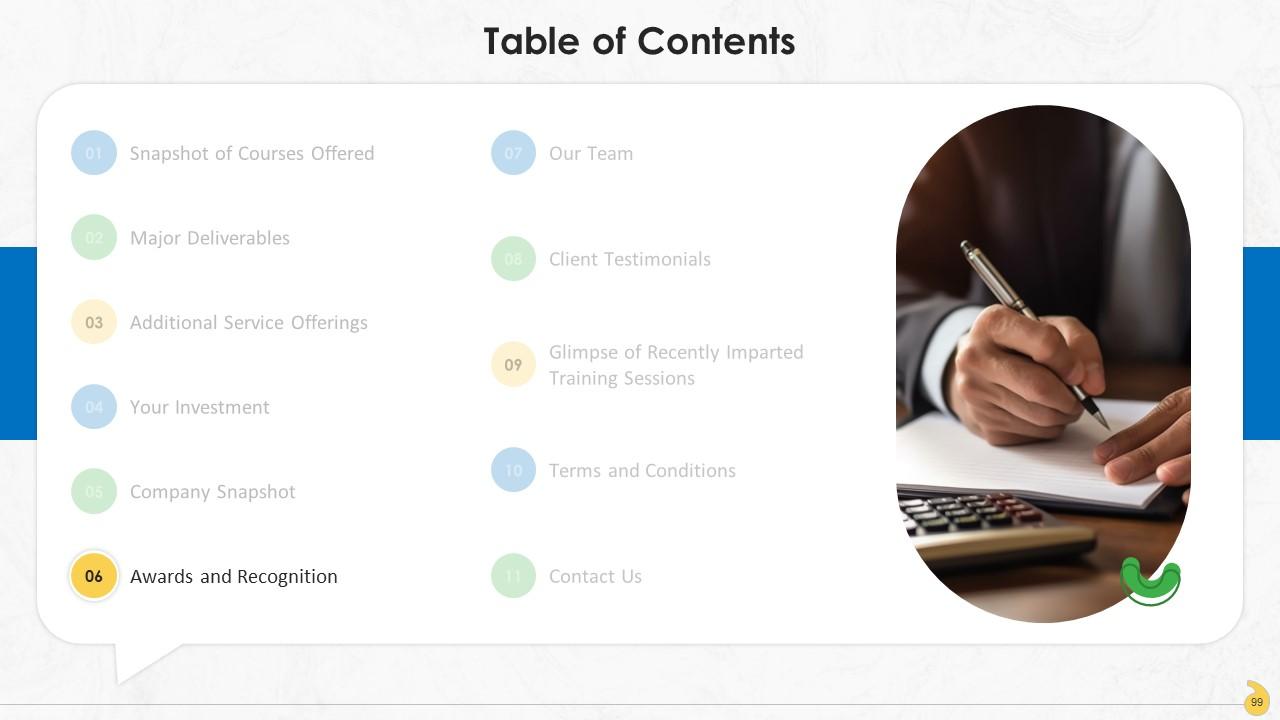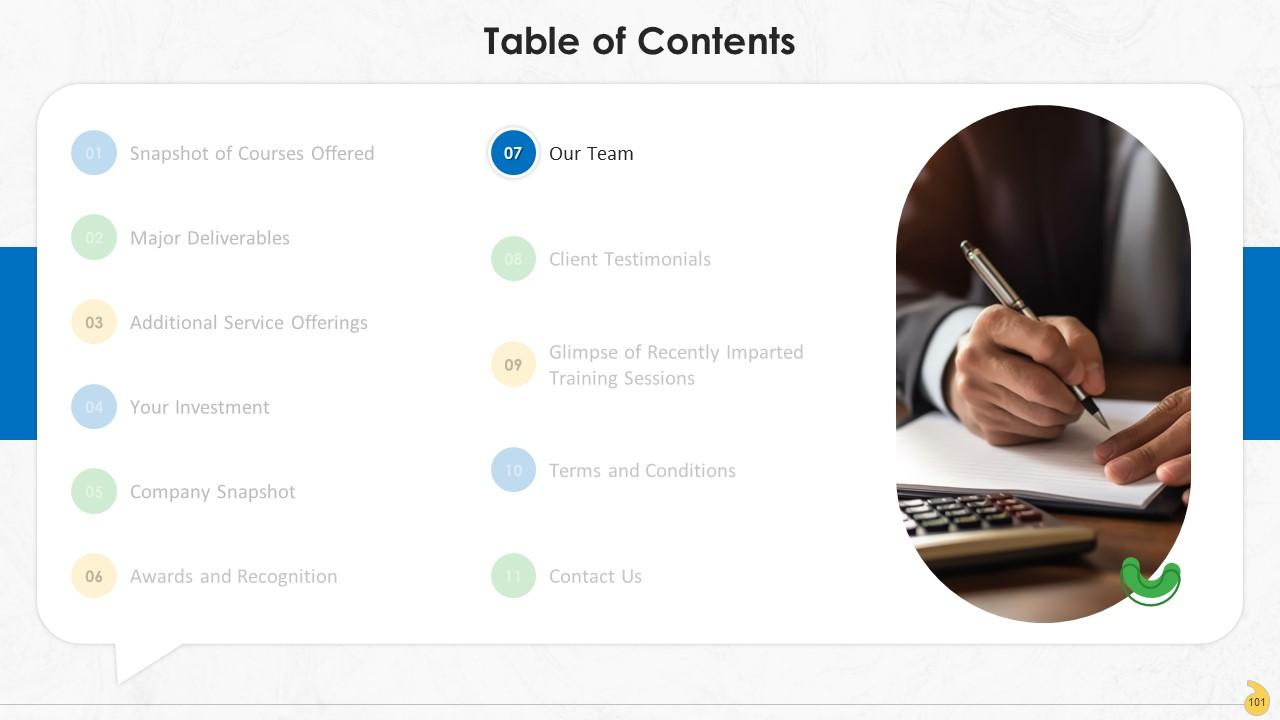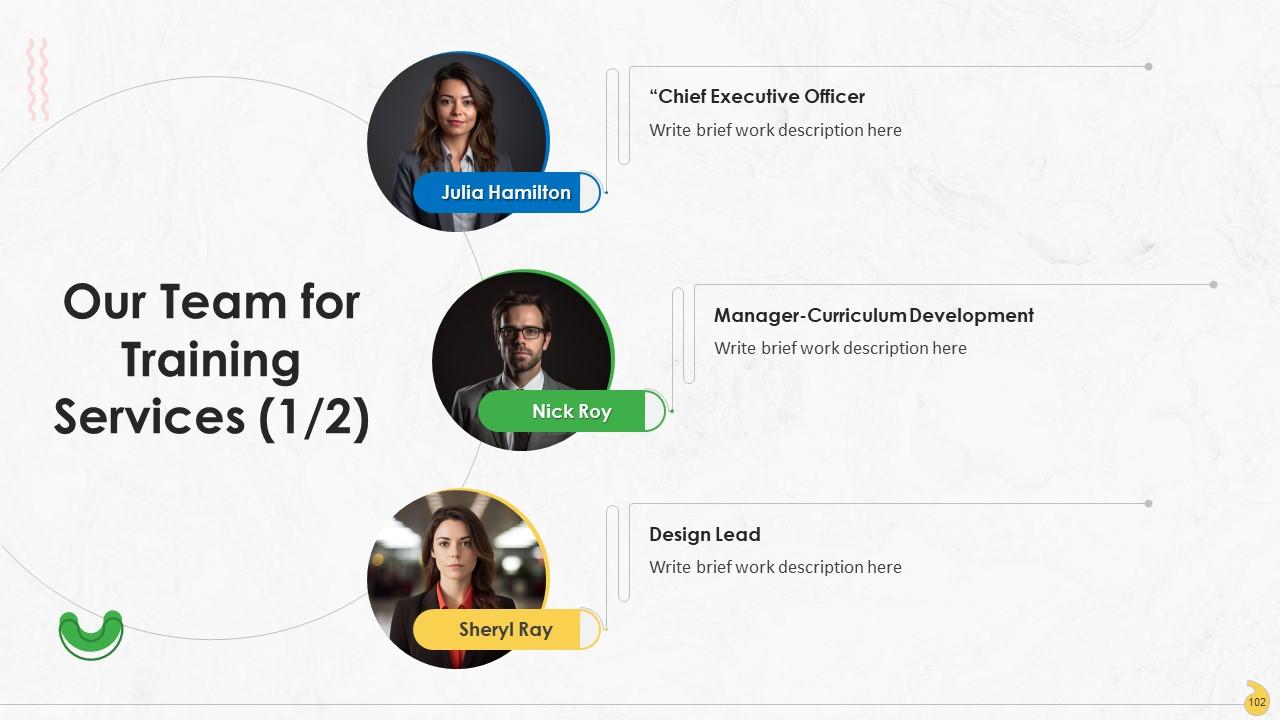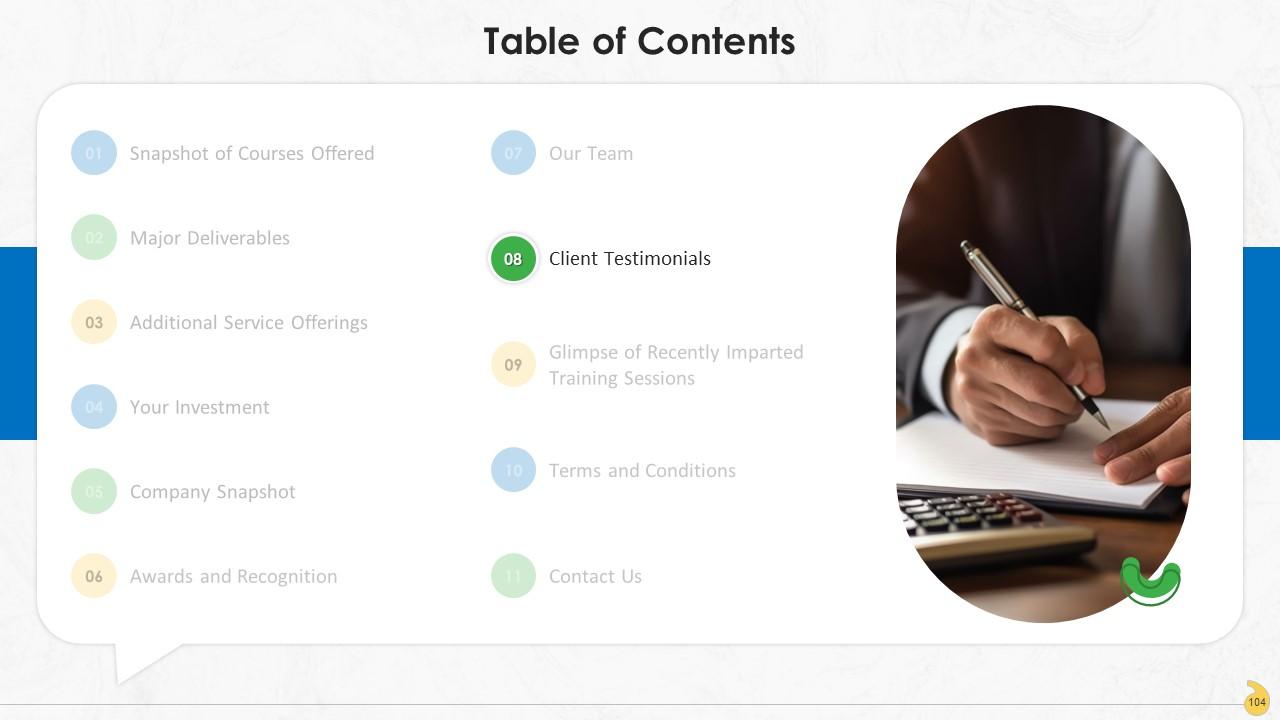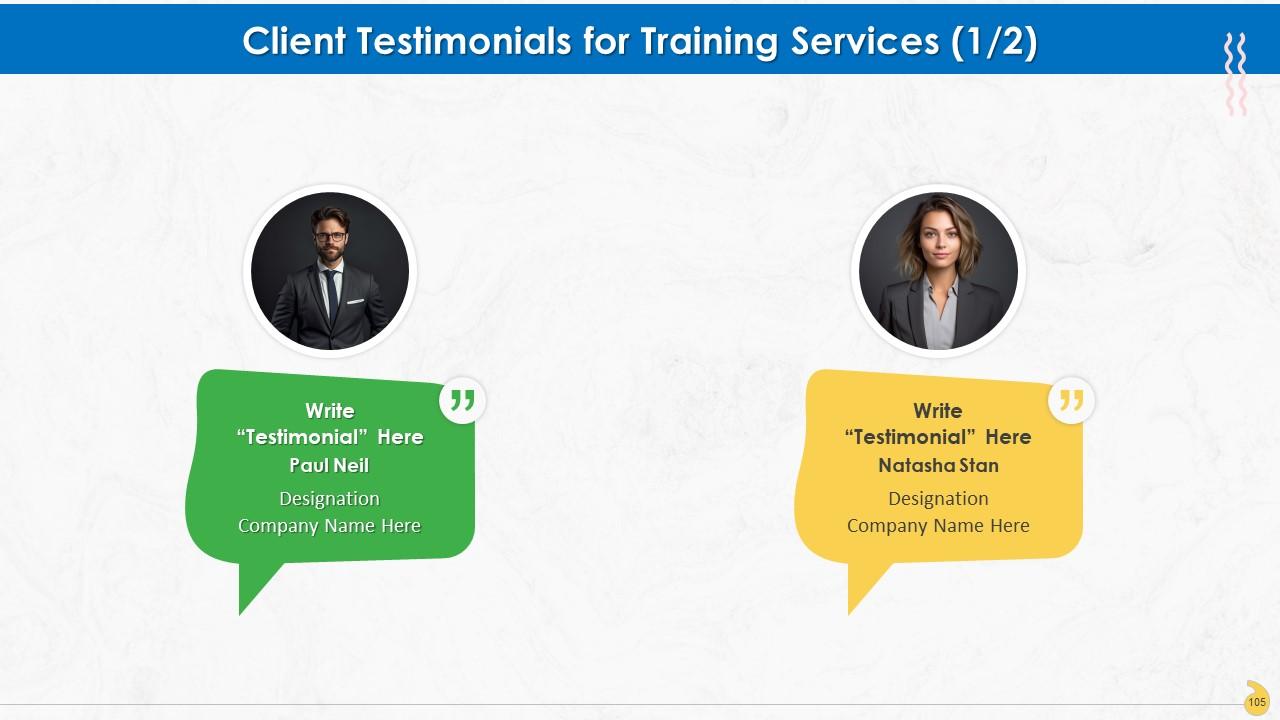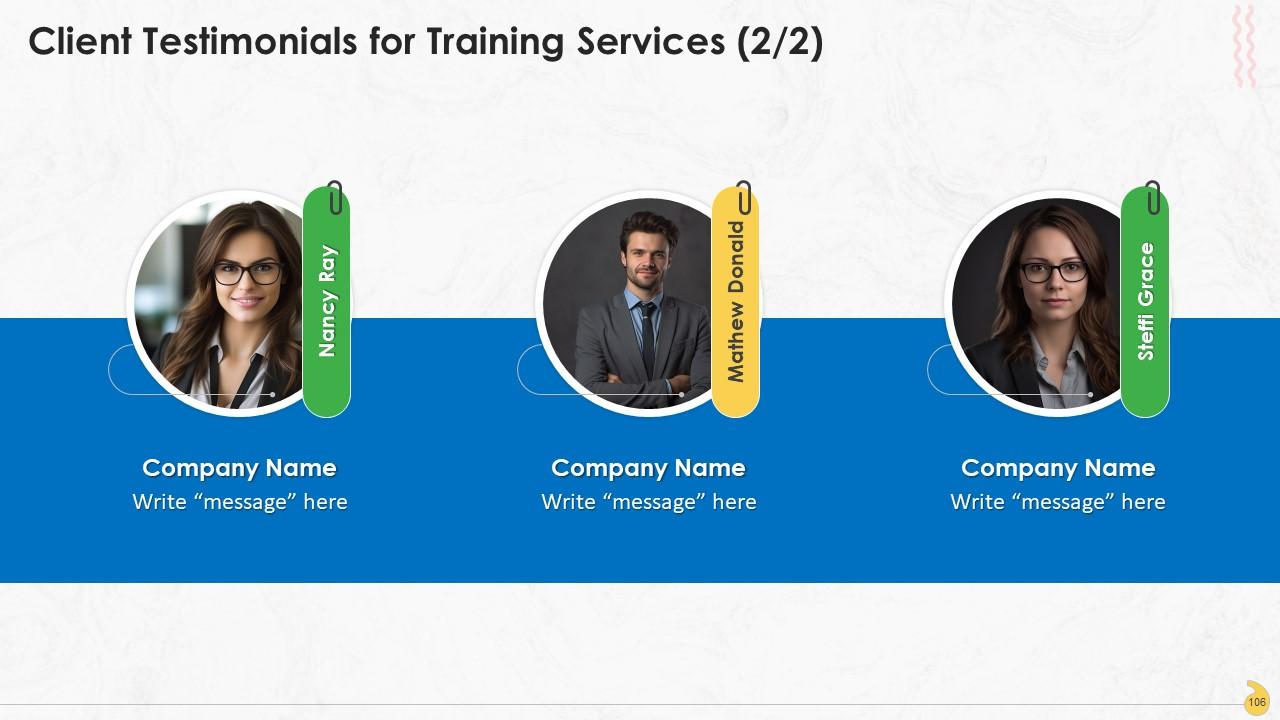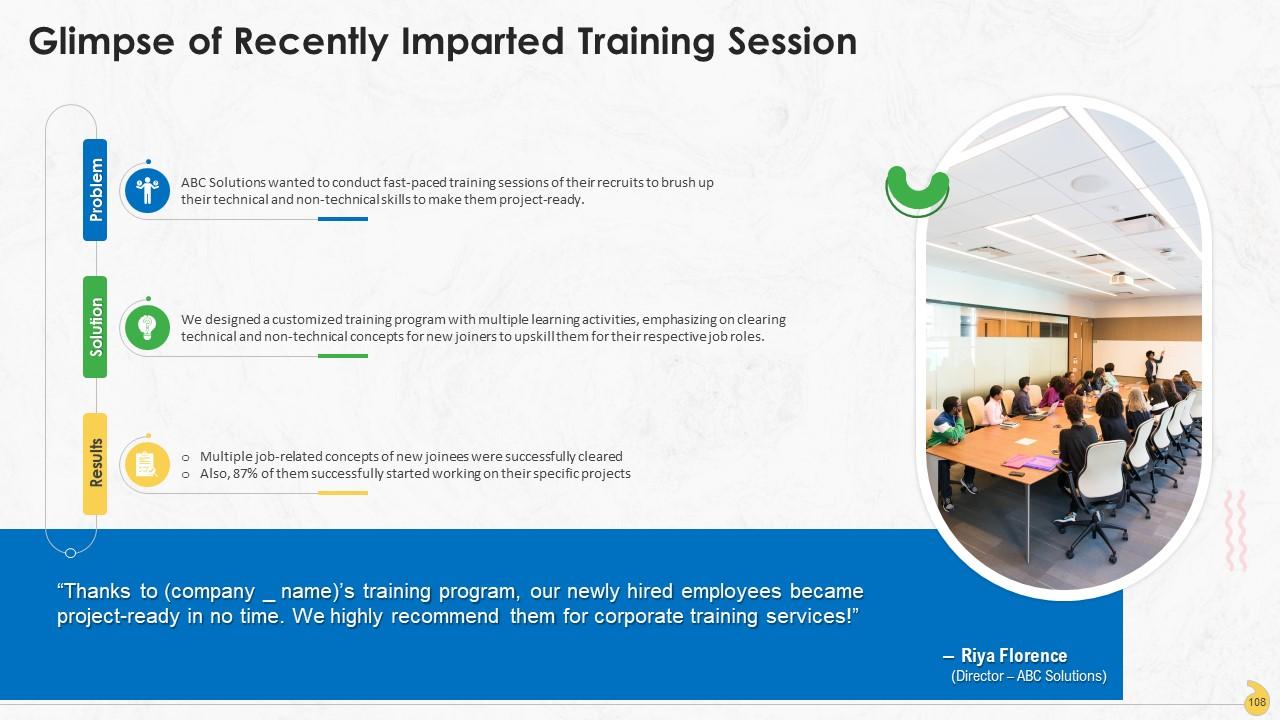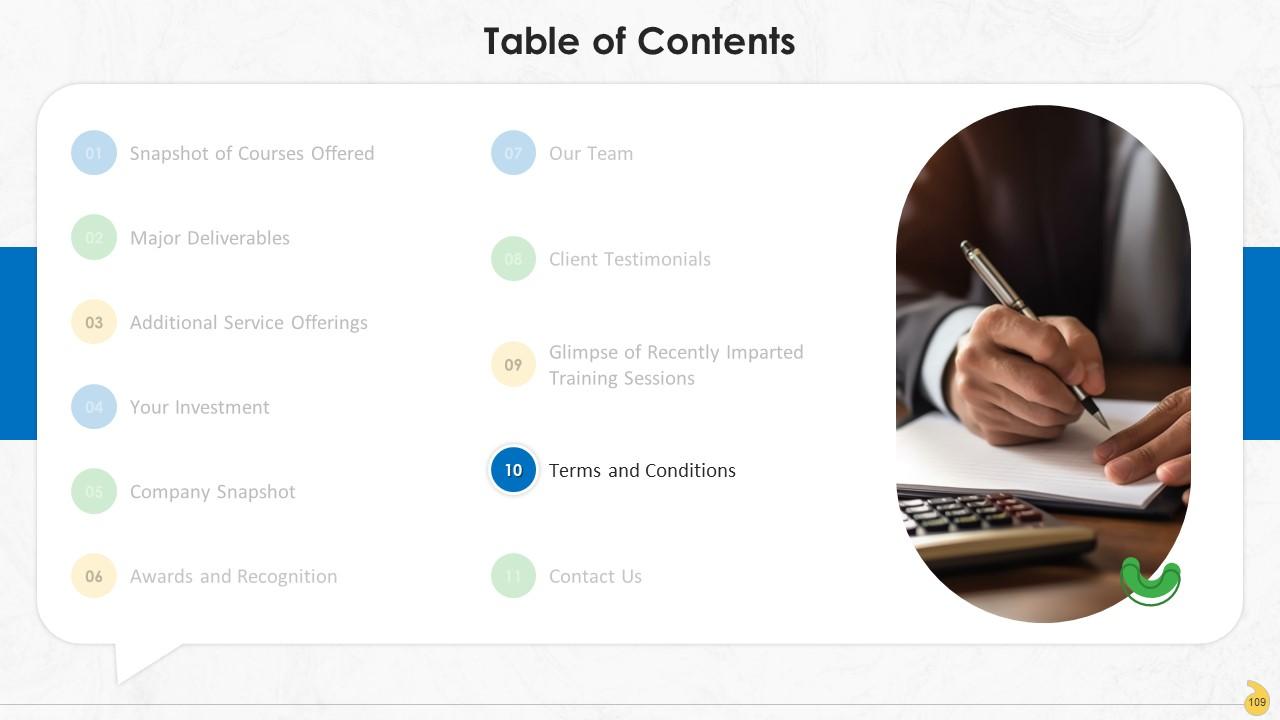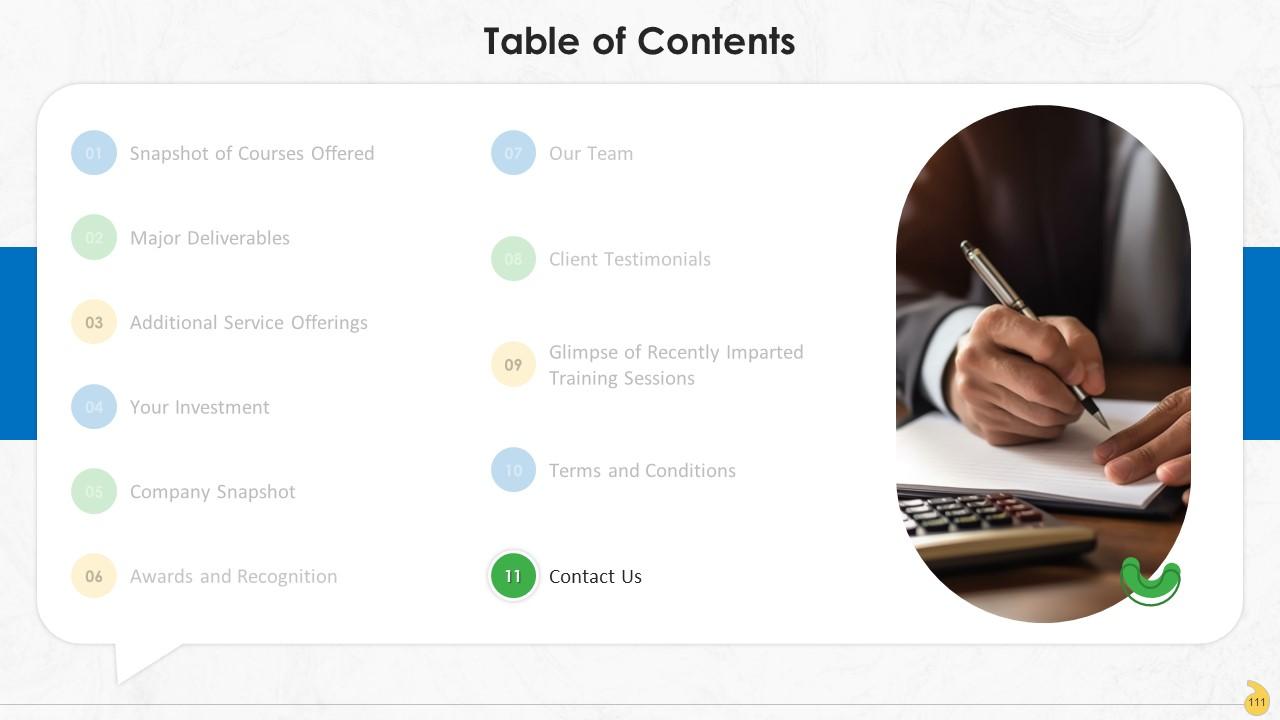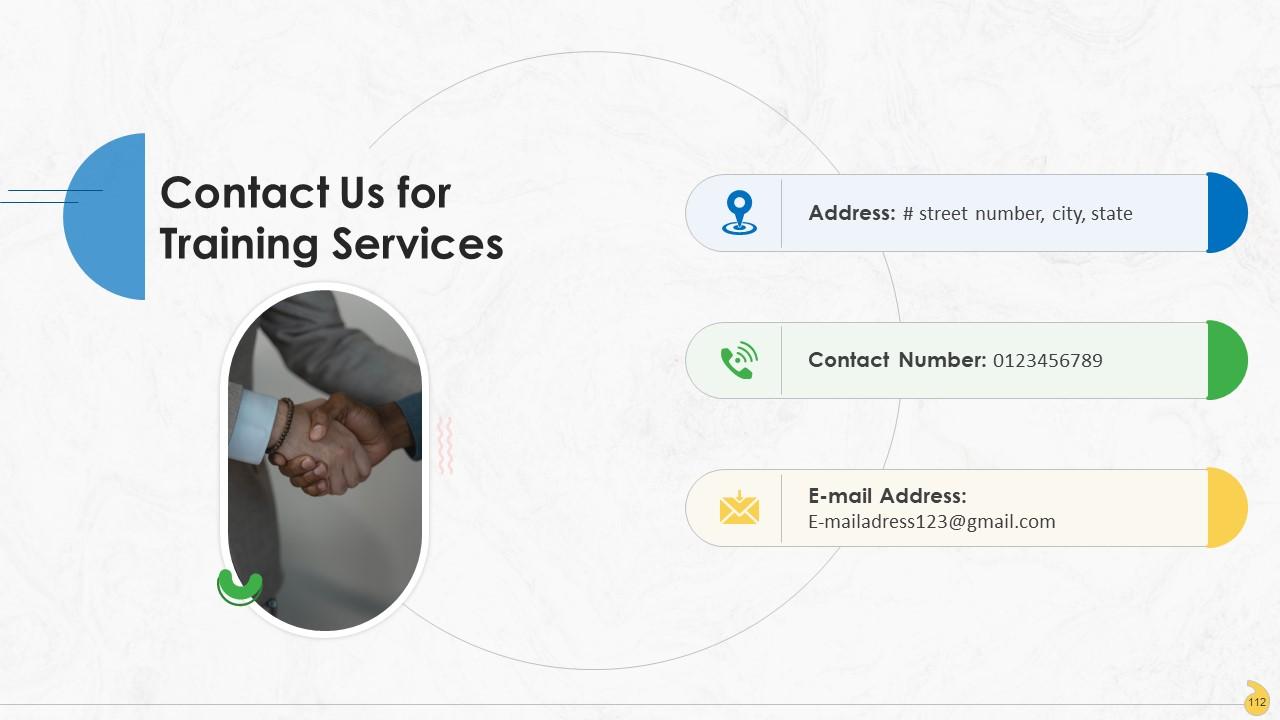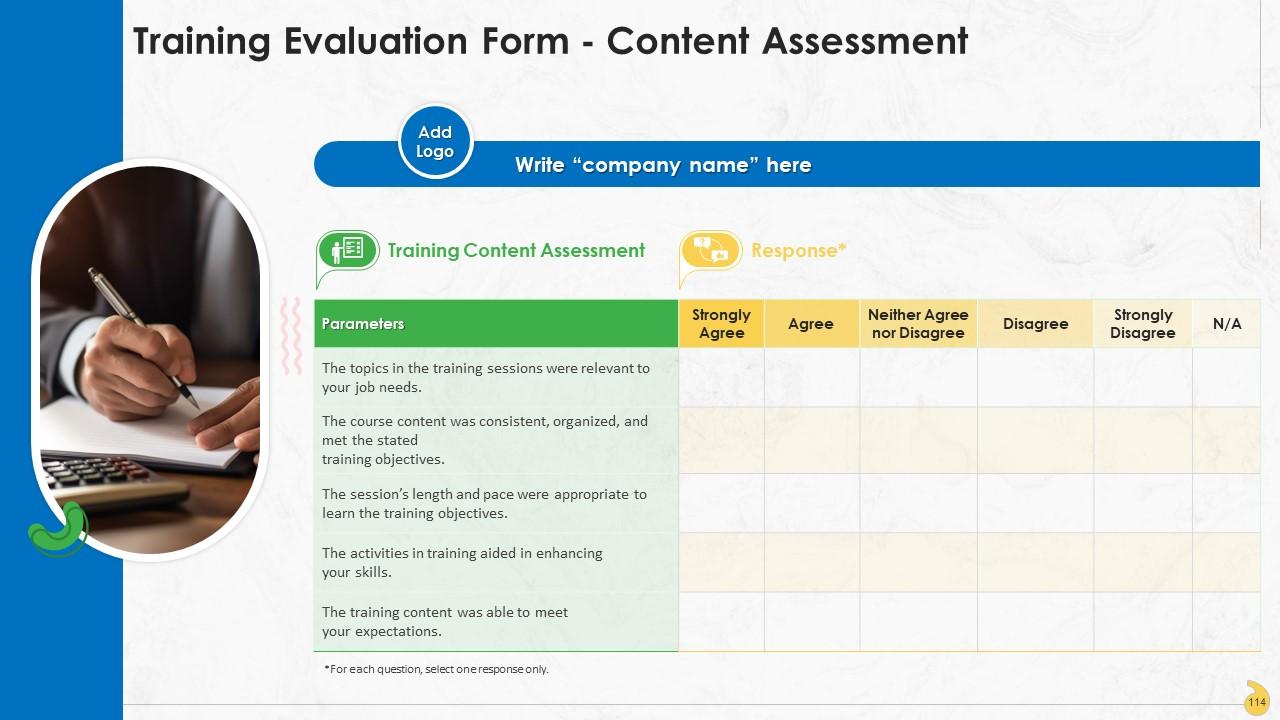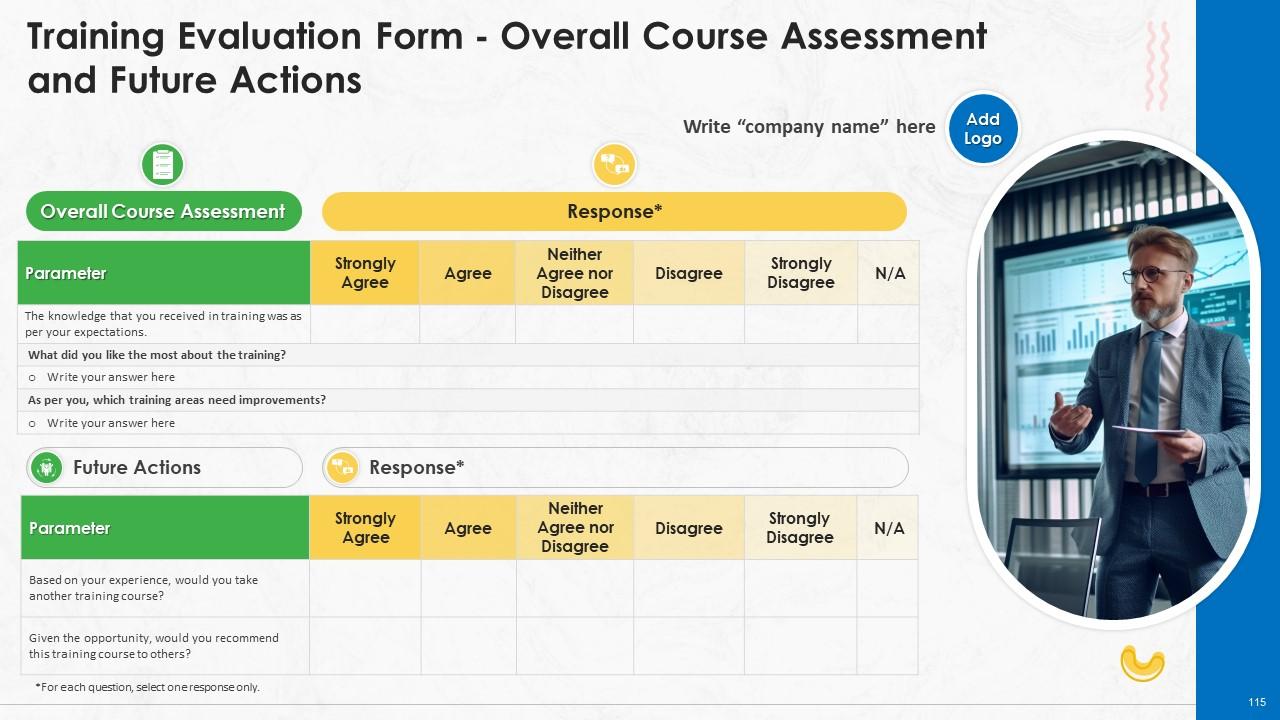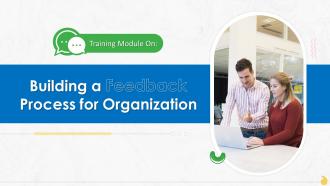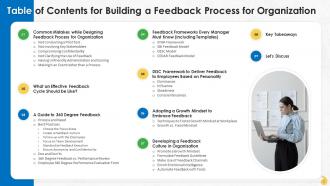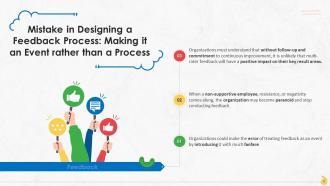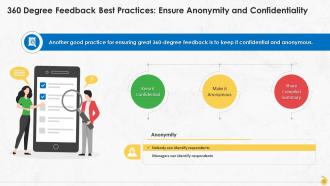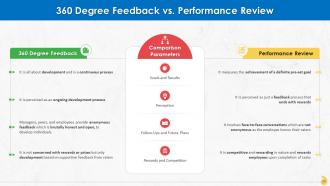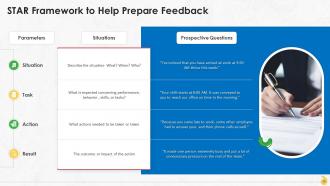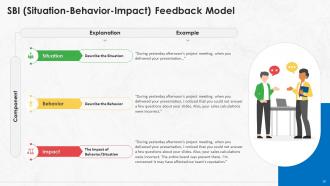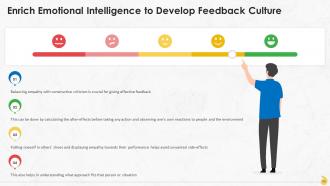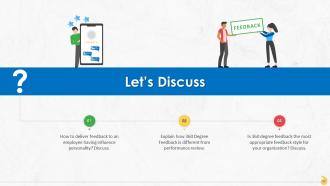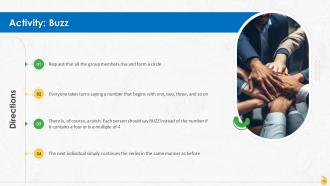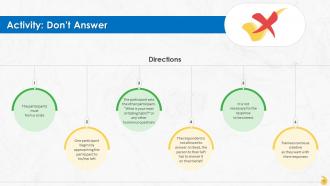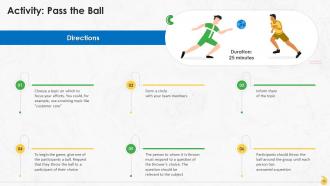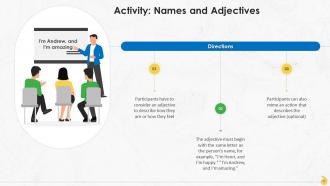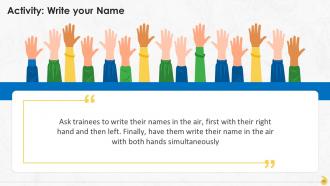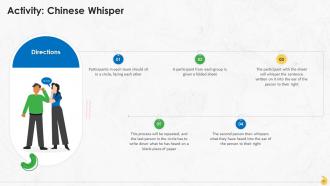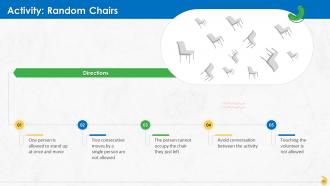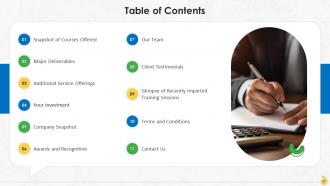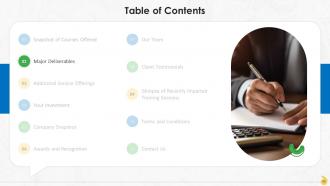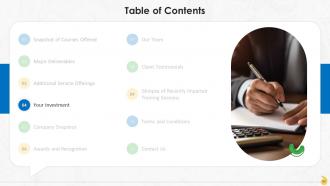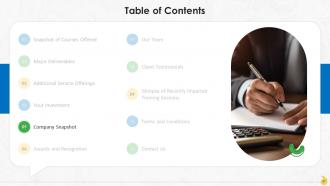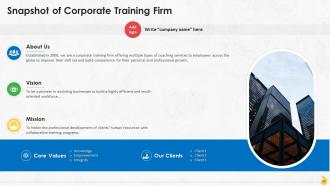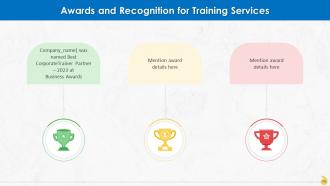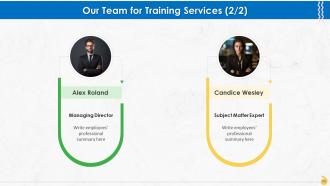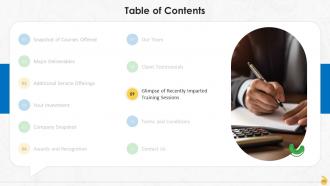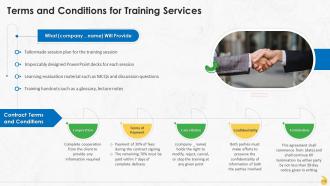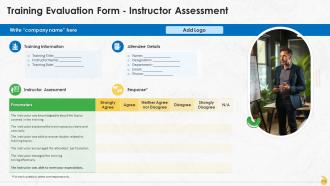Building A Feedback Process For Organization Training Ppt
This PPT Training Module on Building a Feedback Process for Organization delves into the common pitfalls of designing a feedback process and outlines the vital steps to create a constructive feedback environment. It explores the nuances of a 360-degree feedback system, including its process, needs, and best practices, and compares it with traditional performance reviews. Understand the essential feedback frameworks every manager must know, such as the STAR, SBI, DESC, and CEDAR models, and how to apply the DISC framework for tailored feedback based on employee personality types. Embrace a growth mindset with strategies to foster this approach in the workplace, leading to a more receptive and adaptive organizational culture. The PowerPoint Deck also guides the development of a robust feedback culture, emphasizing the importance of emotional intelligence, feedback guidelines, and the integration of feedback tools. It concludes with Key Takeaways and Discussion Questions, designed to engage participants in thoughtful reflection and discussion.
This PPT Training Module on Building a Feedback Process for Organization delves into the common pitfalls of designing a fee..
- Google Slides is a new FREE Presentation software from Google.
- All our content is 100% compatible with Google Slides.
- Just download our designs, and upload them to Google Slides and they will work automatically.
- Amaze your audience with SlideTeam and Google Slides.
-
Want Changes to This PPT Slide? Check out our Presentation Design Services
- WideScreen Aspect ratio is becoming a very popular format. When you download this product, the downloaded ZIP will contain this product in both standard and widescreen format.
-

- Some older products that we have may only be in standard format, but they can easily be converted to widescreen.
- To do this, please open the SlideTeam product in Powerpoint, and go to
- Design ( On the top bar) -> Page Setup -> and select "On-screen Show (16:9)” in the drop down for "Slides Sized for".
- The slide or theme will change to widescreen, and all graphics will adjust automatically. You can similarly convert our content to any other desired screen aspect ratio.
Compatible With Google Slides

Get This In WideScreen
You must be logged in to download this presentation.
PowerPoint presentation slides
Presenting Training Deck on Building a Feedback Process for Organization. This deck comprises of 57 slides. Each slide is well crafted and designed by our PowerPoint experts. This PPT presentation is thoroughly researched by the experts, and every slide consists of appropriate content. All slides are customizable. You can add or delete the content as per your need. Not just this, you can also make the required changes in the charts and graphs. Download this professionally designed business presentation, add your content and present it with confidence.
People who downloaded this PowerPoint presentation also viewed the following :
Content of this Powerpoint Presentation
Slide 3
This slide highlights mistakes that plague the designing of a feedback process in an organization. These are: Not conducting a pilot test, not involving key stakeholders, compromising confidentiality, not clarifying the use of feedback, having an unfriendly administration and scoring, and making it an event rather than a process.
Slide 4
This slide contains information about making the mistake of not conducting a pilot test while designing the feedback process. Organizations might make the mistake of suddenly shifting from the traditional way of giving feedback to the concept of upward feedback to a supervisor or manager, and collecting information from peers and staff. In some cultures, this may be considered radical an may not be accepted. Ensure the pace of change matches the culture.
Slide 5
This slide contains information about making the error of not involving key stakeholders, while designing a feedback process. Key stakeholders should be involved in things like selecting survey instruments or generating specific questions for measuring target competencies.
Slide 6
This slide contains information about making the mistake of compromising confidentiality, while designing feedback process for the organization.
Slide 7
This slide contains information about not clarifying the use of feedback which is inappropriate while designing feedback process for the organization.
Slide 8
This slide contains information about not having a friendly administration and scoring, while designing feedback process for the organization and how it turns into a mistake.
Slide 9
This slide highlights the mistake of making the feedback an event instead of a process while designing feedback process.
Slide 10
This slide represents an effective employee feedback cycle at a workplace. It begins with continuously assessing performance, communicating via dialogue and agreeing upon feedback. This is followed by reviewing performance and maintaining the feedback cycle.
Slide 11
This slide highlights the feedback cycle to be followed, while giving feedback to the employees. It consists of: Discover the problem/issue, analyze causes and consequences, create options and solutions, commit to action, and evaluate performance improvement.
Instruction Notes:
An effective employee feedback process consists of the following stages:
- Discover the Problem/Issue: The foremost step in giving effective feedback is the willingness to see shortcomings well, and define the existing problem. This should be done by self-discovery or by taking assistance from superiors at the workplace
- Analyze Causes and Consequences: The manager needs to identify the root cause of the problem and its consequences to resolve an issue. He should then build effective feedback on it by providing insights into the situation
- Create Options and Solutions: For every problem, the manager needs to identify two solutions, so that if one does not prove suitable, the other one can be sought. The help of an experienced supervisor could be taken for the same
- Commit to Action: Next, an action plan centered around the problem should be created. The manager can provide assistance to the employee to ensure correct implementation of the action plan
- Evaluate Performance Improvement: Finally, the manager should ensure the performance is reviewed and see whether the action plan really does address the problem. The employer should regularly ask questions about the inculcation of habits and deployment of techniques that signal positive movement on the desired front
Slide 12
This slide details the 360-degree feedback that can be bought into practice at the workplace. Here, managers, peers, subordinates, and others share their personal opinions regarding the employee’s performance, behavior, and professional relationships.
Slide 13
This slide showcases the process through which 360-degree feedback takes place in an organization. The steps involved in it are: Communicating about feedback, selecting raters, circulating surveys, completing questionnaires, producing reports, facilitating feedback, implementing development plan, and re-evaluating.
Instructor’s Notes:
Following are the steps involved in 360-degree feedback:
- Communicating about Feedback: Firstly, the process, purpose, and method of collecting and using 360-degree feedback should be communicated to all stakeholders. These could be the administrator, manager, team members, clients, and subordinates
- Selecting Raters: A critical part of the 360-degree feedback process, selecting raters will depend on the employee's job roles and professional relationships. Enough feedback providers should be chosen to ensure the data is relevant and comprehensive
- Circulating Surveys: The next step involves distributing the questionnaires through online/offline mode. Participants should be given instructions on starting and completing the whole feedback survey
- Completing Questionnaires: Having participants fill out and complete the review can take up to 2-4 weeks in the 360-degree feedback process. This step's duration can vary depending on the number of raters involved and the employees’ role. So, deadlines must be established to ensure all raters have completed their survey on time
- Producing Reports: Once all feedback responses are collected from the participants, a report is produced. Which could be sent directly to the participants or communicated via a one-on-one feedback session
- Facilitating Feedback: Arranging confidential feedback meetings should be emphasized on, as it ensures greater understanding of the feedback report and an opportunity to discuss areas of strength and improvement
- Implementing Development Plan: Constructing development plan for each participant during the review is the essence of 360-degree feedback. Employee would be able to identify and work on their critical areas for improvement with the help of coaching, workshops, mentoring, etc., based on the results of 360-degree feedback
- Re-evaluating: 360-degree feedback is an ongoing process rather than a one-off event. It should be communicated at the start of the process about subsequent reviews that will take place. Re-evaluating participants helps check for any changes that may have occurred, and provides an opportunity for fresh feedback
Slide 14
This slide contains information on advantages of 360 Degree feedback that benefits the organization. It builds self-awareness about strengths and weaknesses, ascertains training gaps, gives insight into employees’ attitude, improves efficiency and work relationships, increases transparency within the organization, and aids in tapping unrealized potential.
Instructor's Notes:
The benefits of 360-degree feedback are:
- Builds Self-Awareness about Strengths and Weaknesses: 360 Degree feedback brings to light what opinions others (managers, peers, subordinates) have about an employee. It benefits the organization and guides employees about their weak and strong areas to help them improve their skill-set
- Ascertains Training Gaps: Since an employee gets an overall view of their personality, they can identify lack of a skill or competency, which can be worked upon with the help of a training program. Skill gaps are a roadblock for professional growth, and training programs will help bridge those gaps
- Gives Insight into Employees’ Attitude: The employer can ascertain an employee's role in the organization with the help of 360 Degree feedback. It helps seniors understand how the employee fits in with the team and peers, in addition to the role and responsibilities assigned to them
- Improves Efficiency & Work Relationships: Feedback from counterparts helps build trust and meet mutual goals. 360-degree feedback encourages intra-team bonding and increases team coordination by aligning employees' developmental goals with the organization's
- Increases Transparency within the Organization: 360-Degree feedback provides increased transparency that develops trust between members, which further leads to enhanced decision-making, betterment of performance, and thus, revenue increment
- Aids in Tapping Unrealized Potential: Well-executed 360-Degree feedback builds a strong foundation and knowledge pool for an organization to assess its recruiting policies and management team structure. Organizations can tap into unrealized potential and idea generation with the help of their employees
Slide 15
This slide lists best practices to ensure that 360-degree feedback takes place efficiently. These are: Choose the focus areas, create a feedback culture, follow-up with employees, focus on team development, standardize feedback execution, and ensure anonymity and confidentiality.
Instructor’s Notes:
Following are the best practices to ensure efficiency in 360-degree feedback:
- Choose the Focus Areas: A 360-degree feedback will be able to provide useful insights only if it is centered around an objective. The organization needs to identify and prioritize feedback objectives, such as the need to motivate employees or to improve internal communication
- Create a Feedback Culture: A 360-degree feedback culture should be nurtured as it ensures that the employees and employers can learn new things and improve their skills
- Follow-Up with the Employees: Only gathering 360-degree feedback and not acting upon it just wastes organizational resources. Feedback should be shared with employees, and an action plan should be developed and implemented with follow-up. This aids in comparing the new and old performances
- Focus on Team Development: Multi-rater feedback ensures that employees can be held accountable as they can share their input on each coworker's performance. When the focus is kept on the team's overall performance, communication across the department will improve, and everybody works towards a unified goal
- Standardize Feedback Execution: The ideal time for conducting 360-degree feedback could differ from organization to organization (quarterly or bi-annually), and the organization should identify the optimal period for doing so. More frequent and a long gap in between makes it difficult to track growth and progress, and its effectiveness will be lost
- Ensure Anonymity and Confidentiality: Employees will provide honest feedback, only if they believe it will be kept private. This would, in turn, affect the whole review process of 360-degree feedback. Thus, anonymity and confidentiality are a requisite
Slide 16
This slide contains information about choosing focus areas based on their importance to deliver a good 360 Degree feedback at the workplace. Focus areas could be such: the need to motivate employees, ensure workplace diversity, and improve internal communication.
Slide 17
This slide contains information about creating a feedback culture, where all the employees can give feedback to others, ones irrespective of their job roles at the workplace.
Slide 18
This slide contains information about following up with the employees that aids in delivering 360-degree feedback effectively. The aim is to ensure that employees work in accordance with an improvement plan.
Slide 19
This slide contains information about questions a manager can ask in one-on-one follow up meetings from employees on the 360 Degree feedback.
Slide 20
This slide highlights the practice of focusing on team development in making 360-degree feedback effective in the organization. It will ensure more reliable feedback from a broader range of sources, reduce discrimination and risk of bias, create enhanced trust and accountability in the team, and correct unfavorable or undesired behavior.
Instructor’s Notes:
Focusing on team ensures:
- More reliable feedback from a broader range of sources: An employee's co-worker interacts differently with them than their manager and knows more about their work ethic and attitude. This is brought up well with the use of 360 Degree feedback
- Reduced discrimination and risk of bias: 360 Degree feedback involves reviews from many individuals across job roles according to their performance and work ethics. This diminishes discrimination based on age, race, gender, etc. that might be prevailing in the organization
- Creating trust and accountability in the team: Implementing multi-rater feedback makes the team or department managers more accountable to each other as they provide input on each member's contribution. It improves inter-departmental communication and coordination
Slide 21
This slide contains information about standardizing feedback evaluation in order to make best out of 360-degree feedback. The ideal time for conducting 360-degree feedback could differ from organization to organization (quarterly or bi-annually), and the organization should identify the optimal period for doing so.
Slide 22
This slide showcases how anonymity and confidentiality aids in providing a good 360-degree feedback at the workplace.
Instructor’s Notes:
Following are the positives of ensuring anonymity and confidentiality:
- Keep it Confidential: The fact that feedback that employees share with their manager or peer will remain confidential, ensures accurate and honest responses
- Make it Anonymous: Additionally, the response rate would also increase when everyone knows their names won't be disclosed
- Share Complied Summary: Only a compiled summary of the feedback report should be shared with the concerned individual
Slide 23
This slide lists dos and don’ts to be followed while implementing 360-degree feedback at the workplace.
Slide 24
This slide highlights the differences between 360-degree feedback and performance review at the. The basis of comparison is: goals and results, perception, follow-ups and future plans, and rewards and competition.
Slide 25
This slide represents a 360-degree performance evaluation form. The performance evaluation KPIs used are work attitude, professional knowledge, and ability to work. The raters are managers, subordinates and peers.
Slide 26
This slide contains information about the STAR framework of constructing effective feedback where S describes the situation, T describes the task, A describes the action and R stands for result.
Slide 27
This slide represents the feedback form to be used for STAR framework consisting of the activity concerned, the task or situation involved, the action displayed, and its cascading consequences.
Slide 28
This slide highlights the SBI (Situation-Behavior-Impact) framework for giving feedback to an employee. The components of model are: Describe the situation, explain the behavior, and finally elaborate on the impact of that particular behavior /situation.
Slide 29
This slide contains the template for giving feedback to an employee using the SBI model. Its constituents are: describe the situation, explain the behavior, and finally the impact of that particular behavior /situation.
Slide 30
This slide highlights the DESC framework for giving feedback that comprises D (Describe), E (Express), S (Specify), and C(Consequences).
Instructor’s Notes:
Following are the tips to apply the DESC framework at your workplace:
- Describe the Situation: Describe the situation completely and as objectively as possible
- Express your Feelings: Express what you feel regarding the situation/behavior by making use of “I” instead of “You”. Starting the conversation with “You” makes the person defensive, and they will probably not listen to you
- Specify the Outcome you Would Prefer to Happen: Describe the outcome or behavior you would want to take place
- List the Consequences: Specify the positive and negative consequences of the situation
Slide 31
This slide contains information about the CEDAR model for giving feedback. It begins with context, examples, diagnosis, actions, and review.
Slide 32
This slide highlights the first step of CEDAR feedback model, which is context. The manager can use this to explain the situation for which feedback is to be given to the employee.
Slide 33
This slide highlights the second step of CEDAR feedback model, which is examples. The manager can use this to explain the situation with the help of an example to the employee.
Slide 34
This slide highlights the third step of CEDAR feedback model, which is diagnosis. The manager can use this to diagnose the situation by understanding the concerned issues and actions taken by the employee.
Slide 35
This slide represents the fourth step of CEDAR model that is actions. This can be used to make the employee learn about their undesirable actions and create an action plan for future.
Slide 36
This slide represents the fifth and final step of CEDAR model that is review. This can be used to follow up with the employee and help them internalize new and desirable behavior at the workplace.
Slide 37
This slide contains information about ascertaining the DISC (Dominance, Influence, Steadiness, Conscientiousness) personality of employees to deliver effective feedback.
Instructor’s Notes:
To determine the DISC personality of employees at the workplace:
Understand the employee's behaviors – their tendencies, tone of voice, expressions, and choice of words – and respond to these questions.
- Question 1:
What's the person's pace? Is the person more fast-paced & straightforward or more moderate pace & reflective?
- Question 2:
How "agreeable" is the person? Is the person more questioning & curious, or more warm and accepting?
Combine the answers to these questions and refer to the model to determine the employee's DISC tendencies
Slide 38
This slide provides information about the D (Dominance) personality of an employee at the workplace. Such an employee tends to be direct, decisive, and dominant.
Slide 39
This slide showcases recommendations to be followed while interacting with an employee possessing the D personality.
Slide 40
This slide provides information about the I or Influence style of personality at the workplace. An employee possessing such a personality is accepting, people focused, empathizing, agreeable, and receptive.
Slide 41
This slide showcases the methodology to be followed while interacting with an I personality employee.
Slide 42
This slide provides information about the S or Steadiness style of personality at the workplace. An employee possessing such a personality is thoughtful, moderate paced, methodical, patient, and trustworthy.
Slide 43
This slide showcases the tips to be followed while interacting with an employee with Steady (S) personality.
Slide 44
This slide provides information about the C or Conscientiousness style of personality at the workplace. An employee possessing such a personality is questioning, logic-focused, objective- driven, skeptical, and challenging.
Slide 45
This slide showcases the methodology to be followed while interacting with an employee possessing the C personality.
Slide 46
This slide contains information about adopting a growth mindset in ensuring that workplace feedback is effective. The vital elements required for it are: Presence of humility, acknowledge the importance of learning, and acknowledge mistakes and learn from them.
Instructor’s Notes:
Following are the vital elements for adopting a growth mindset at workplace:
- Presence of Humility: This ideology believes that employees require humility to embrace the feedback in the form of learning strategies and not as negative commentary or meant to put them down
- Acknowledge the Importance of Learning: Rather than trying to seem intelligent and confident at all times, employees must realize that they have much to learn
- Acknowledge Mistakes and Learn from Them: With a growth mindset, the employee sees mistakes as opportunities to learn and improvise rather than lack of capabilities
Slide 47
This slide represents measures to be adopted in order to nurture a growth mindset at the workplace. These are: Tie performance evaluation to learning instead of results, categorize both successes and failures as learning opportunities, encourage employees to open up, invest in upskilling and reskilling employees, and encourage coaching and cross-domain learning.
Instructor’s Notes:
Following are the techniques to develop a growth mindset at workplace:
- Tie Performance Evaluation to Learning Instead of Results: The traditional performance measures have relied upon parameters like the number of units sold or projects completed on time for benchmarking employees against each other. Organizations should ditch these methods and evaluate employees based on their growth and development. Business must focus on setting goals that relate more to improving employees' skills than just their output
- Categorize Both Successes and Failures as Learning Opportunities: As nobody likes to fail, stigmatizing failure or shaming employees when they fail in projects lowers their confidence and make them wary of sharing ideas. Leaders should encourage a growth mindset by embracing failures and treating them as a source of practical opportunity
- Encourage Employees to Open Up: Managers with a rigid mindset turn to only a few employees to propose new plans and ideas, which should not be the case. They should adopt a growth mindset and be open to hearing others' perspectives, with the understanding that questions are essential to growth
- Invest in Upskilling and Reskilling the Employees: Rather than assuming employees are only suited to specific roles, savvy managers with growth mindset understand that employees are capable and intelligent. These managers invest in reskilling and upskilling employees with the help of in-house training or external programs. It indicates that the organization believes in its employees' potential, thus further promoting a growth mindset
- Encourage Coaching and Cross-Domain Learning: Organizations with a growth mindset believe that an employee's full potential may or may not take time to get noticed. Also, they know that investing time and energy into employees with enthusiasm reaps significant benefits. Managers should consider providing one-on-one coaching, and cross-domain learning (collaborating with other teams)
Slide 48
This slide tabulates differences between a fixed and a growth mindset at the workplace.
Slide 49
This slide showcases scenarios depicting a growth and fixed mindset at workplace.
Slide 50
This slide lists techniques that foster a feedback culture at the workplace which are: Promote a growth mindset, formulate feedback guidelines, make use of feedback channels, enrich emotional intelligence and automate feedback with tools.
Slide 51
This slide contains information about fostering a growth mindset at workplace by making room for employees’ improvement.
Slide 52
This slide contains information about devising feedback guidelines after due consideration of goals and objectives of feedback, the frequency of giving and taking it, the employees that should be giving and receiving feedback. Organizations also need to be mindful of the channels and the process of carrying out the feedback.
Slide 53
This slide contains information on using feedback channels in order to build this culture at the workplace. These channels could be: Written feedback, online surveys, productivity applications, and face-to-face interactions.
Slide 54
This slide contains information about enhancing emotional intelligence at the part of manager so that any unwanted reactions can be avoided. Also, it helps in detecting what approach fits that person or situation.
Slide 55
This slide contains information about systematizing feedback with tools. It involves replacing traditional techniques with software to cultivate a feedback culture in the organization.
Slide 56
This slide highlights the key takeaways from the session on building a feedback process for organization. The trainer can use these to highlight essential learnings from the session.
Slide 69 to 84
These slides contain energizer activities to engage the audience of the training session
Slide 85 to 112
These slides contain a training proposal covering what the company providing corporate training can accomplish for the client.
Slide 113 to 115
These slides include a training evaluation form for instructor, content and course assessment.
Building A Feedback Process For Organization Training Ppt with all 124 slides:
Use our Building A Feedback Process For Organization Training Ppt to effectively help you save your valuable time. They are readymade to fit into any presentation structure.
-
Stunning collection! With a wide variety of options available, I was able to find a perfect slide for my presentation. Thank you, SlideTeam!
-
“Ample and amazing variety of templates available, really helpful for making professional PPT for day to day workings.”




